SIM PUBLISHING
Home
Publications
Artwork
News
Links
About
HISTORY MOMENTS
All text, photography and artwork is COPYRIGHT by GARY SIM unless noted otherwise.
April 25 2025: VANCOUVER CRICKETERS MEMORIAL

I noticed this carved wood memorial plaque for the first time while on an early morning
walk to Brockton Point. It is attached to the cricket clubhouse adjacent to the cricket
playing fields. The names are hard to read, so I have listed them below, in the same
order as they are carved into the wood panel.
J. Clouthier
D. Hood
W. Maitland
R. Slee
W. Tudhope
C.A.B. Wallace
S. Rose
T.D. Shellshear |
R.M. Read
R.R. Macfarlane
M.C. Mackenzie
J.F. Blair
P. Cocks
G. Coles
E. Dunnell
R. Turner |
R. McGregor
Bud Ohara
G. Ohara
A. Salt
E.G.K. Bullen
H. Bardon
M. Crehan
C. McG. Fernie |
R.C. Meredith
A.L. Robinson
D. Loughnan
P. Kendall
M. Collins
C. Sveinson
M. Callaway
D. Hasken |
|
April 5 2025: PIONEER'S CAIRN

I noticed this plaque while walking through the rose garden in Stanley Park. It was laid in
1993 to commemorate the centenary of the Vancouver Pioneer's Association, founded in 1893.
This is slightly misleading, since it was actually the Vancouver Old-Timer's Club that was
founded in 1893. The Pioneer's Association was founded around 1920 and the members of the
Old-Timer's Club were included in its membership.
April 17 2024: BROCKTON POINT LIFEBOAT STATION
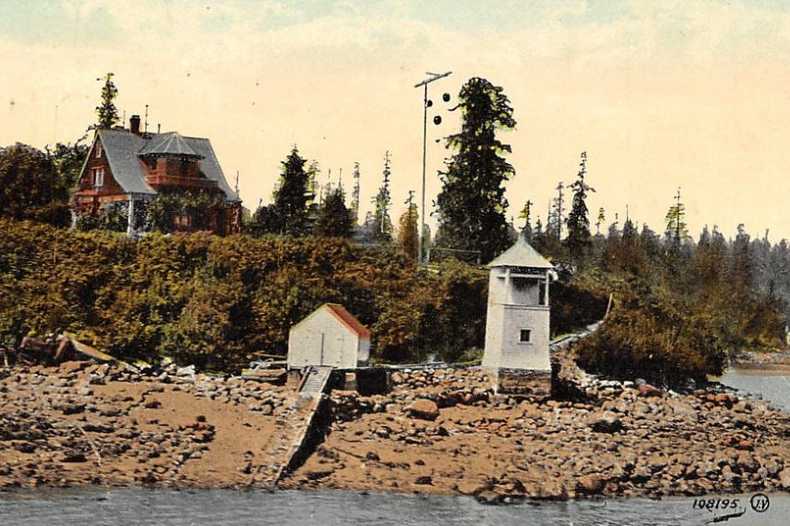
J. Valentine photograph (cropped postcard), original lighthouse and lifeboat station
The lifeboat ramp in this picture may or may not be the same one in the next two pictures
It is tricky trying to put together the history of Brockton Point. The lighthouse shown in
the postcard image above originally had a shack attached to the back of it that was the
actual home of the lighthouse keeper. Eventually the house seen in the postcard was built,
and the keeper's gardens became well-known in Vancouver. When a road was built around the
point it seems the house was moved back from the seawall, but the gardens were lost, and
eventually the house was demolished in the 1950s after operations of the lighthouse
were automated.
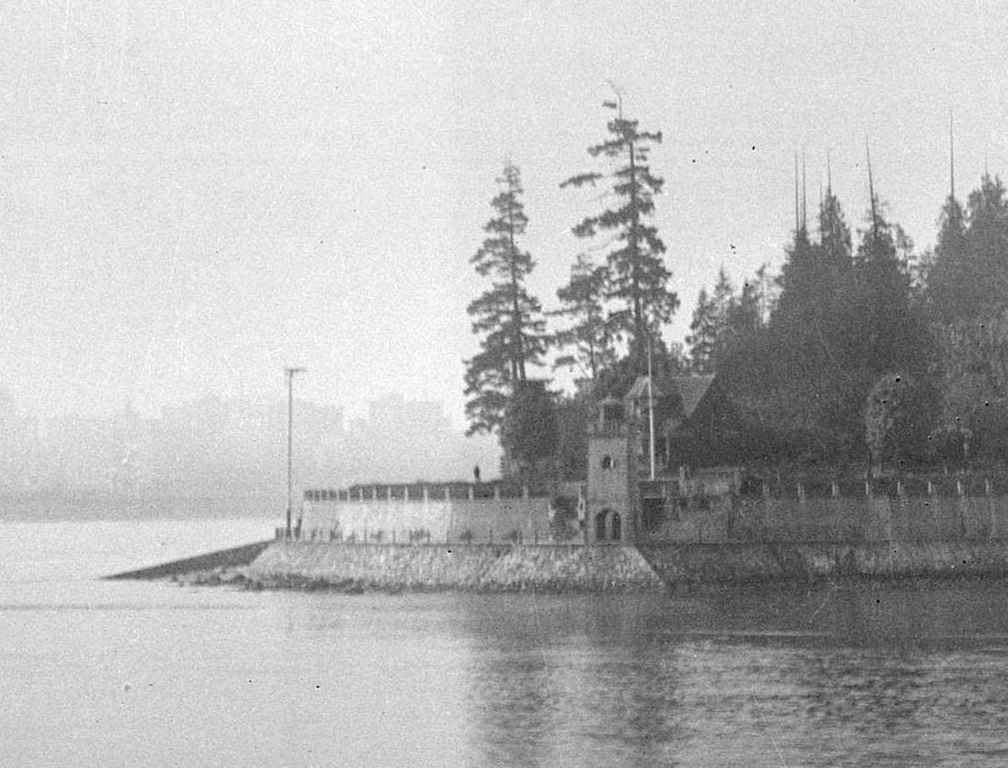
Walter Frost photograph (cropped), current Brockton Point lighthouse
Photo courtesy City of Vancouver Archives
Although I started out wandering around Brockton Point, Stanley Park, trying to find the
former location of the Brockton Point Observatory, I got side-tracked into seeing what
was left of the lifeboat station. The ramp for launching the lifeboat is visible in the photographs
above and below. I missed a really low tide a couple of weeks ago, and decided to take
advantage of a 6 foot low tide on a nice morning to go have a look.
The actual ramp, built from rocks mortared together, has been almost completely destroyed
over the years by tides and waves. Surprisingly, from one vantage point on the seawall,
a straight line of rocks is visible, the north face of the former ramp. To the north of
that three lengths of steel rails are lying on the beach, semi-exposed by the tide.
There is no sign of the actual lifeboat station. The rounded observation station is where it
would have been, and it is doubtful that much would remain after its construction.
On another visit, April 25 2025, the tide was even lower and the full length of the old steel
rails were visible. I paced the length of one of them, it was 39 feet, the standard length of
a half rail. There were enough pieces of rails visible that it was clear the entire length of
the ramp would have been well over 39 feet, possibly 78 feet. The rocks that remain as part of
the ramp were still cemented together. The rails would have been about 60 or 80 pound rail, in
other words a three-foot long piece of the rail would weigh that much when new.
The tide was low enough that I decided to get down to the beach for a closer look, although the
nearest stone stairway was hundreds of feet away. Walking along the beach to get to the rails
was interesting ... there were hundreds of bugs running around, they looked like giant earwigs,
the larger ones were up to 2 inches long! I've never seen that kind of bug on a beach before,
and wouldn't be at all surprised if they are an invasive species that came off a freighter.
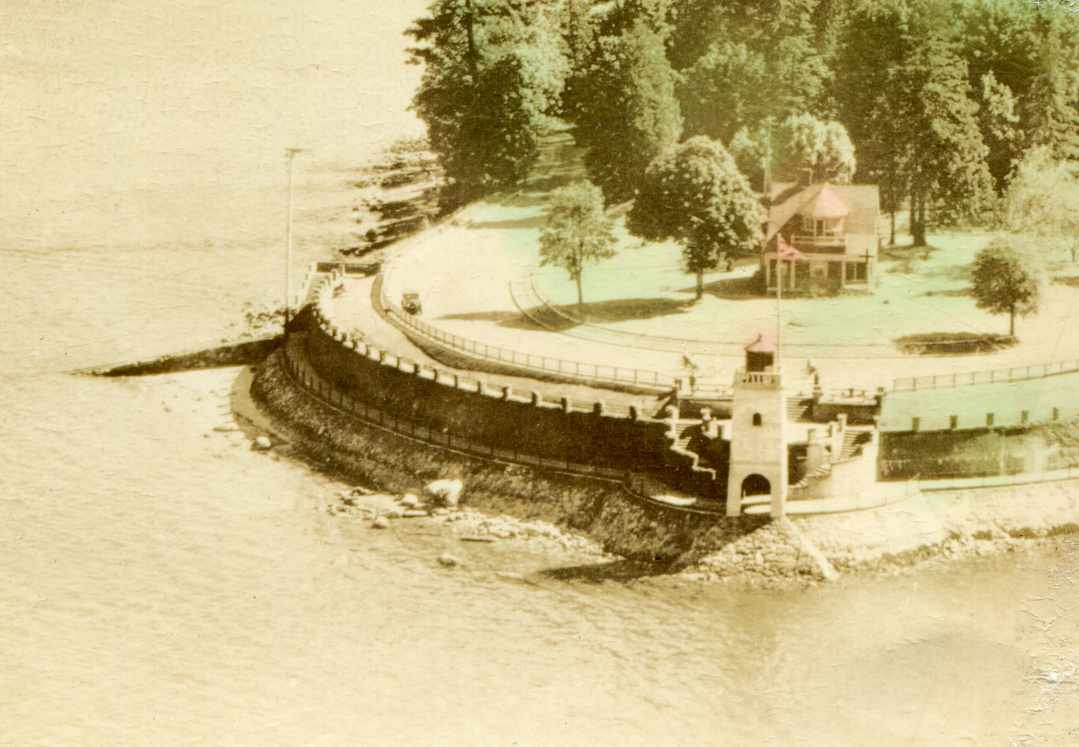
Photograph (cropped) dated between 1939 and 1949. Lifeboat ramp visible on left with 2 rails
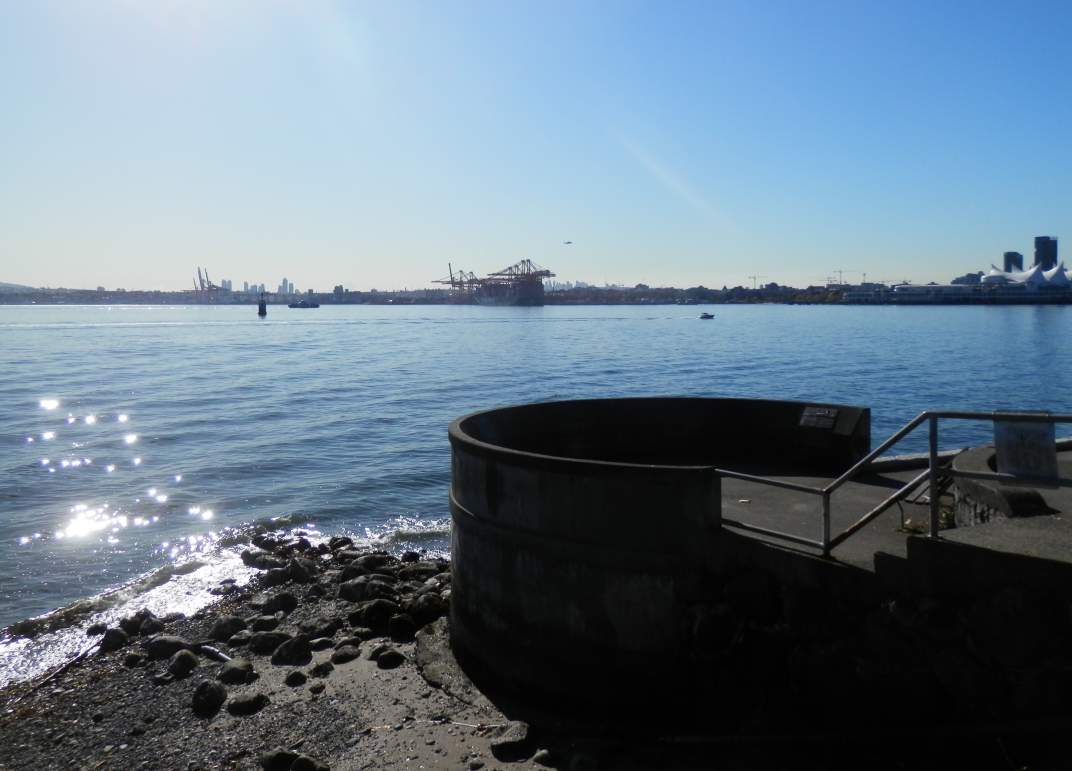
Observation station, former location of lifeboat station. Part of ramp remains, one rail visible lower left
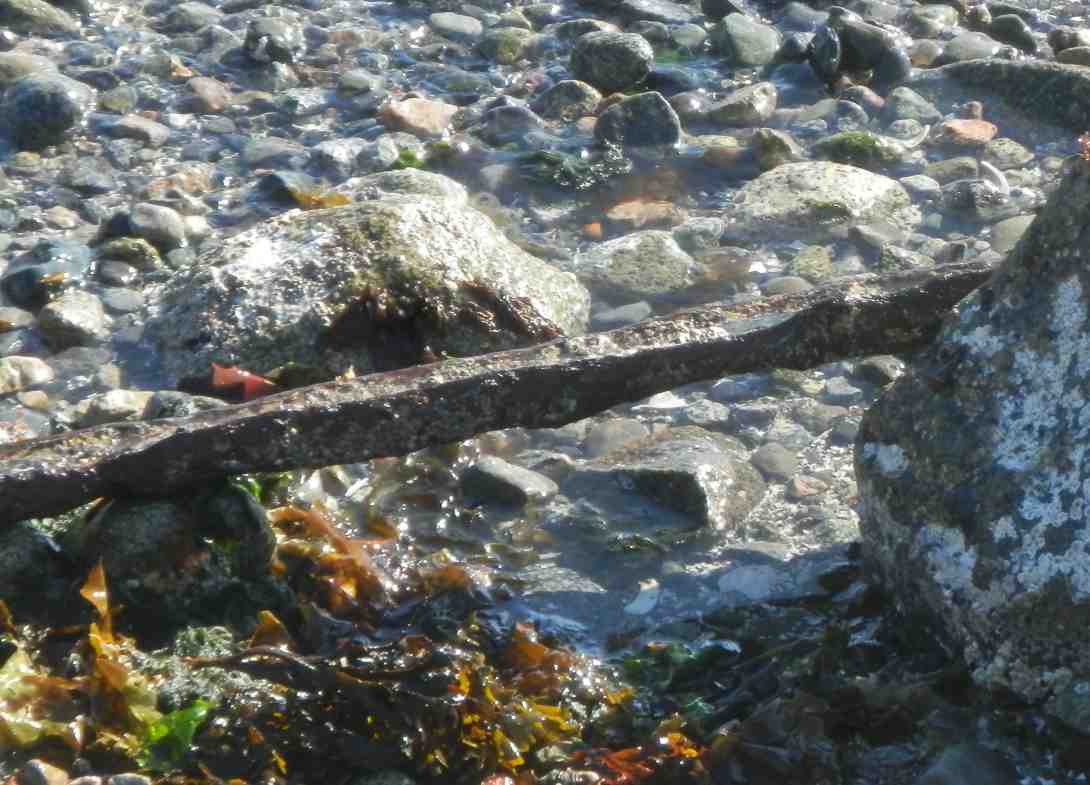
Rail lying on its side partially above water at 6 foot low tide

The north face of the lifeboat launching ramp is the only part still identifiable, parallel to the right of the white line
(a lower tide might reveal more of the ramp in better condition)
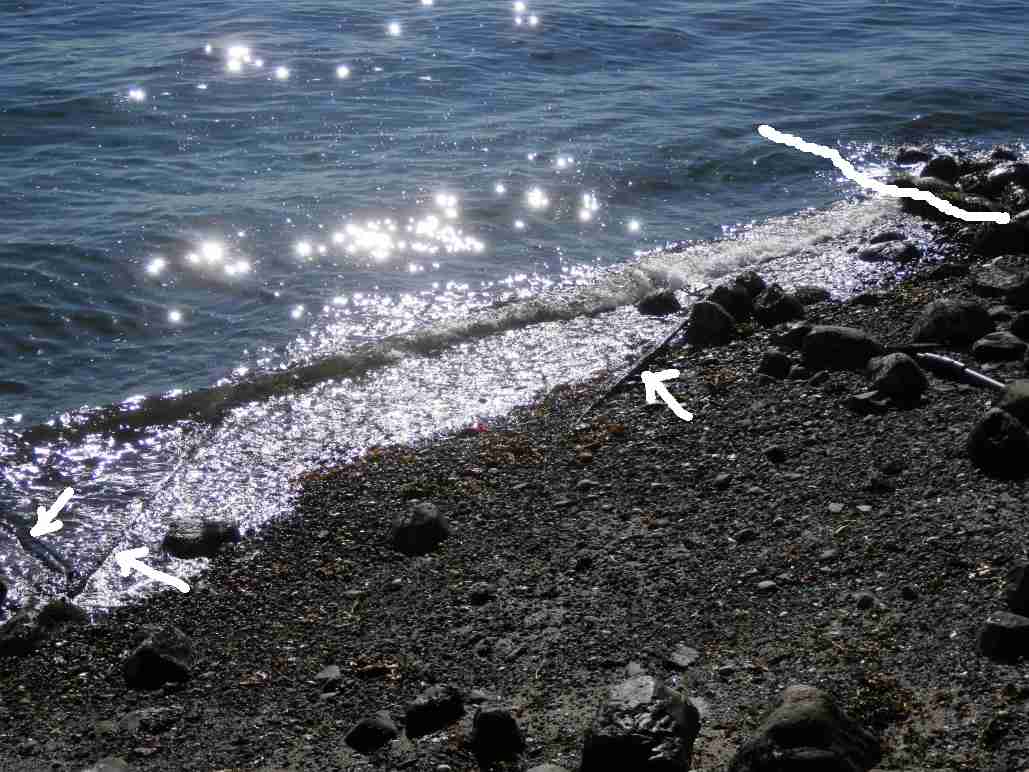
3 rails noted with arrows, line of launching ramp with white line
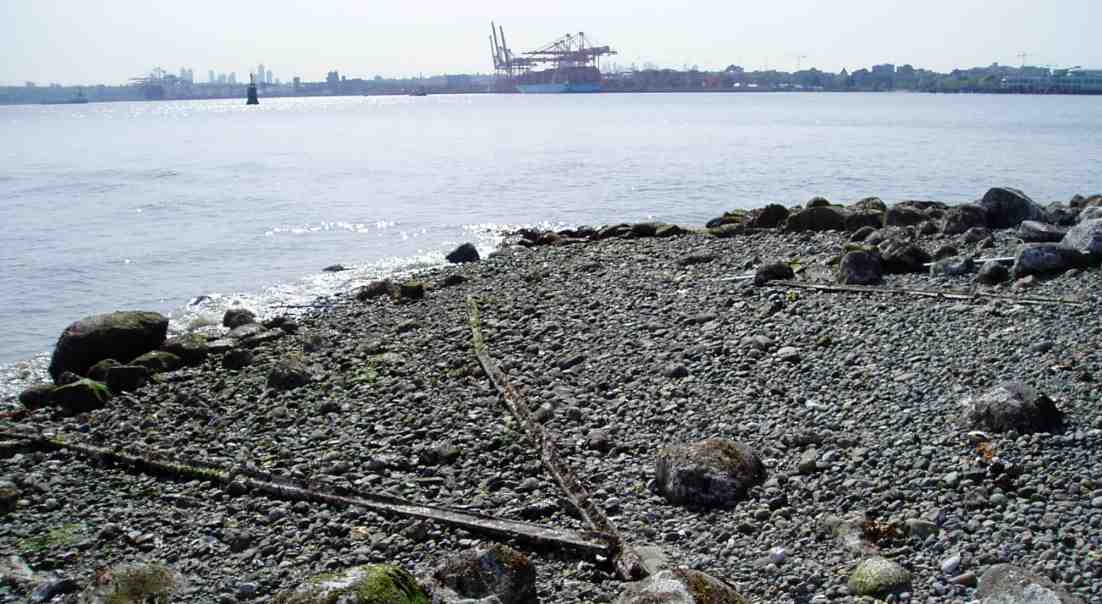
3 rails seen at low tide April 25 2025, line of ramp beyond
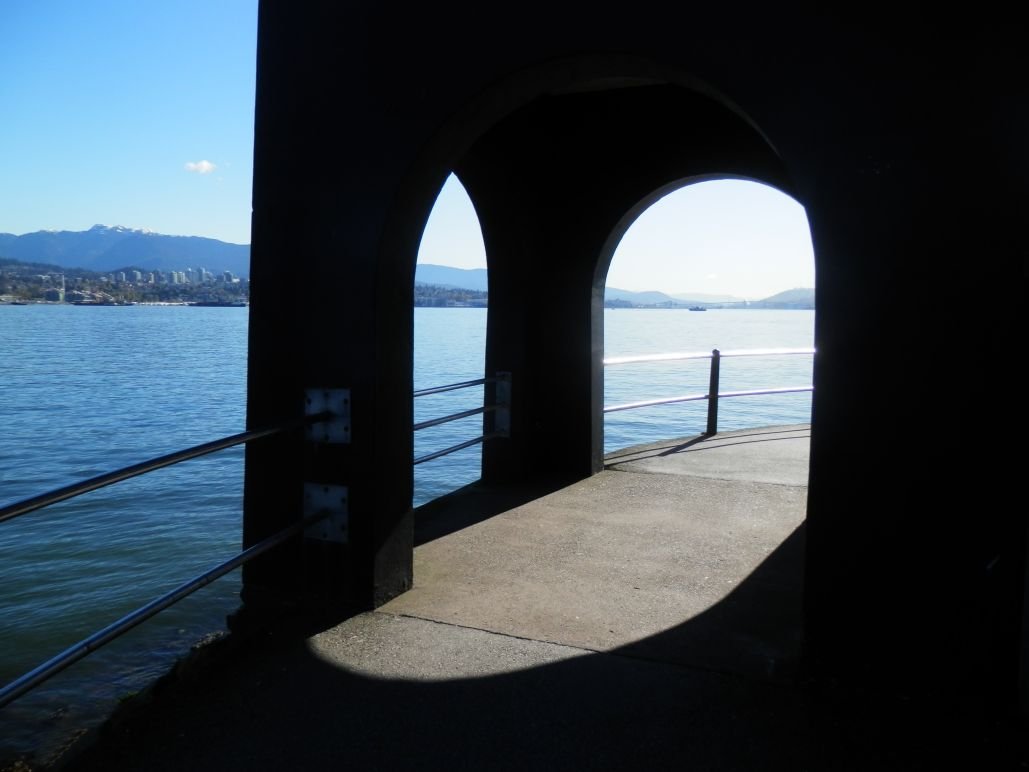
Under the Brockton Point lighthouse on a very nice spring morning
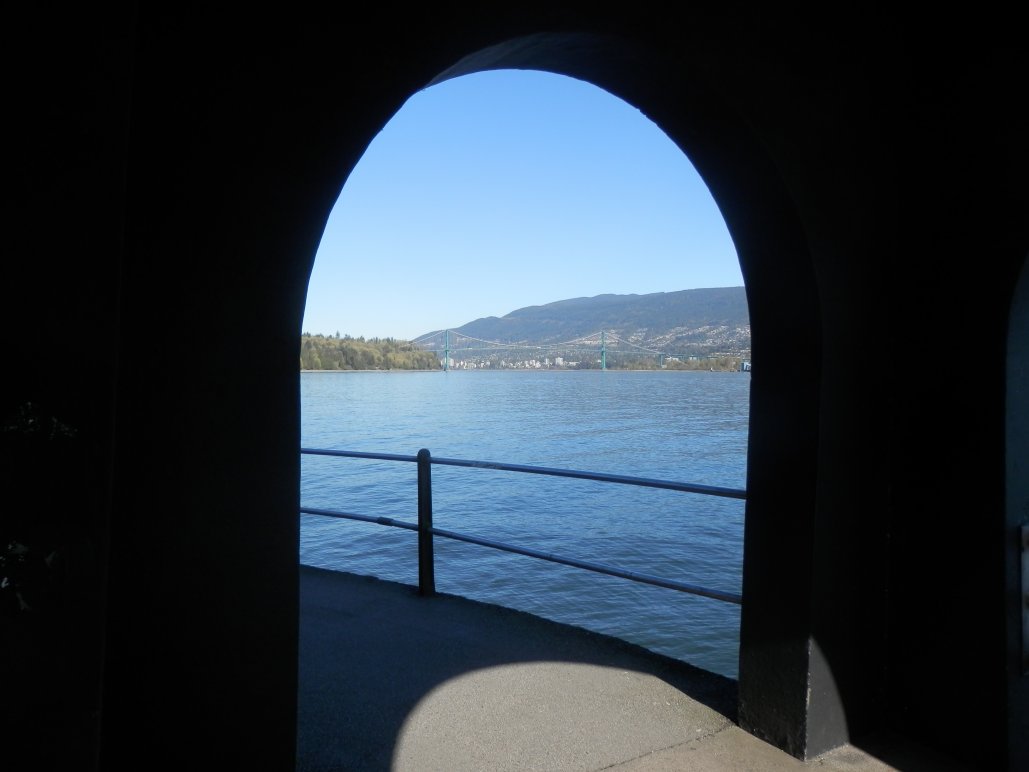
Under the Brockton Point lighthouse
July 6 2023: AIR FORCE GARDEN OF REMEMBRANCE
This collection of memorial plaques and stone markers is in Stanley Park, rather
obscurely tucked away in the forest north of the rose garden. I visited the
memorial garden in the summer of 2023, and photographed as many of the markers
as I could find. Some have almost completely disappeared into the ground, others,
like the Polish Air Force marker, have been kept up by someone. I thought that it
was quite touching to have these memorials to the fallen flyers of past wars.
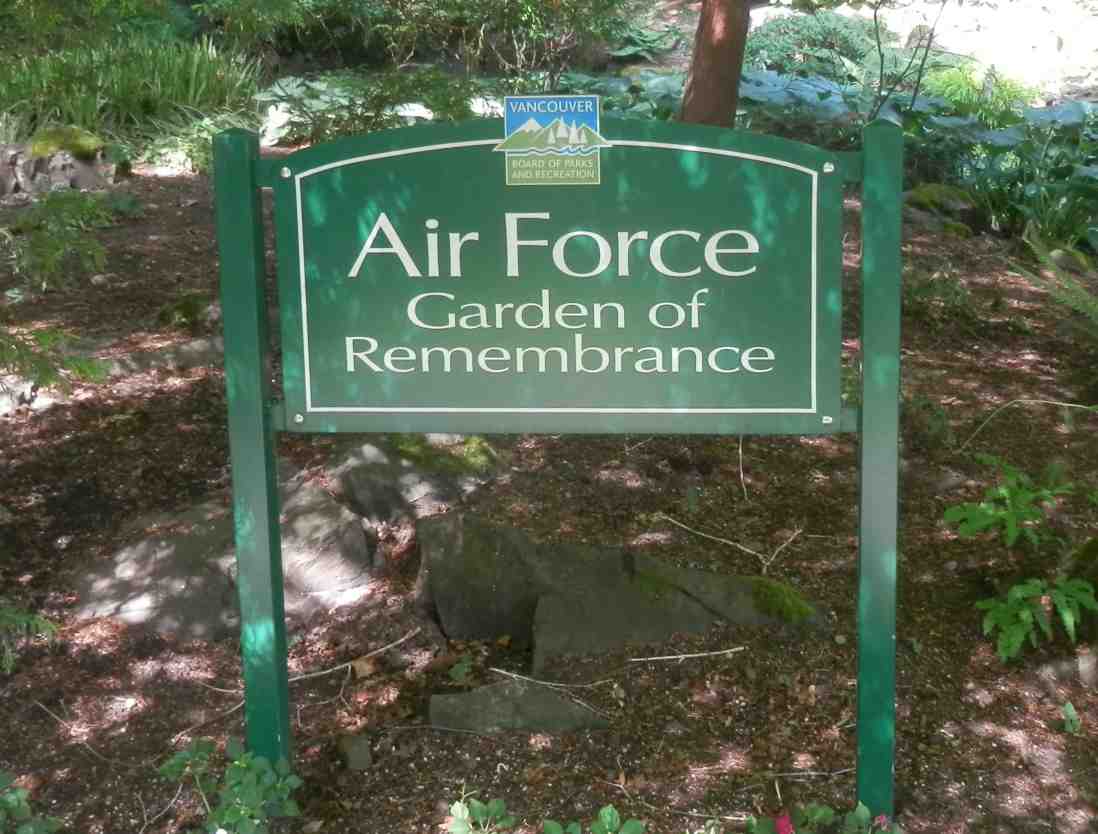
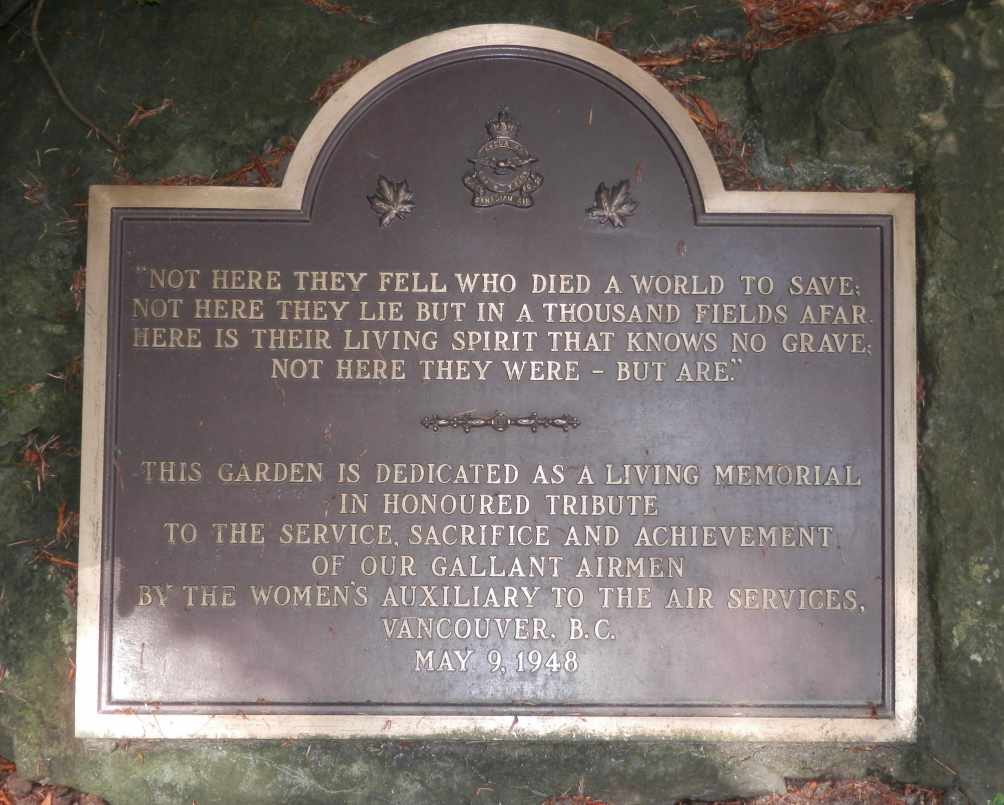
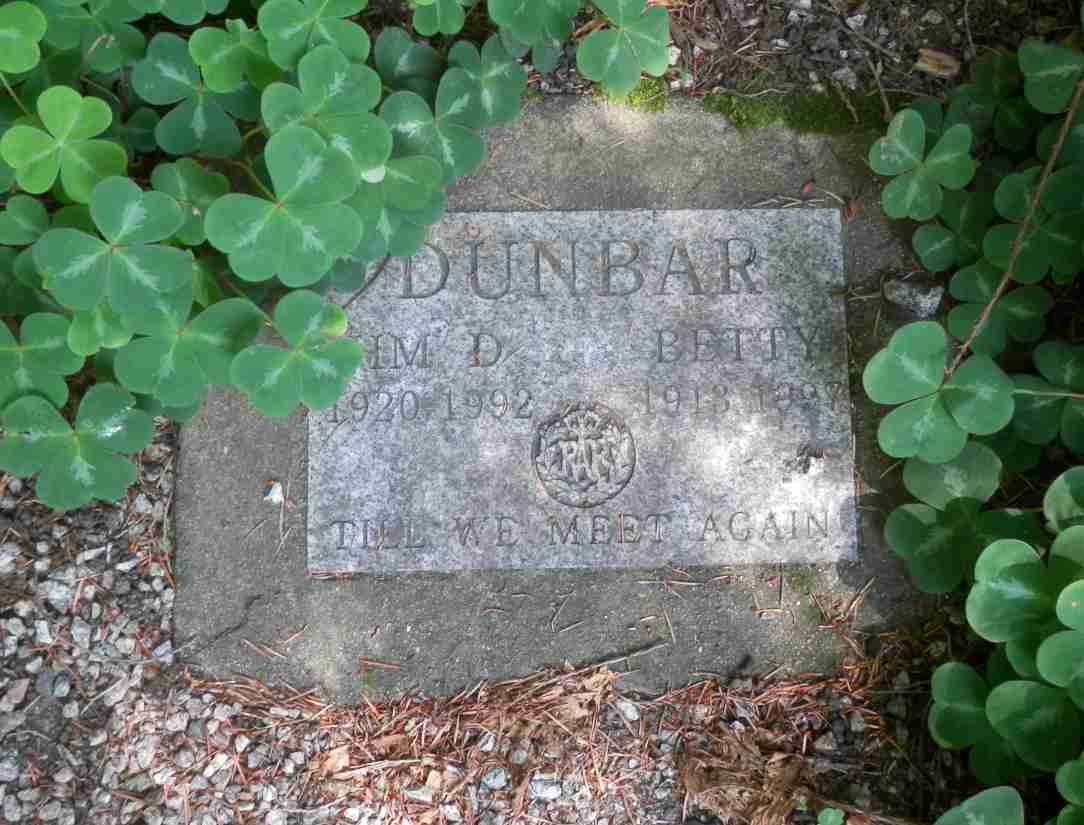
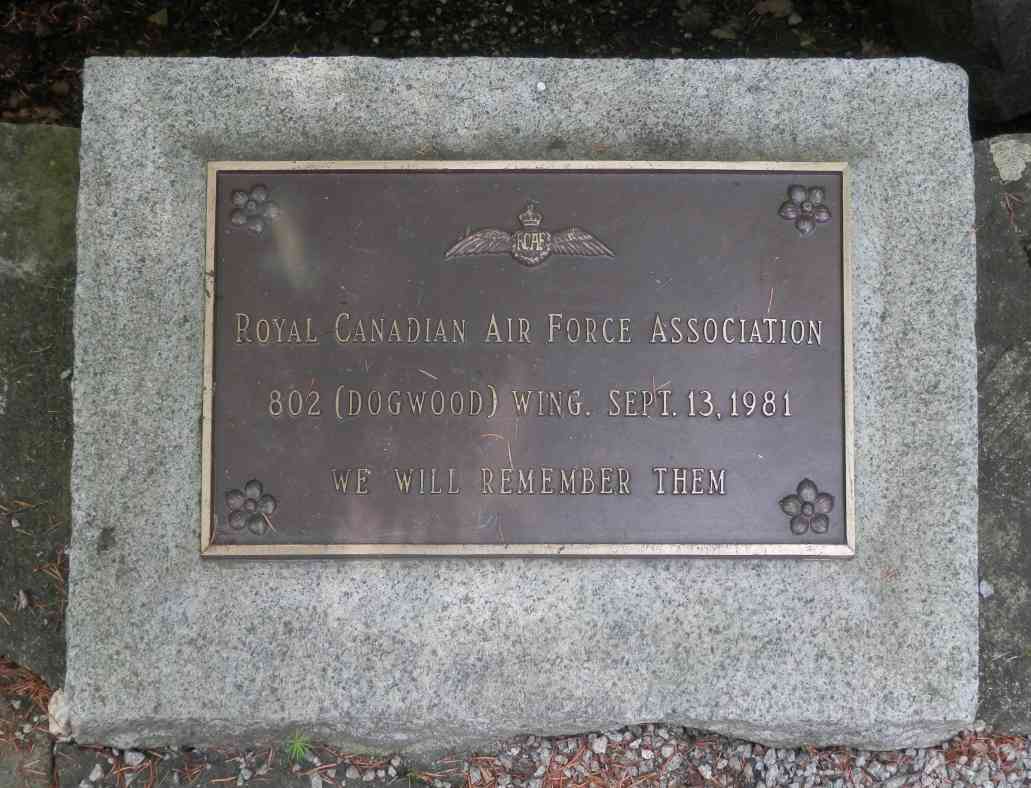
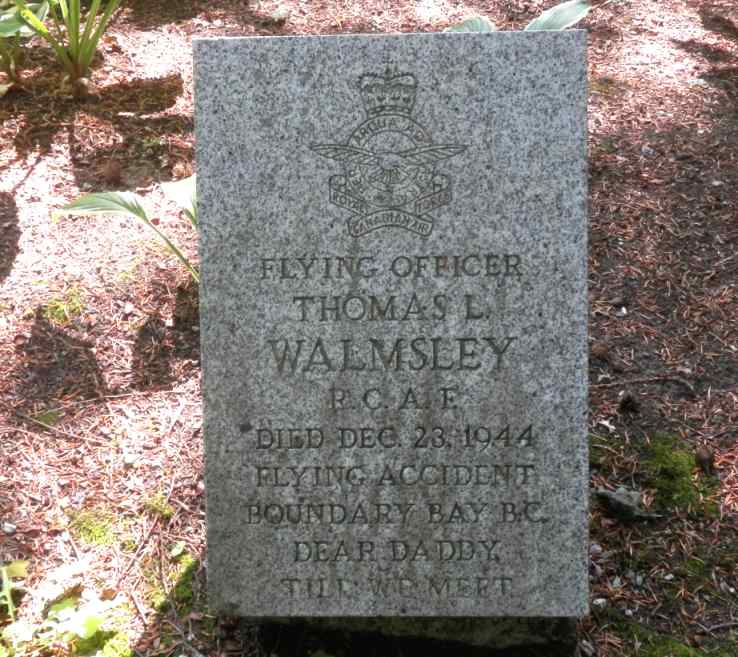
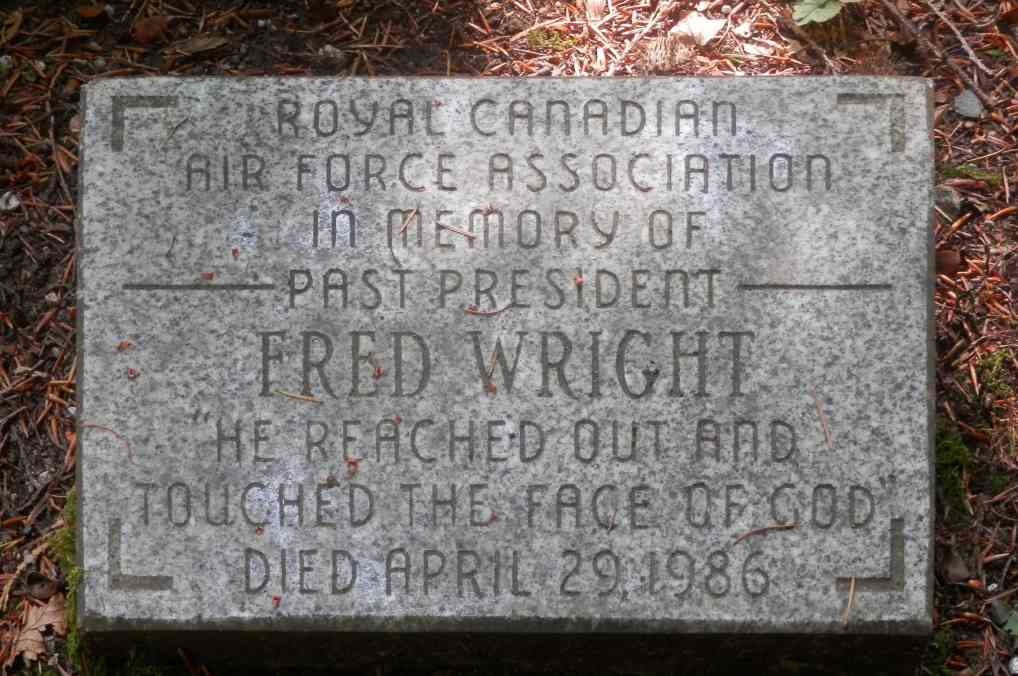
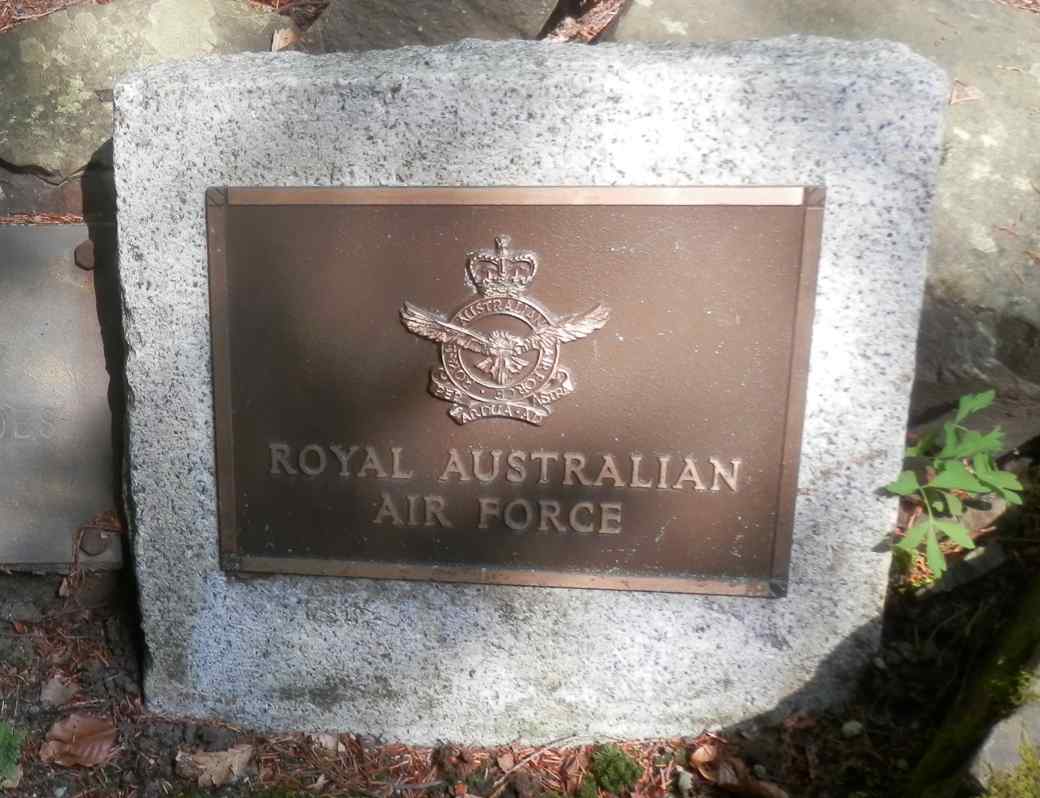
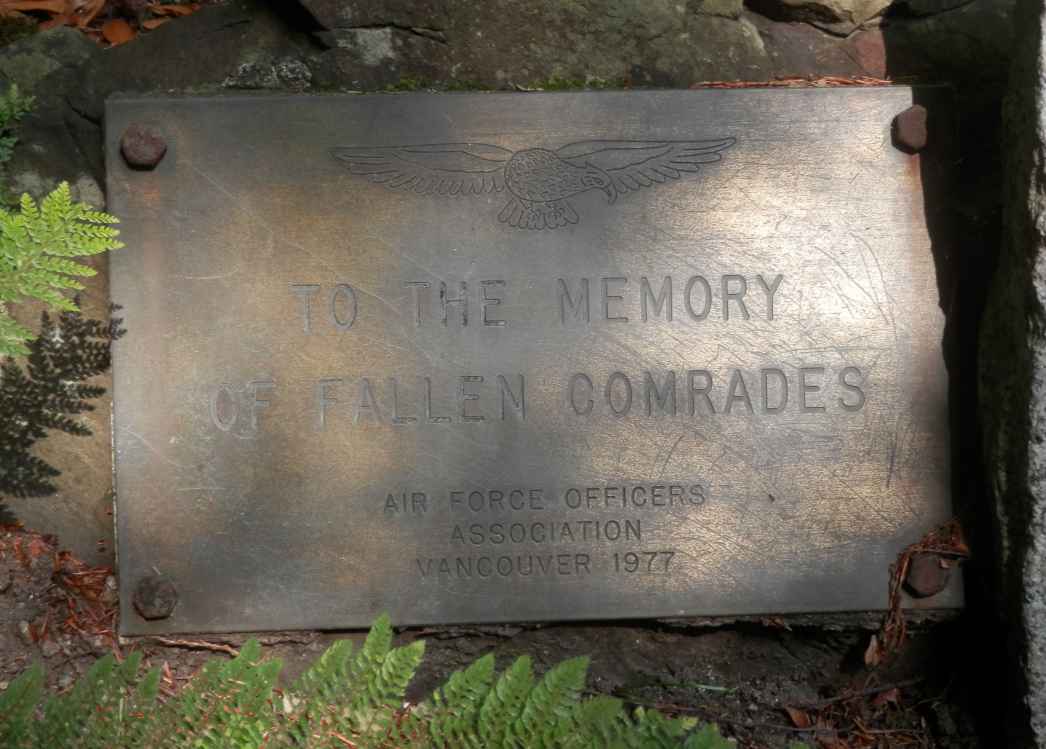
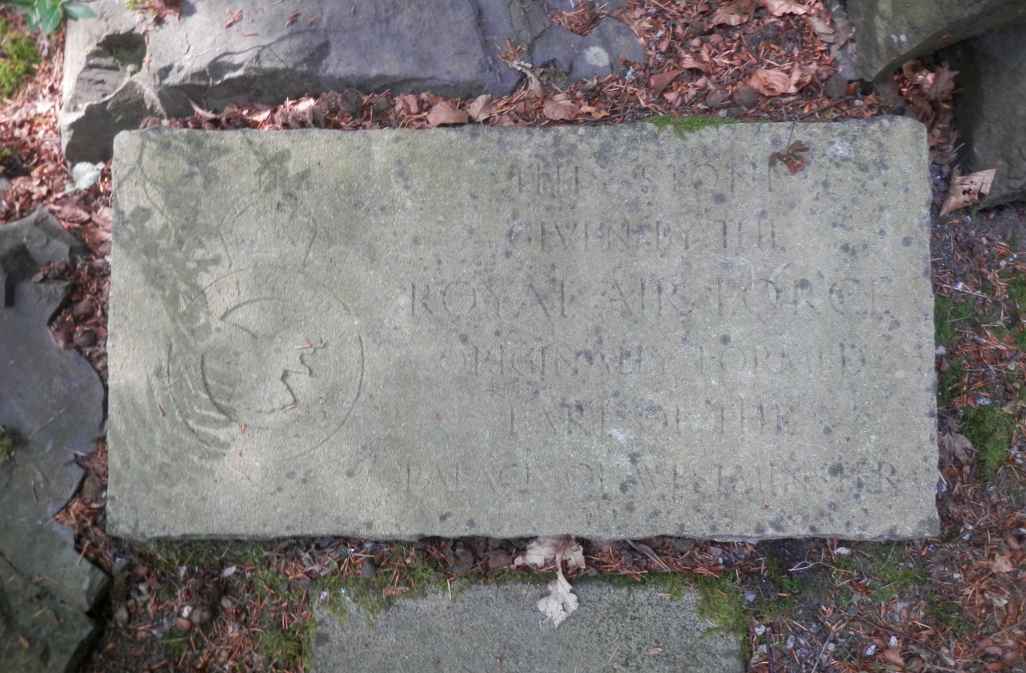
"This stone given by the Royal Air Force, originally formed part of the palace of Westminster"
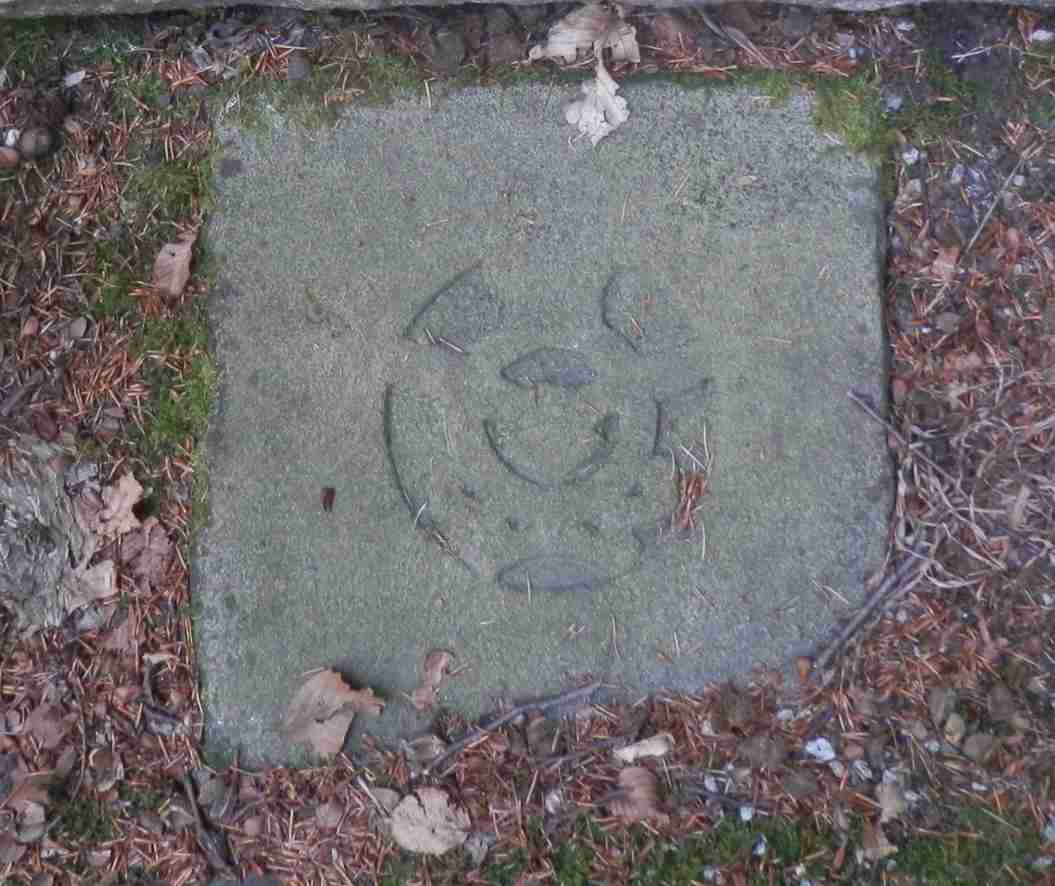

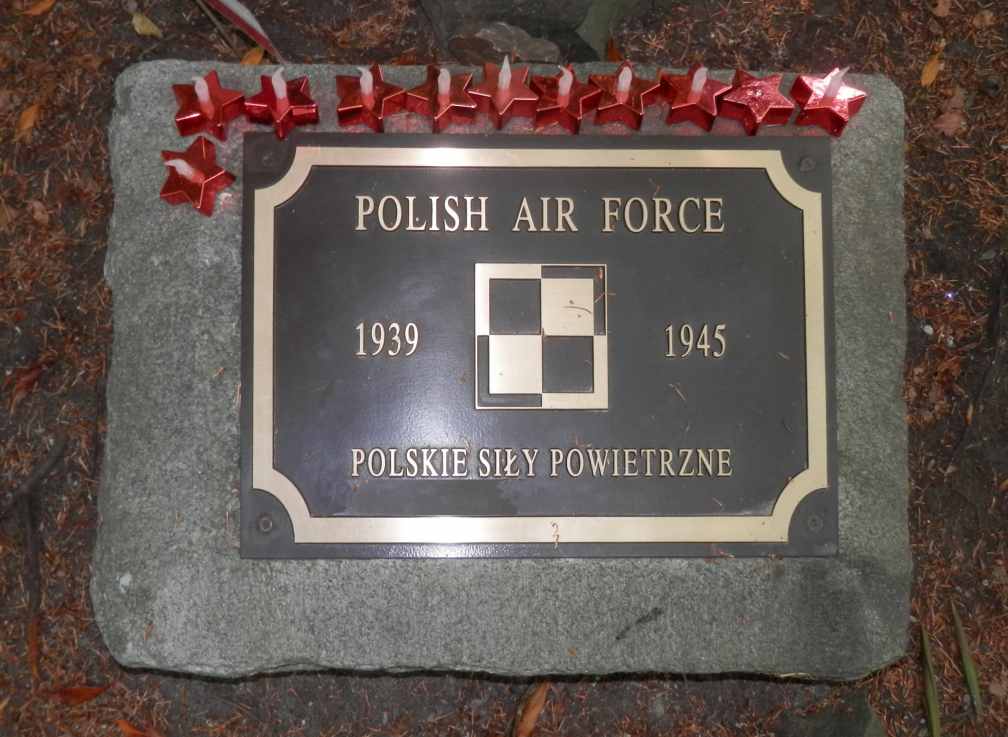
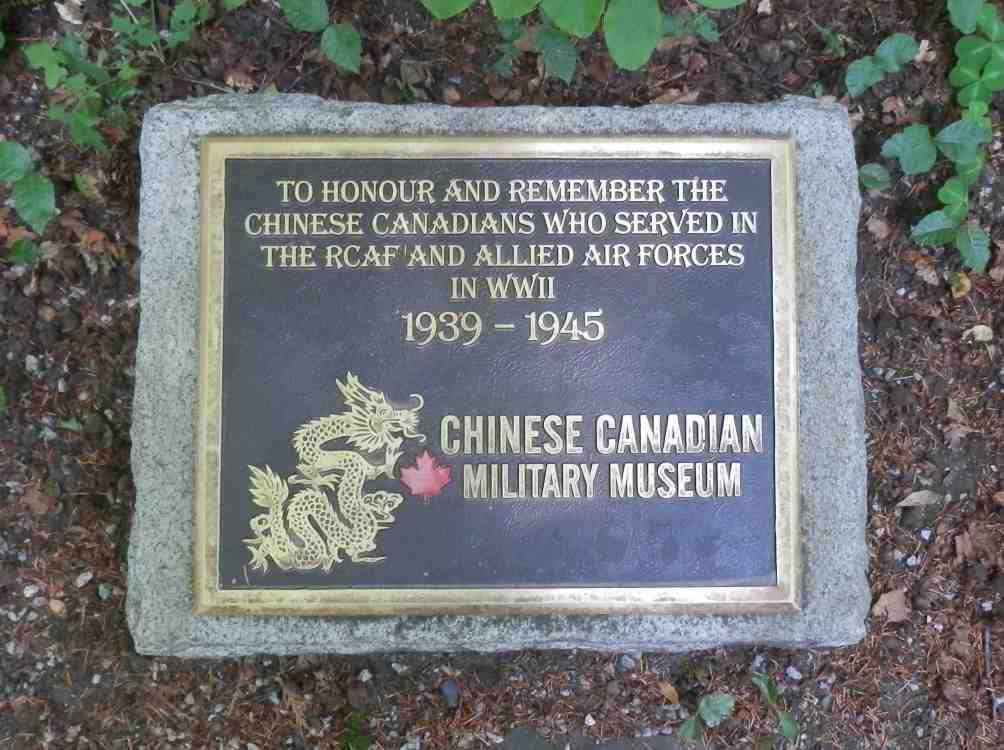
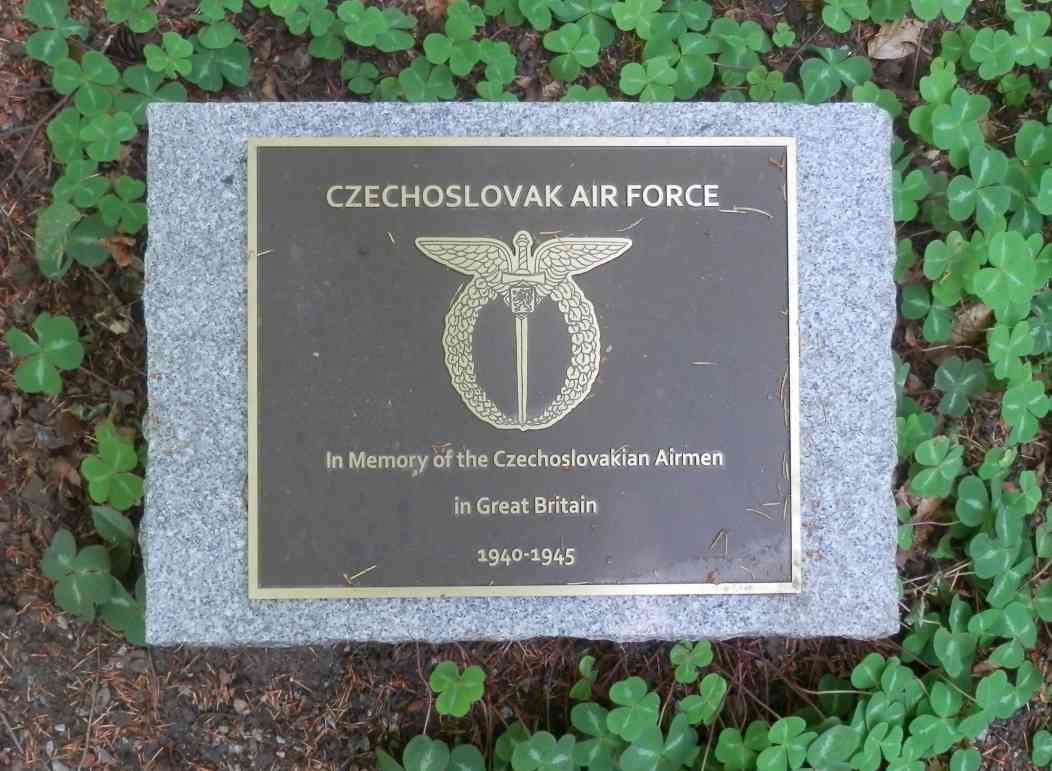
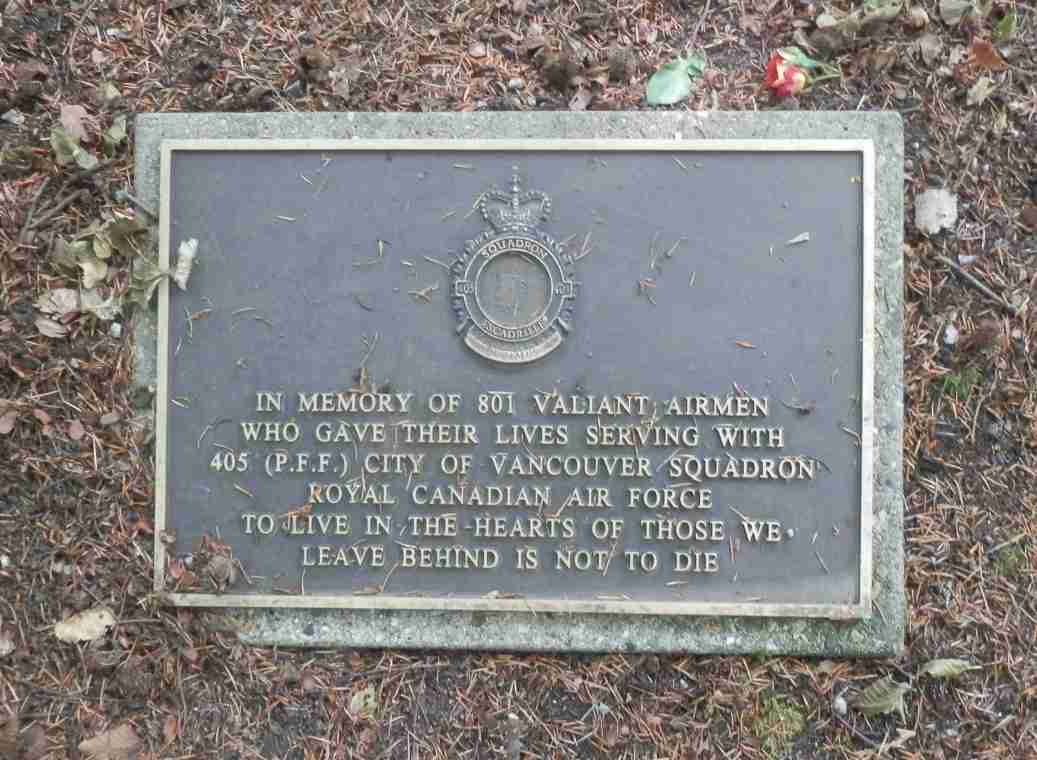
Jan. 1 2024: c1960s COOKING MATERIAL

Collection of recipe booklets.
I have a box full of old family recipes and cook books, and after many years had
a look in the box to see what was there. I found dozens of old commercial food
company recipe booklets of all descriptions. They are all quite colourful, and
have lots of late 1950s and early 1960s marketing images. Mind you, some of the
recipes seem less than appetizing, for example cucumbers in mushroom sauce from
the 1953 Heinz "57 ways to use Heinz condensed soups."
Jan. 11 2023: STAVE FALLS POWER PLANT
I worked on a conversion project for this 1912 electrical power plant when I was with
Toby Russell Buckwell Architects in 2000. Here are three scans from the generator hall,
prior to its renovation into an interpretive centre. We hired Harold Kalman (Commonwealth Historic
Resource Management, best known for the Exploring Vancouver series of books) to determine/analyze
the original colour scheme, which was used for the repainting. There were quite a few
layers of paint, they had a sample patch showing a series of successive layers they had
peeled off down to bare concrete. I always loved the arched walls over the generator intakes,
structurally they were completely needless, but beautiful and perfectly designed.
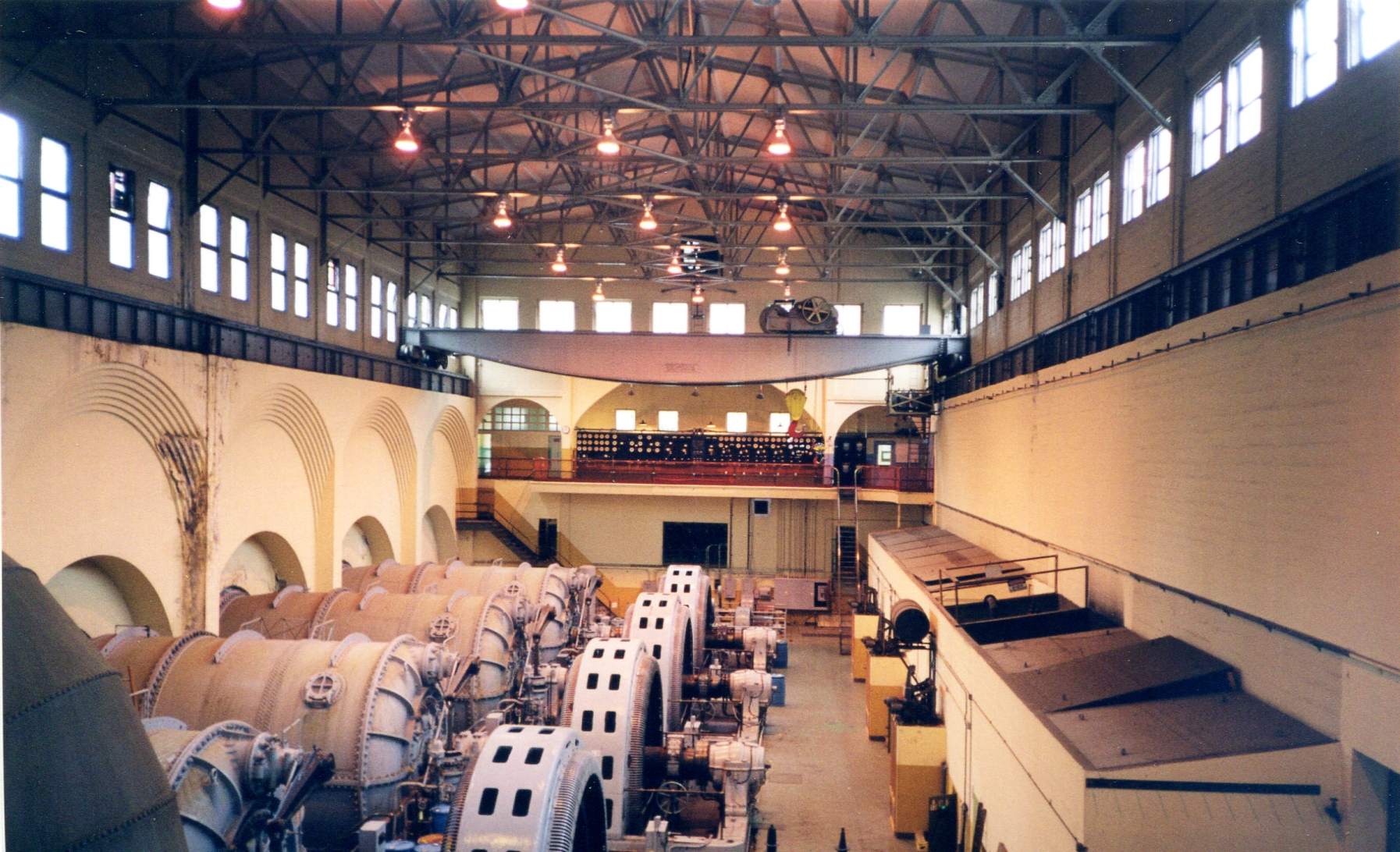

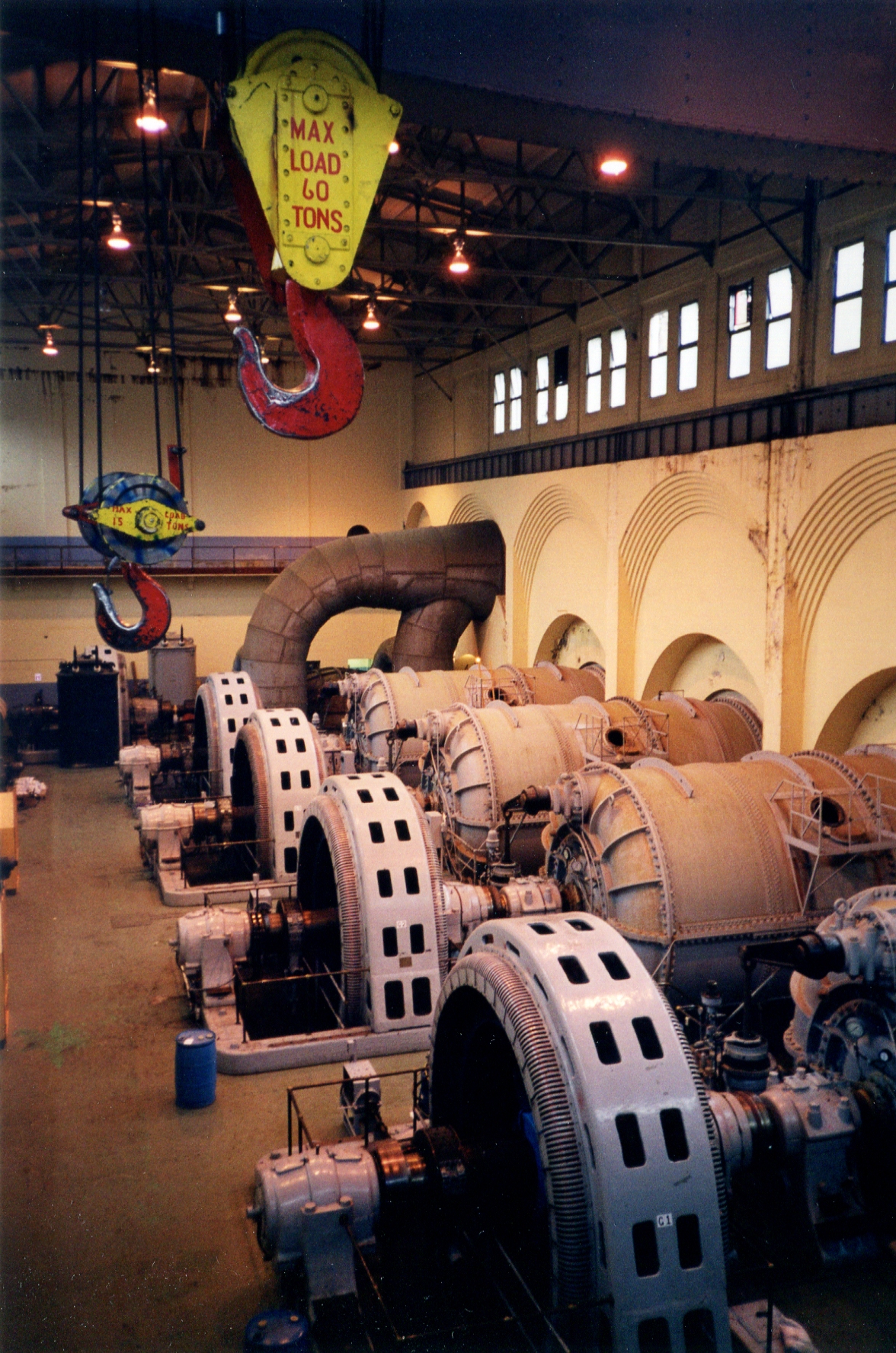
Jan. 10 2023: DEVICE TO ROOT OUT EVIL
This sculpture by American artist Dennis Oppenheim (1938 - 2011) was installed in Vancouver
on the south shore of the harbour from 2005 - 2007. I took photographs of it on a couple of
occasions. Although it was supposed to remain in Vancouver there was
a protest by religious folks who wanted to have it removed. It was later installed in
Calgary, and finally moved to Porta de Santa Catalina, Palma de Majorca where folks
are apparently a little more forgiving. It was first exhibited at the 1997 Venice
Biennale, and was subsequently rejected by Stanford University. I thought it was a
beautiful, thought provoking work, and was sorry to see it go.

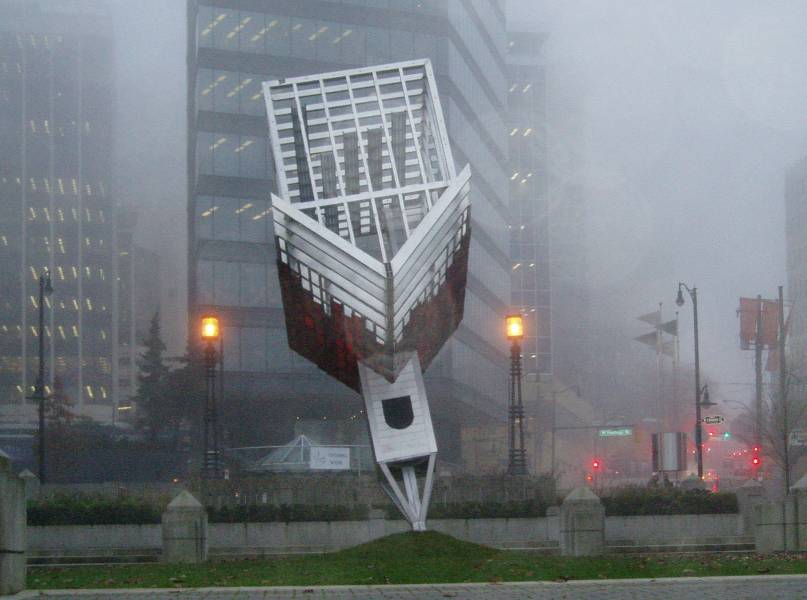
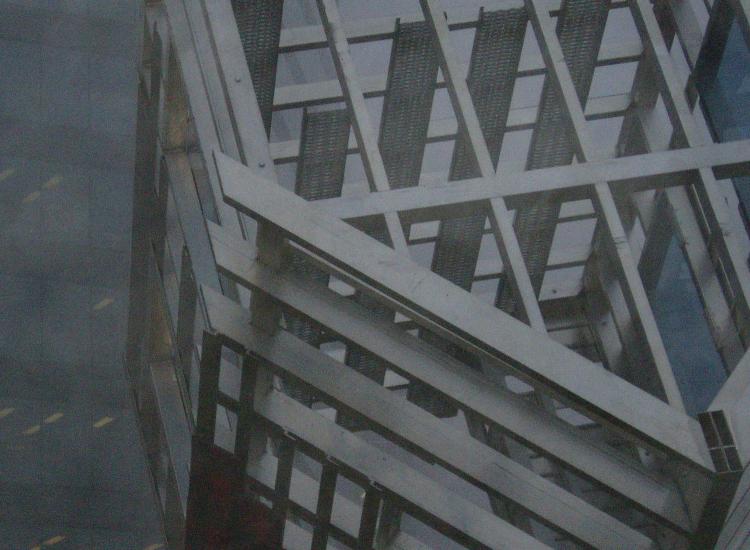
Jan. 9 2023: VAN DUSEN GARDENS EDUCATION CENTRE
Following the opening of Van Dusen Garden's new visitor centre on Oak
Street, the Parks Board announced plans to demolish the 7,000 square
foot "Education Centre" that is nestled into a hillside at the back
of the park. It is currently used as an administration office.
Heritage Vancouver would like to retain the building, and is working
to see if it can be saved and re-purposed. An "ART MOB" event was held
in 2013 for those interested in the building. As luck would have it,
we were able to tour the inside of the building. It is quite an amazing
structure, and it would be a great pity if it were to be demolished. It
is in excellent condition, despite a general lack of maintenance on the
building.
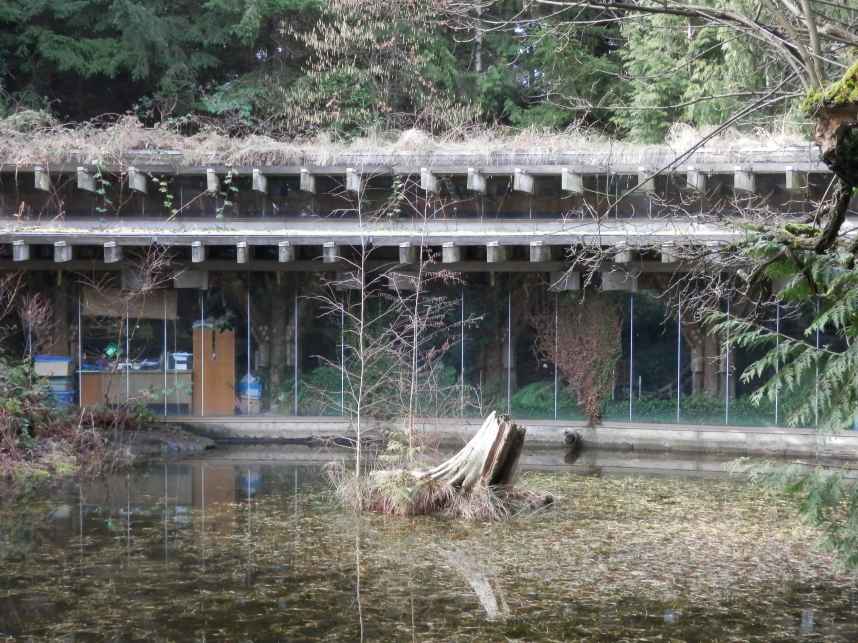
Education Centre viewed from across the pond.
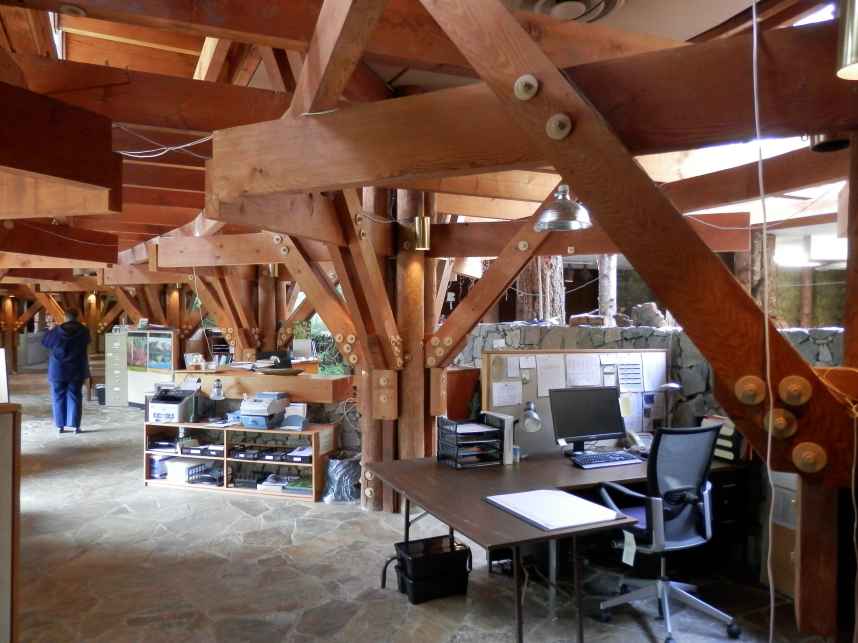
View of interior.
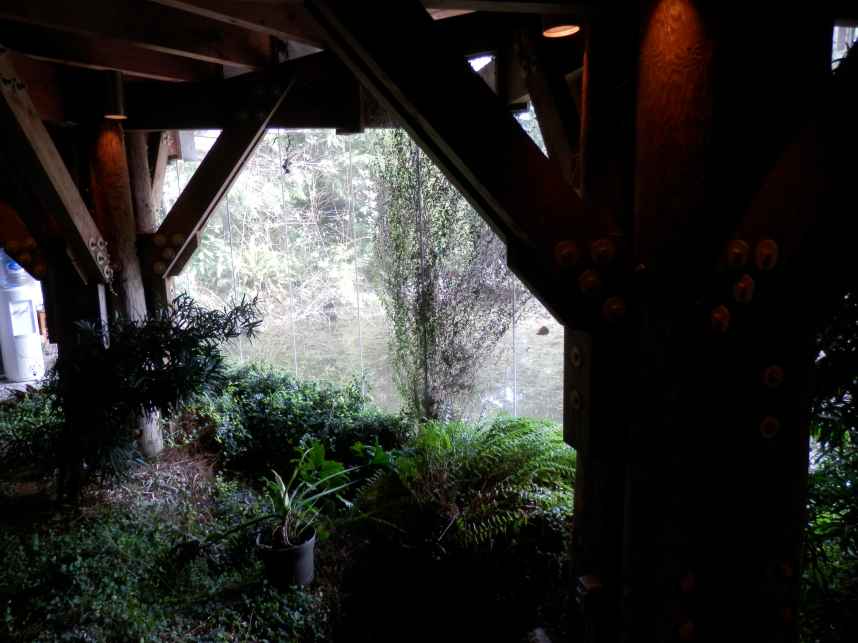
Looking out from inside.
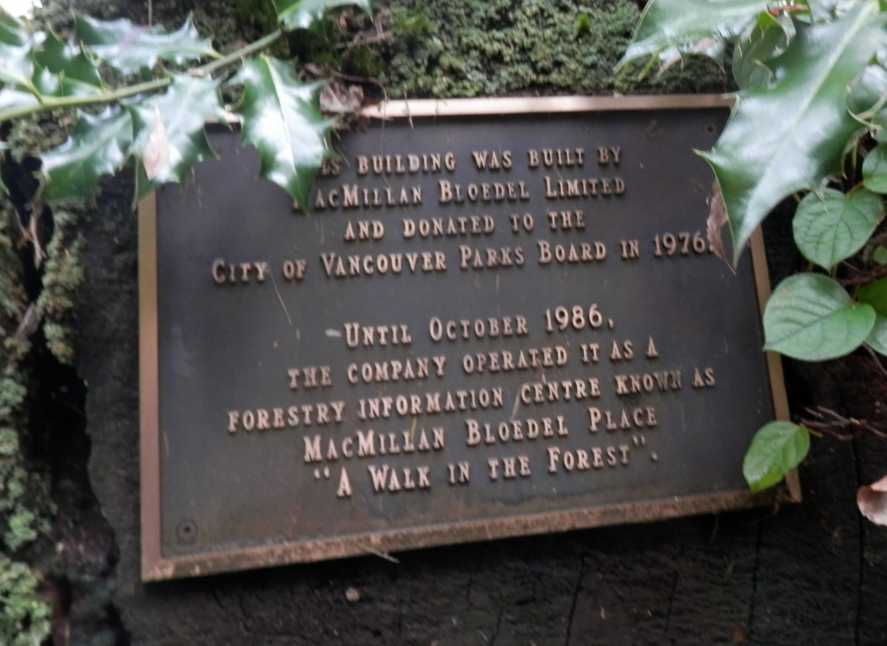
Dedication plaque.
OCT. 6 2022: POLAR BEARS IN STANLEY PARK
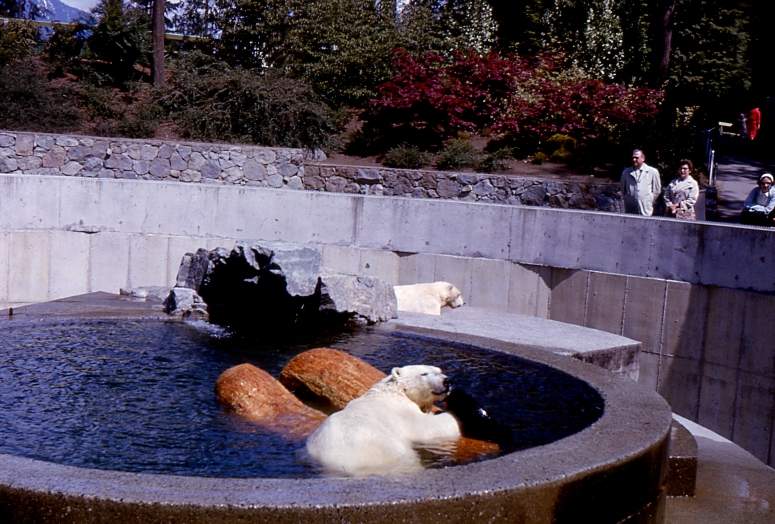

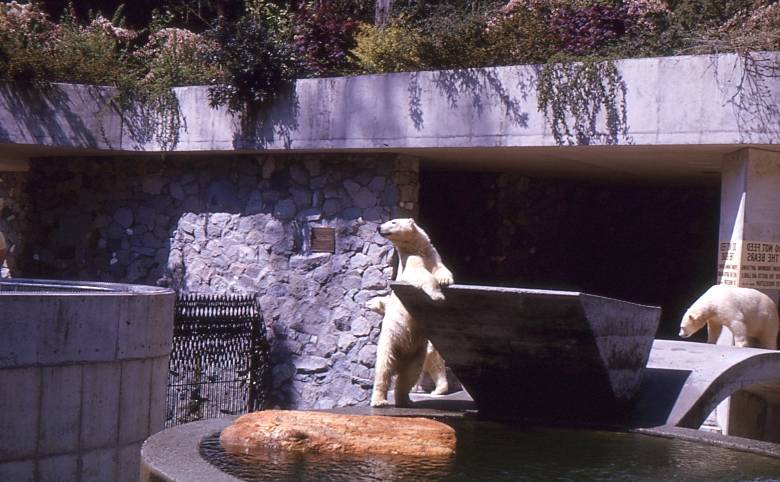
Photos of the polar bears in Stanly Park Zoo. Slides were developed September 1964. Scanned August 2022
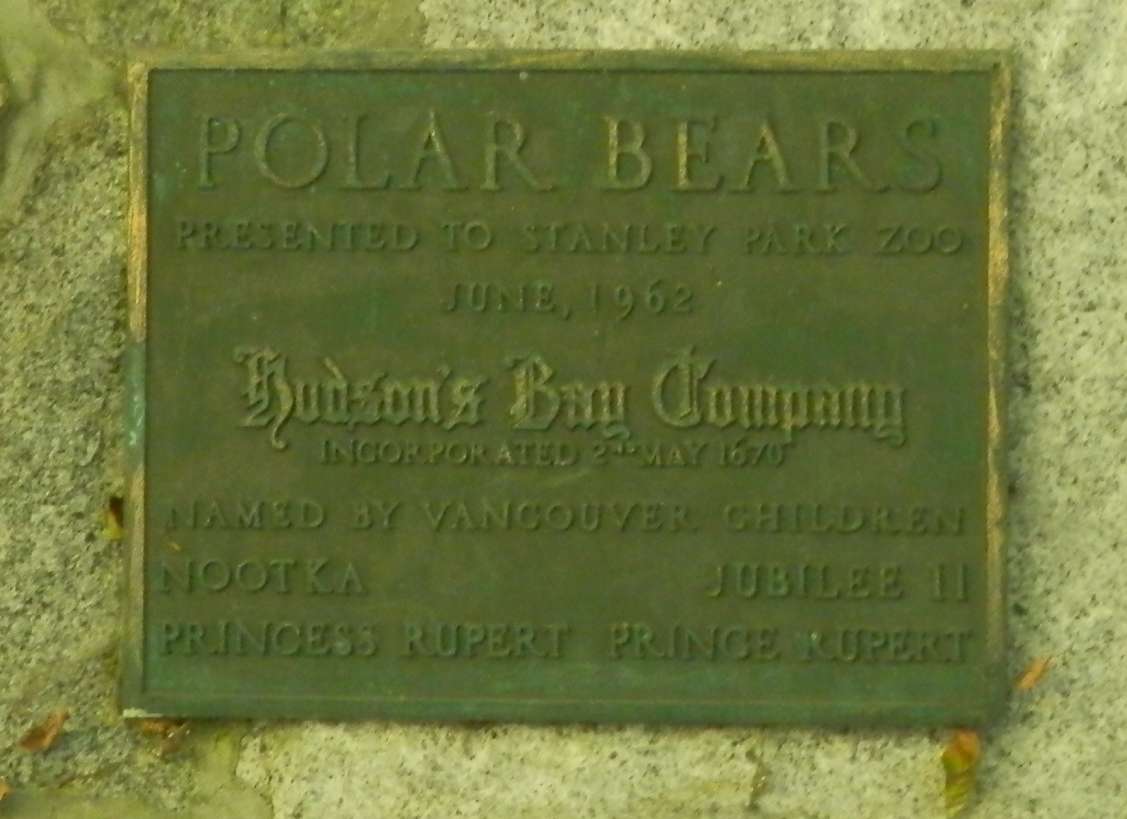
June 2020 photograph of polar bear sign. Photo G. Sim
JAN. 10 2022: VERNON DRIVE GROCERY STORE
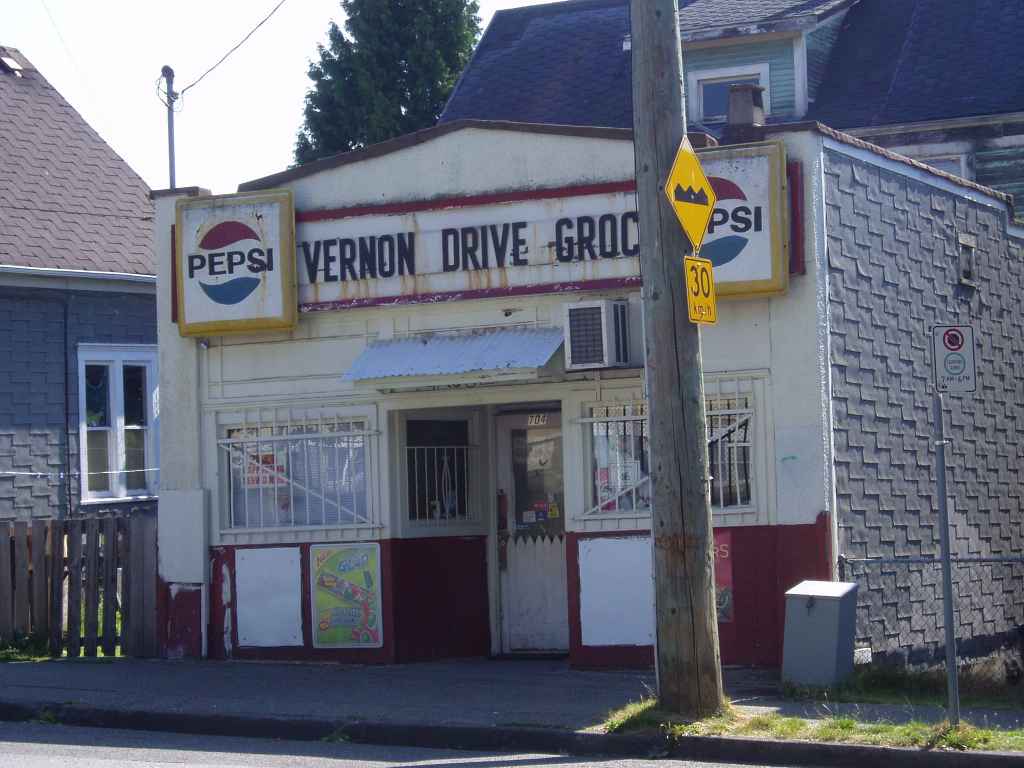
A sign to the left of the door advertises the new "GLOP", a sugar-filled gum. Photo G.Sim 2009
JAN. 9 2022: WOOD ROAD
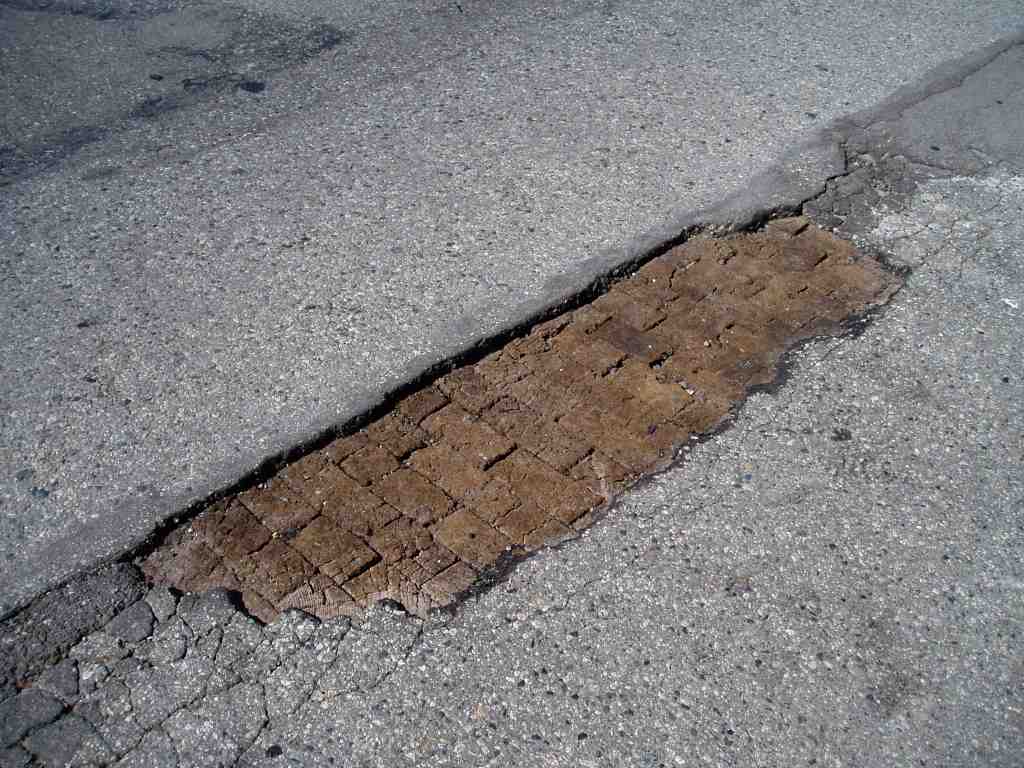
An exposed section of original hardwood road, Downtown East Side. Photo G.Sim 2009
Dec. 12 2021: BISHOPS RESTAURANT
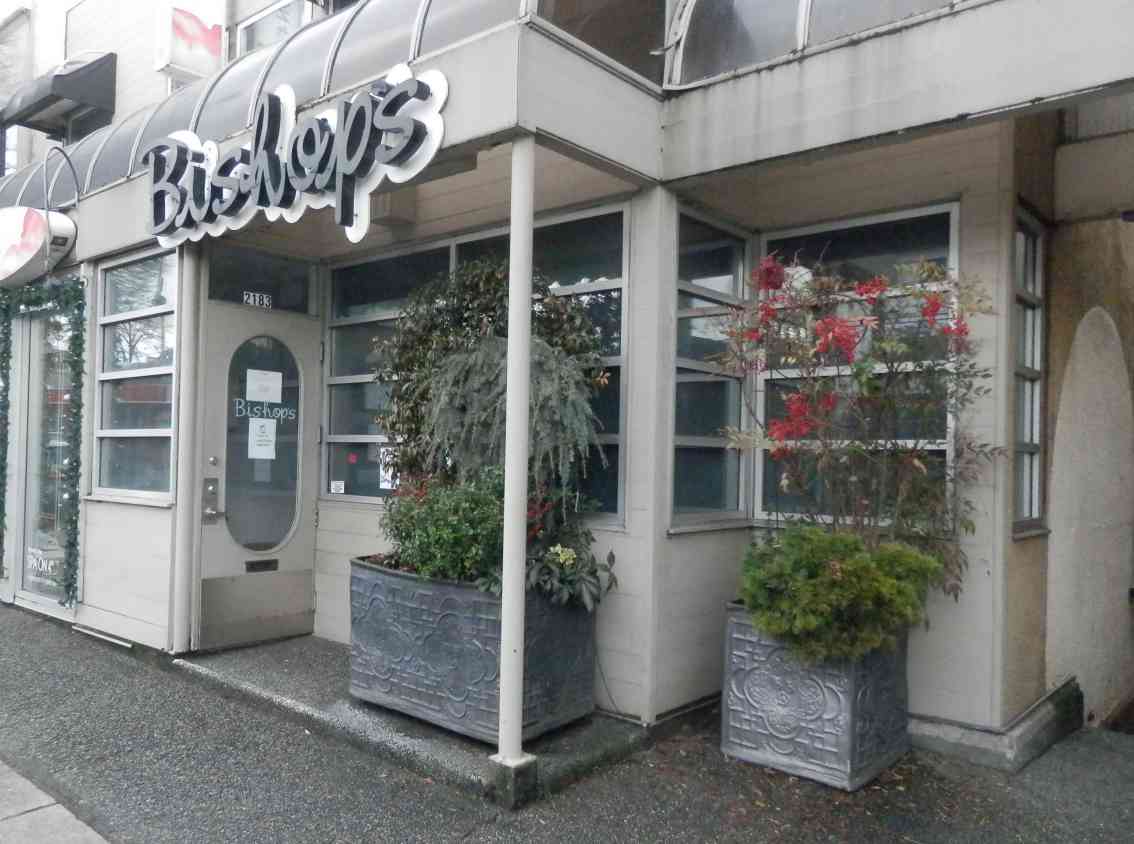
A view of Bishop's Restaurant on Fourth Avenue a little while before it closed.
The lower sign on the door states "Vaccination Certificate Required." A sign
of the times. Photo Gary Sim 2021
APRIL 7 2021: OLD PHOTOGRAPHS FROM SOMBRIO BEACH
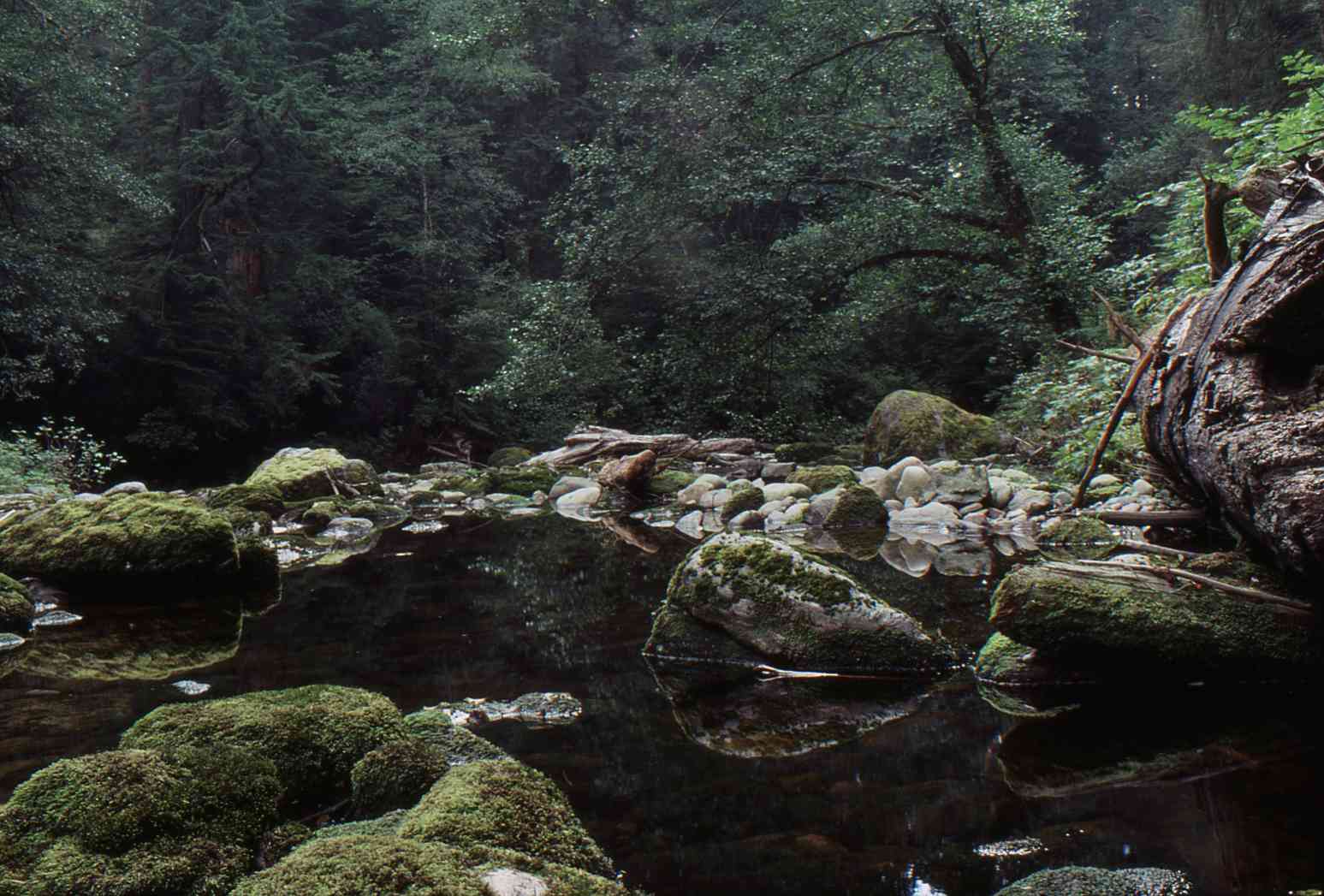
A quiet day on Sombrio River, a huge old cable-strapped log on the right driven ashore in a winter storm
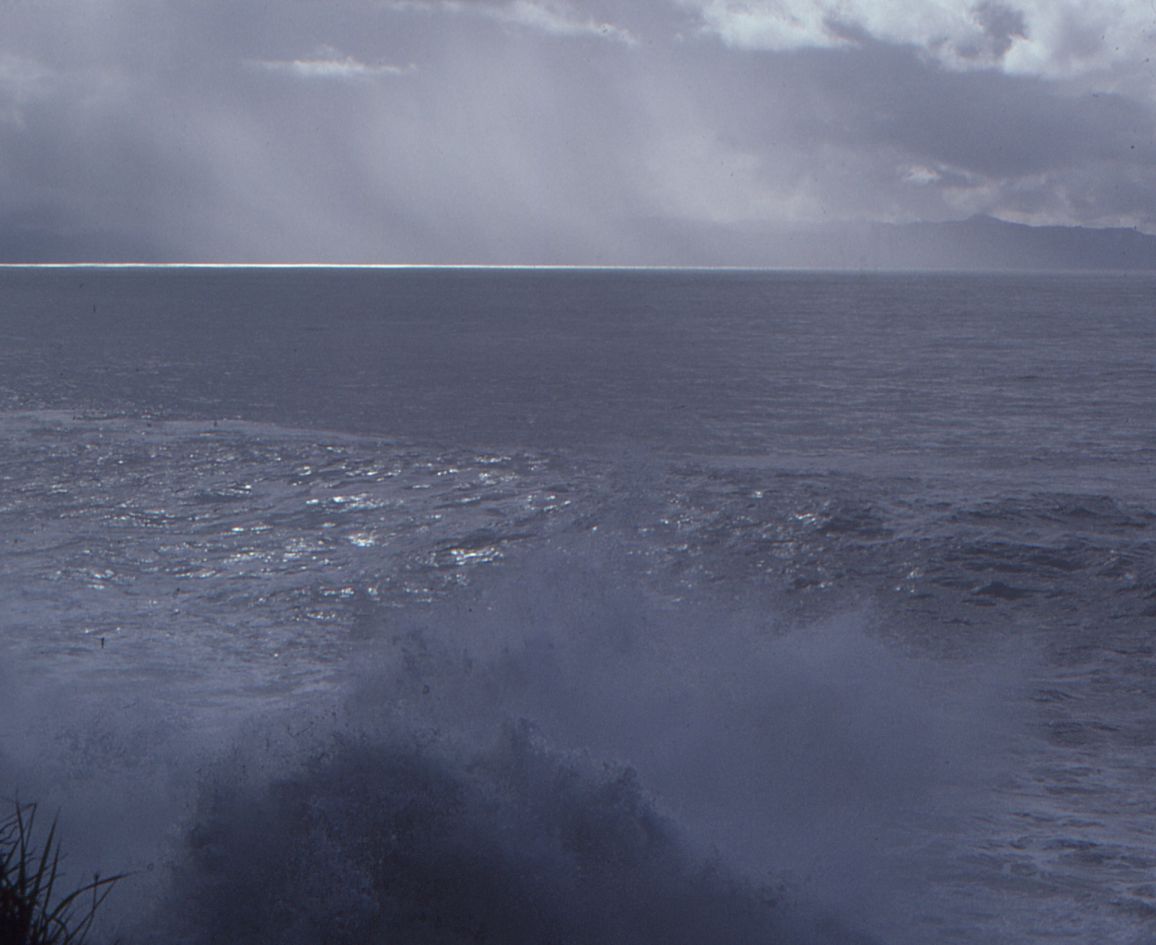
Looking south from Sombrio Point across the Strait of Juan de Fuca to the Olympic Peninsula, waves nipping at our feet
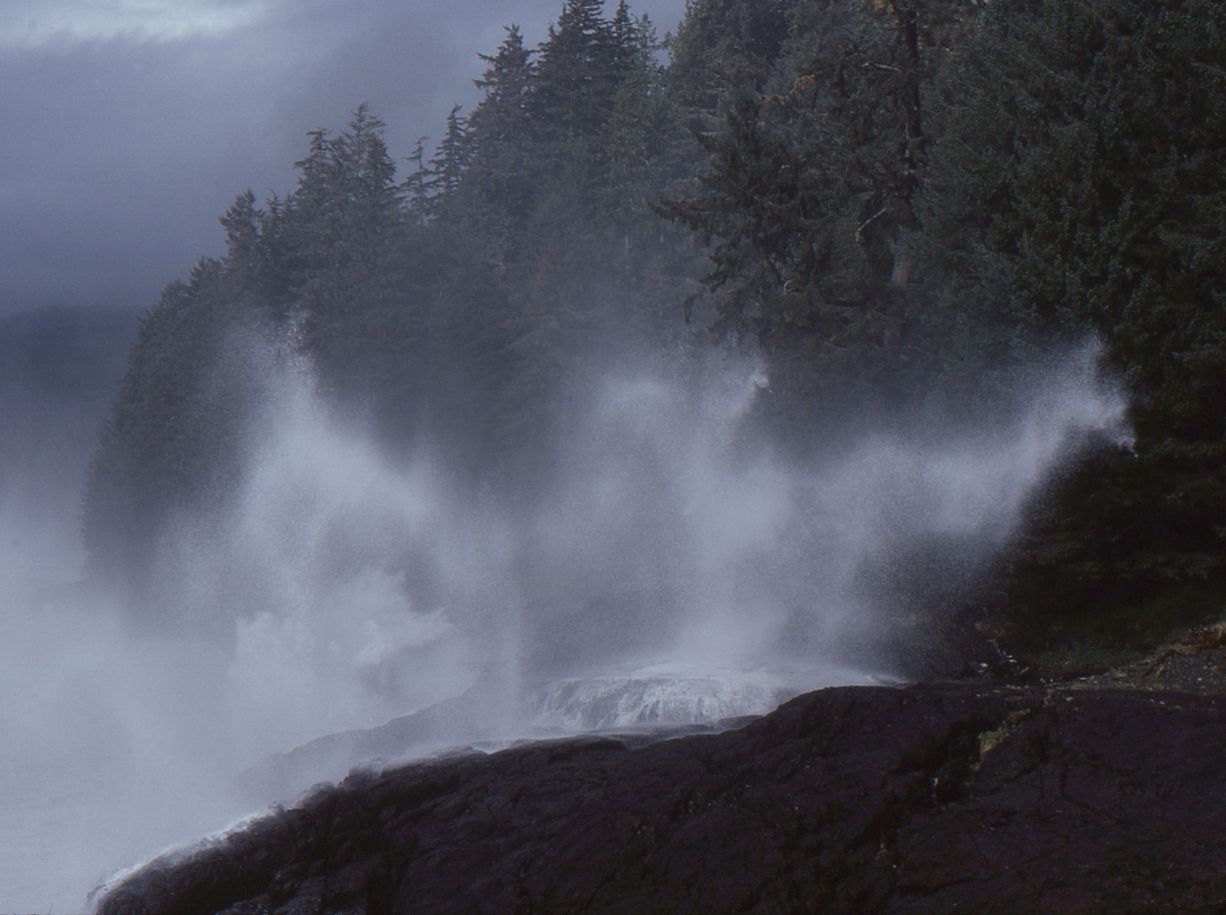
Lingering spray from an eruption of the Sombrio Point blowhole
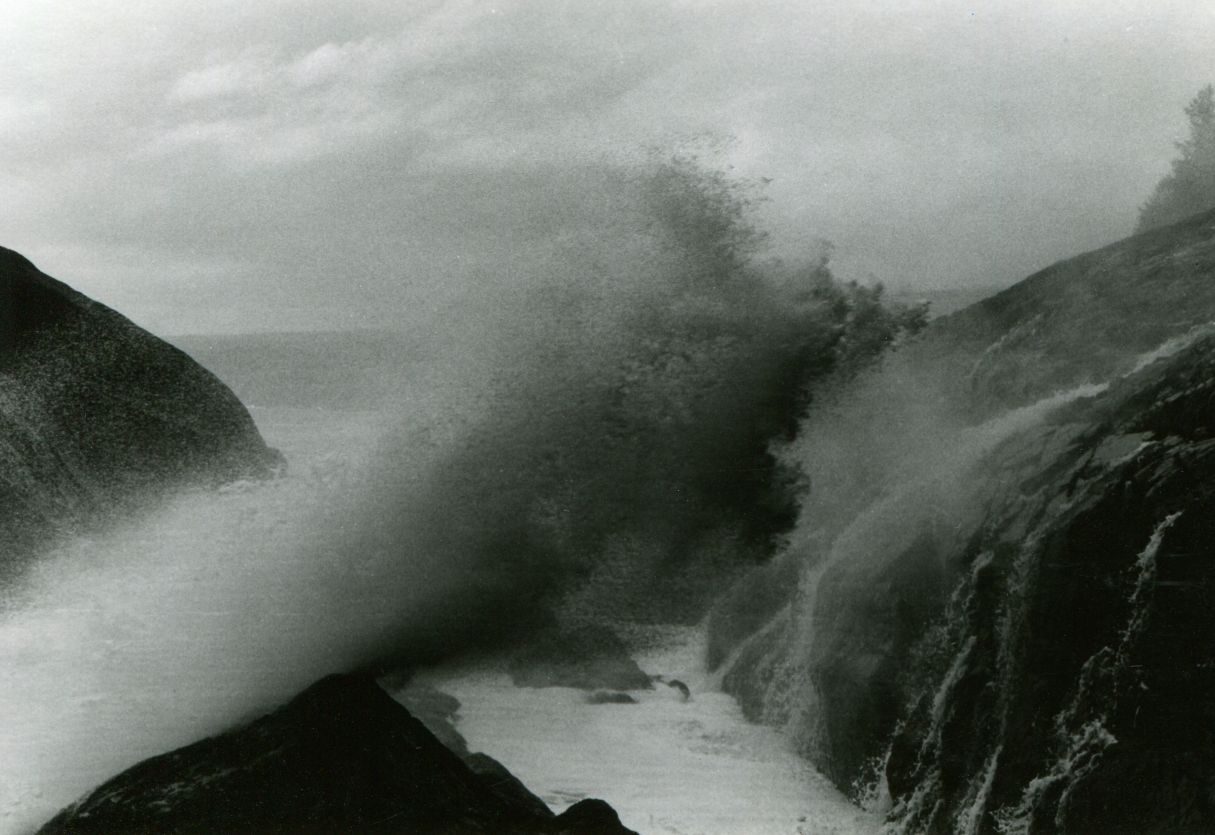
A closeup side view of the Sombrio Point blowhole erupting (Ilford HP5 high speed film at 1,000/second)
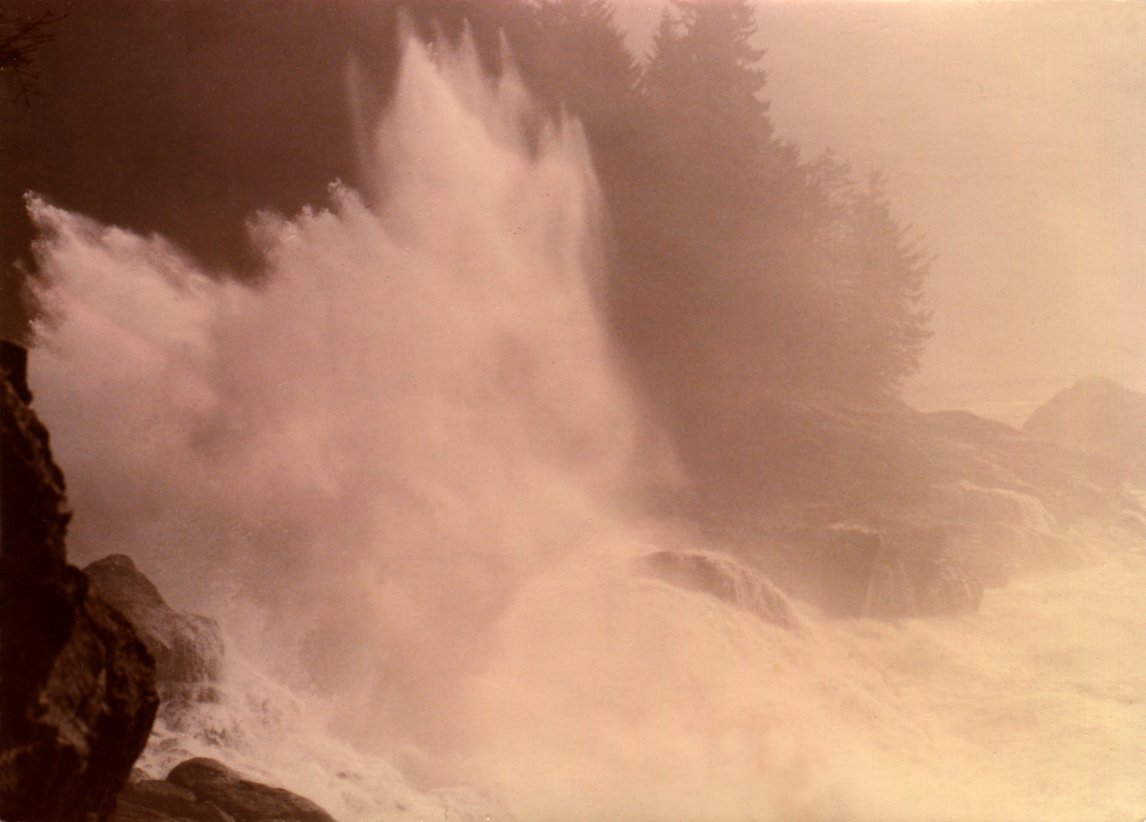
This little wave splashed over 100 feet in the air, Sombrio Point on the right
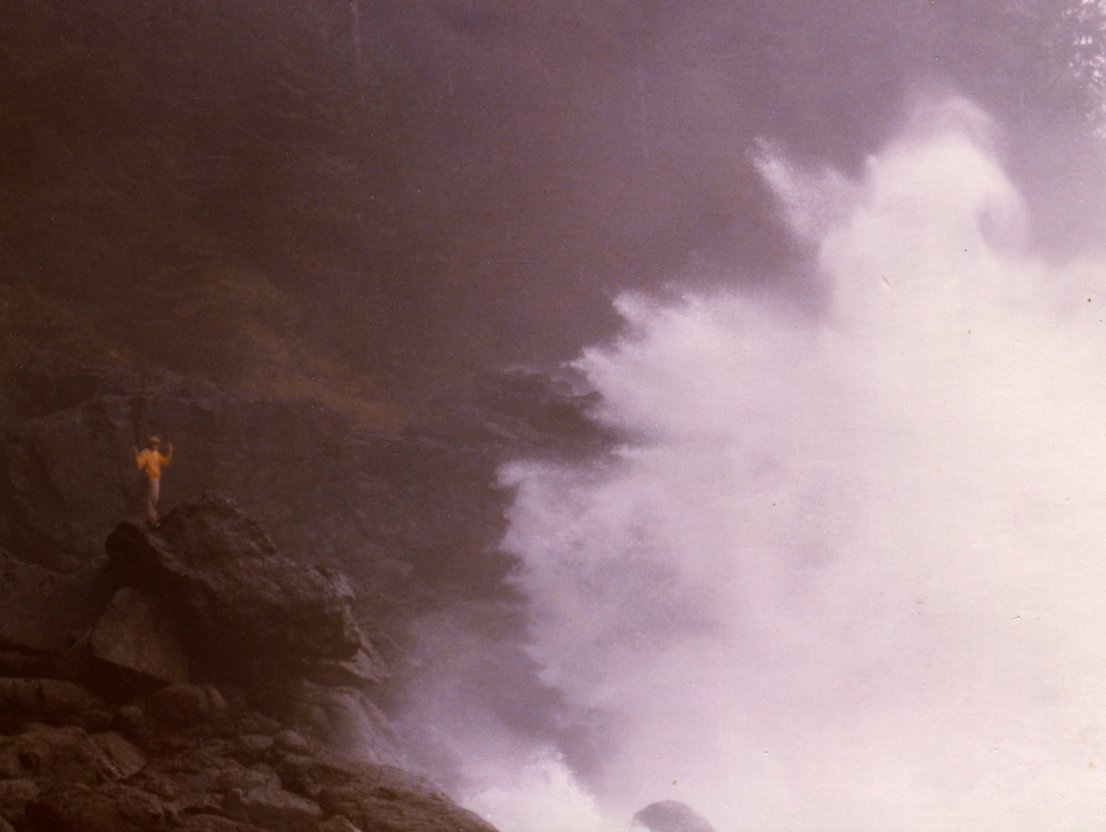
Oops! I think I'm standing in the wrong spot. I put my hands up in surrender, but wasn't taken by the wave

Some the massive waves crested over eighty feet, this one's only about fifty. Sombrio Point on the left
JAN. 31 2021: GERALD GIAMPA LEAD TYPE ORNAMENTS & PRINTING

Four examples of Giampa's typecasting work, the large ornament is one inch wide

Another example of Giampa's typecasting skill, this ornament of a type-casting machine is half an inch wide
I acquired a few pieces of lead type some years ago at Salmagundi West, in Gastown.
They had been made by Gerald Giampa, who was born in North Vancouver. From an early age
he was interested in letter-press printing and type design. Cobblestone Press and Northland
Letterpress were two of his printing companies in Vancouver. At one point he moved to
Nova Scotia, then returned to Vancouver, moved to San Francisco, and returned again.
At this point I got to know him personally for a few years. He always stuttered, and
blamed it on a traumatic incident in his childhood.
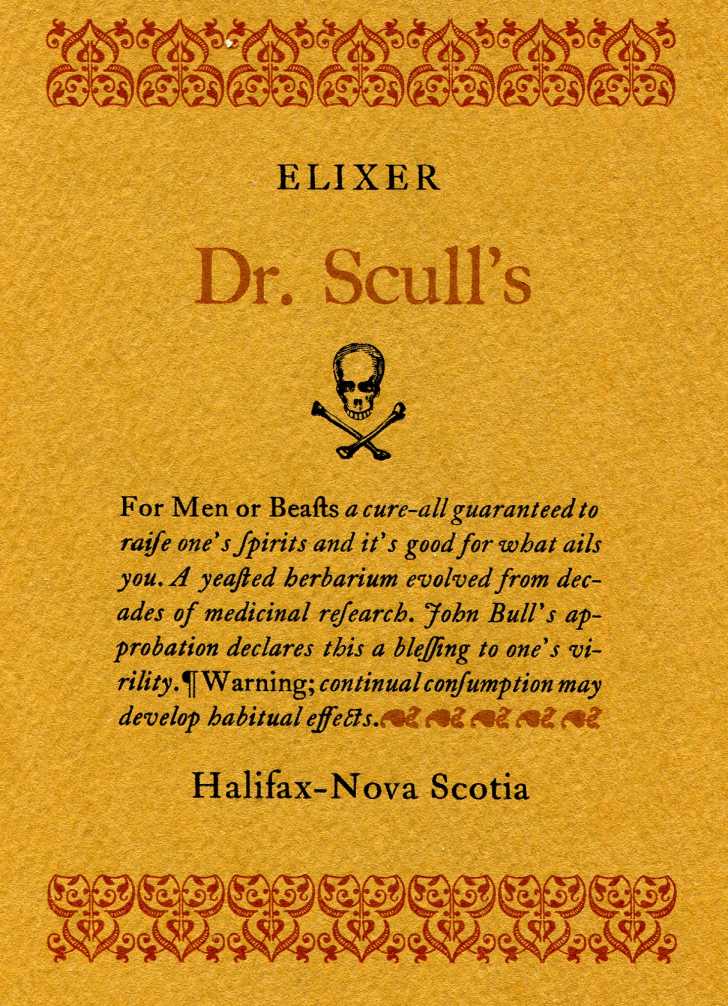
A sample of work from 1970
He was one of those unique characters who become locally famous. They are superb
at what they do, but not so good with most people. Another such person, legendary
bookseller William Hoffer, referred to Giampa in print as "the
treacherous Giampa" because of some printing/bookselling deal that went sideways, and at one
point Giampa was at war in print with a Director of the Alcuin Society and issued a letterpress
broadside describing the situation from his own perspective.
Both relationships are somewhat unusual in that there is a printed record of the snits.
Giampa's work schedule and production levels were inconsistent, but his design and typography
skills were world-class, and his printed output still stands proudly on its own merits.
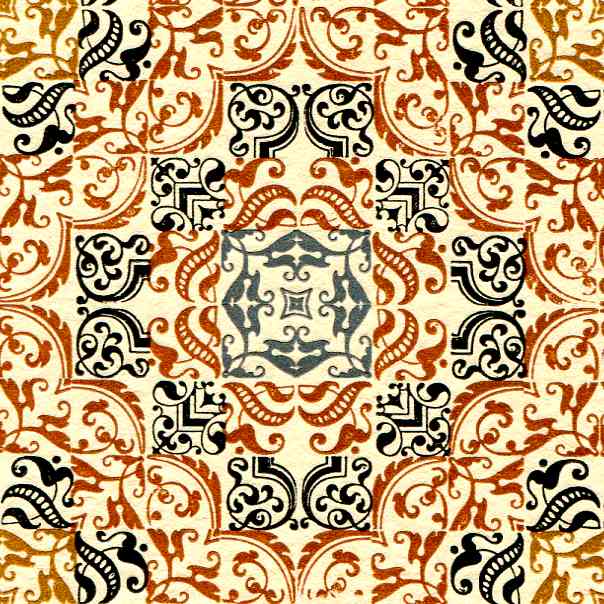
1982 multi-colour cover (detail) for an exhibition of Giampa's work at Burnaby Art Gallery
I donated a collection of Giampa's letterpress work, such as the above exhibition invitation,
to Simon Fraser University Special Collections. They have a large fond of his work for
public reference. I still have a few bits and pieces. Giampa died in Vancouver in 2009 of
some horrible infection that forced the doctors to put him in complete isolation at the hospital.
Apparently you could talk to him on a phone they installed, but I only found out after
it was all over.
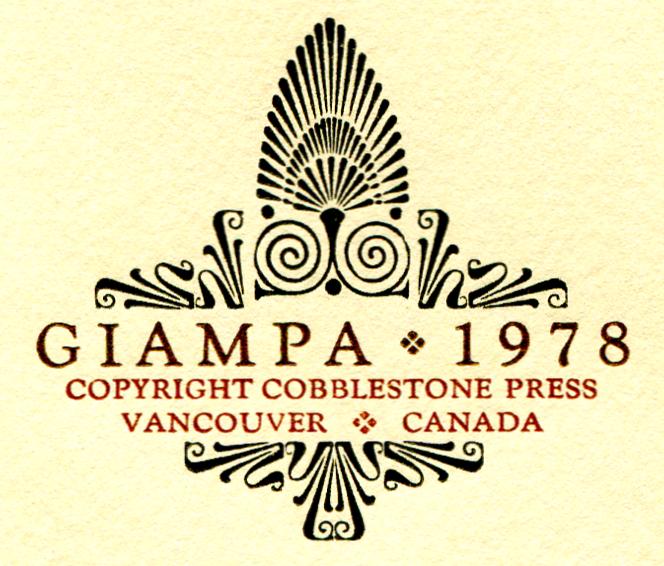
1978 Cobblestone Press logo
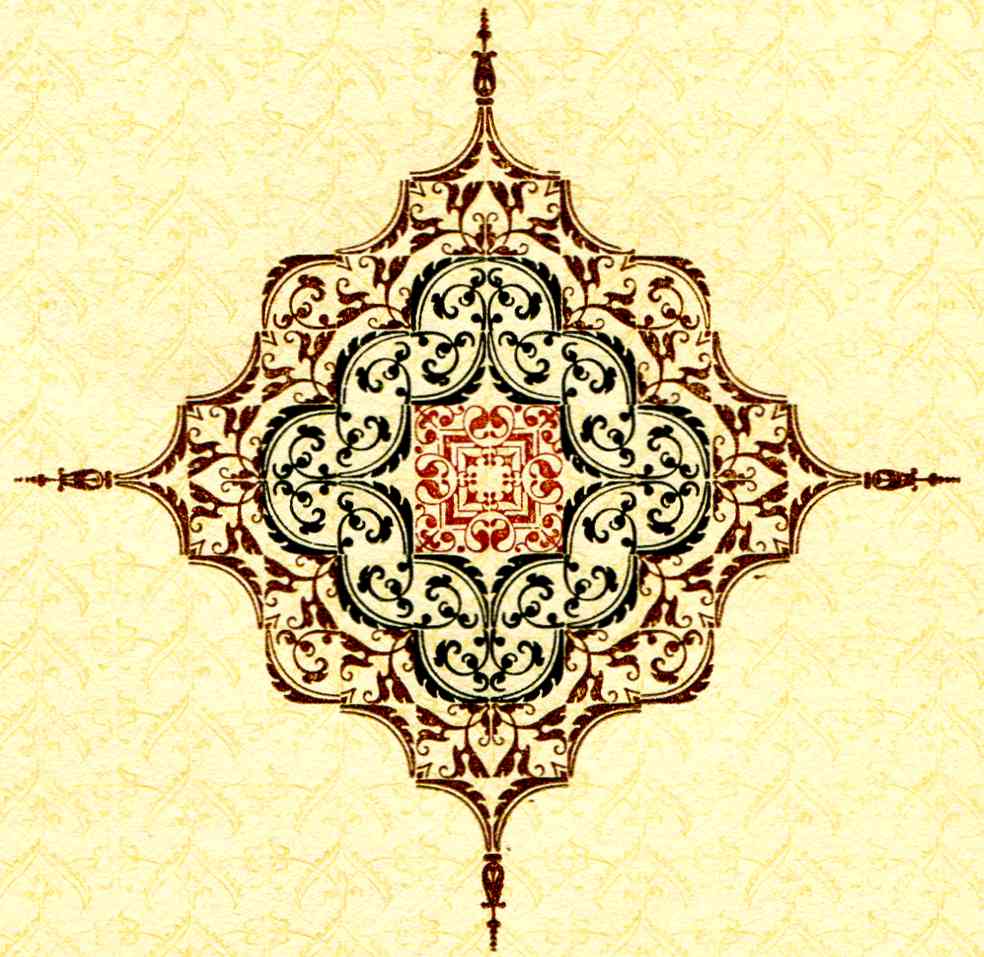
1978 Cobblestone Press design
JAN. 24 2021: PROSPECT POINT LIGHTHOUSE
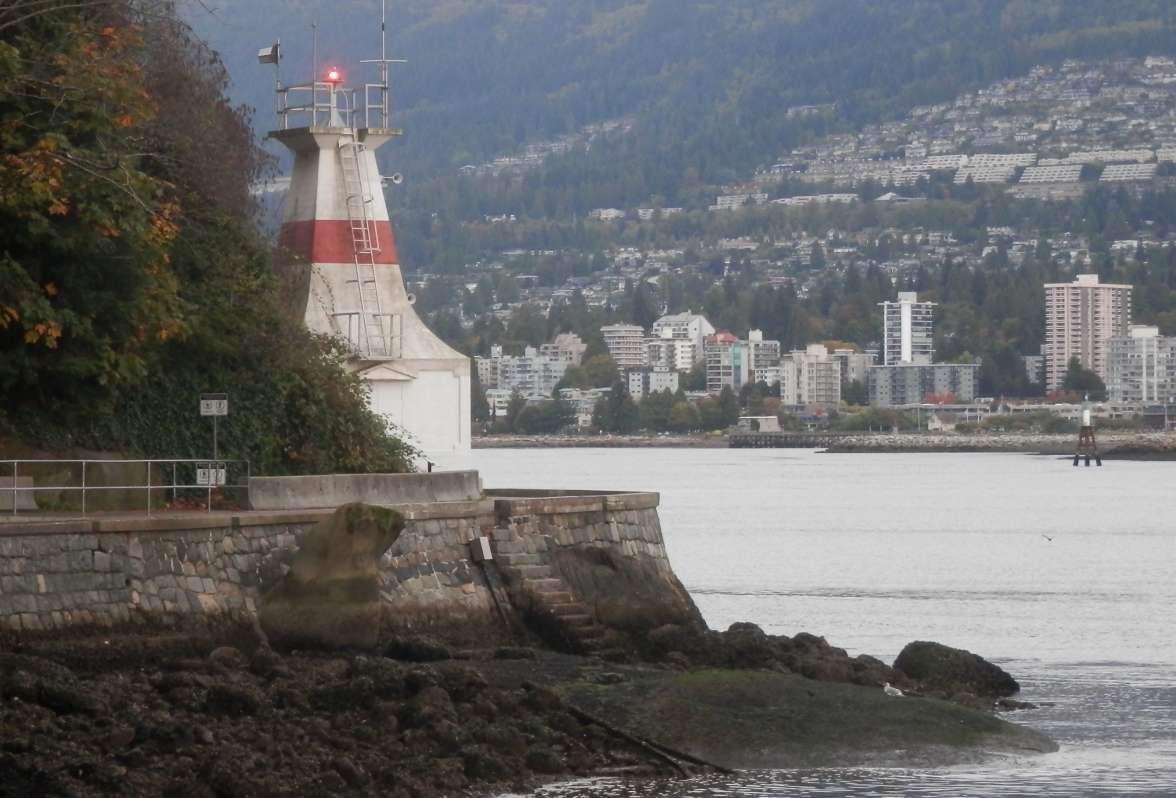
The lighthouse in 2020
The current Prospect Point lighthouse is seen here in late 2020. It was built on the
site of an earlier wooden lighthouse, which also had a lifeboat station. The lifeboat station
was built on the shoreline between the two large rock formations on either side of the
stairs leading down to the shore. The lifeboat was moved from the boathouse down to
the water on a pair of steel rails, which are still visible on the shoreline in
this picture, at the low tide line, more than 100 years later. The signal light
on the West Vancouver side of the First Narrows was a manned lighthouse for many
years before the automated signal was installed.
JAN. 22 2021: 1892-93 VICTORIA BUSINESS LEDGER
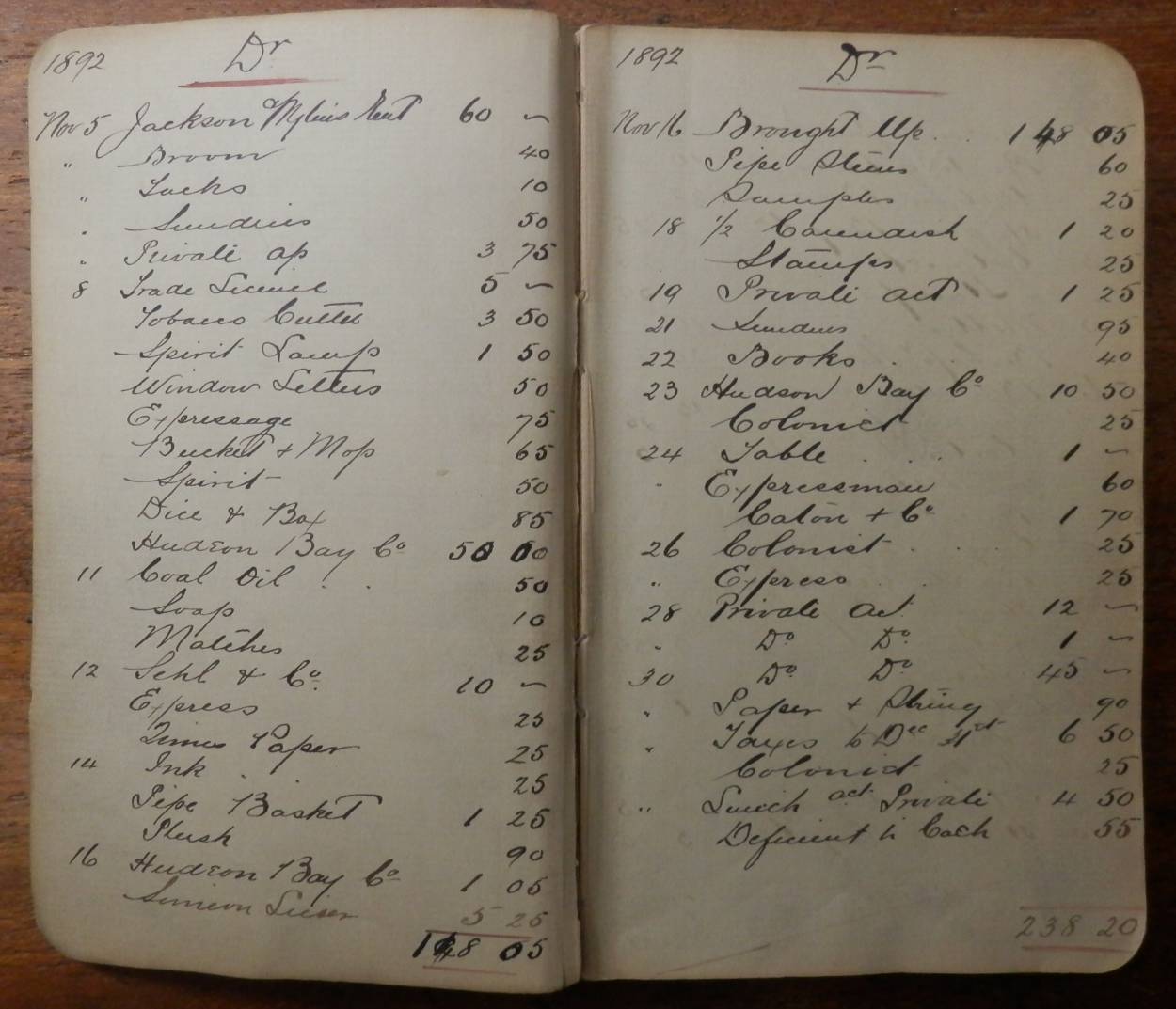
A page of accounts from 1892
I acquired this 1892-93 business ledger out of curiosity at an estate auction a number
of years ago. I found that there was a lot of information about Victoria from a long
time ago. Although I attempted to identify the ledger's owner, I did not confirm anything.
There are a lot of entries related to smoking, such as purchases of pipes, pipe stems, pipe racks,
tobacco, tobacco cutter, and cigars. Regular business expenses included "advertising
Chinaman" for 50 cents, sending a messenger for 15 cents, and hiring a watchman for 50 cents.
They purchased window signs and "tickets," a printing press for $10.00,
dice and box for 80 cents, and 500 manila envelopes for $1.15. One day they purchased salmon
for $5.30. There are a number of entries for purchases of either "Caton amber" or "amber Caton"
for $1.25, and I went online to try and hunt that down. A company in Catonsville, Maryland manufactured
ginger ale and sold it in an amber coloured bottle, with the name "CATON" embossed on the
bottle.

A hydro payment from 1893
There were a few entries for "electric light" bill payments. This image shows a payment for
two months, not one. Almost 130 years later my own electric bill is only twice what this one
was, despite the addition of all my modern conveniences: frig, stove, range hood, microwave,
toaster, tv, stereo, computers, printers, scanner, telephone, answering machine, electric
fan, and so on. I have donated this ledger to the City of Victoria Archives for their collection.
JAN. 17 2021: BUTTON BUTTON, WHO'S GOT THE BUTTON?
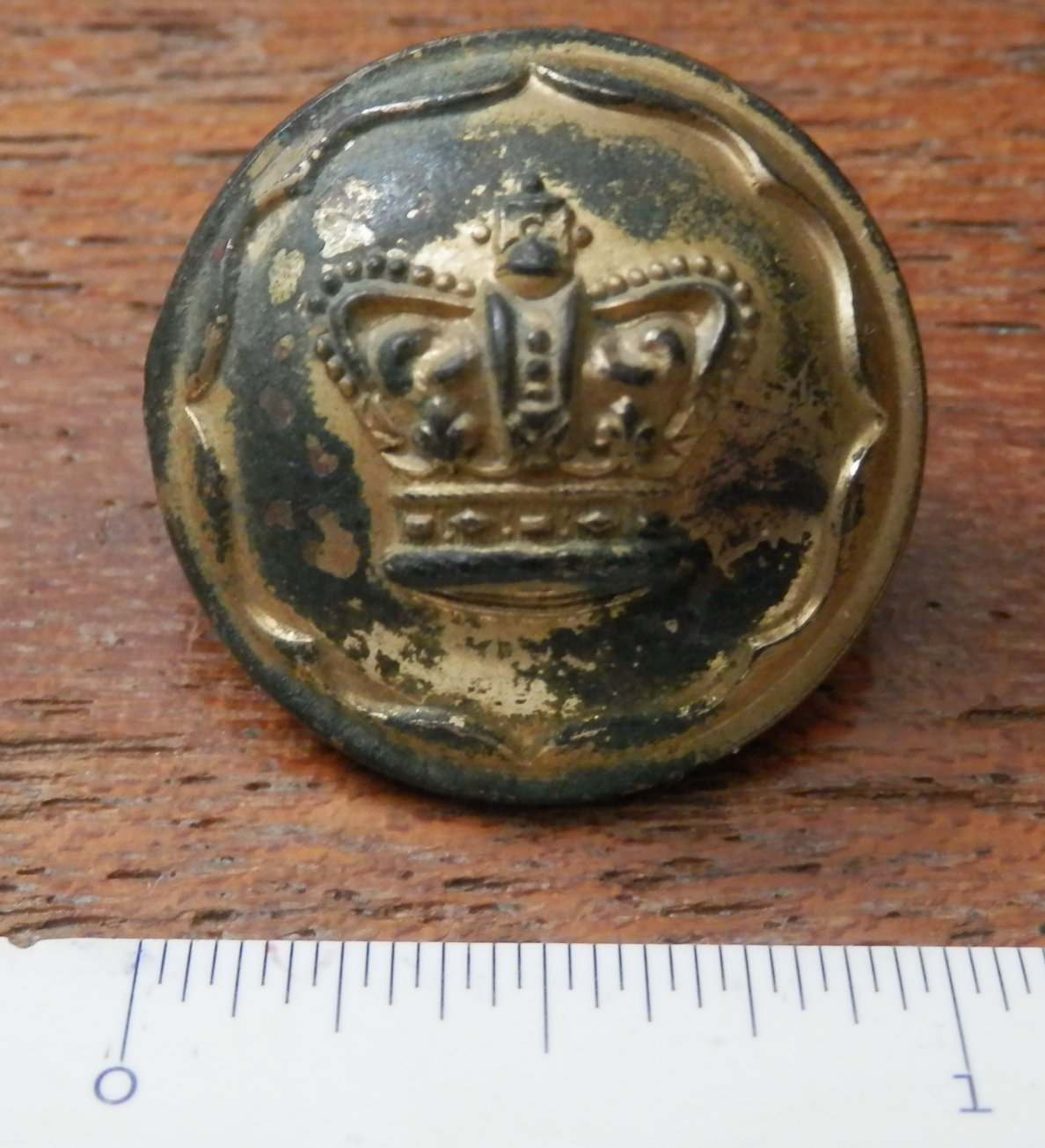
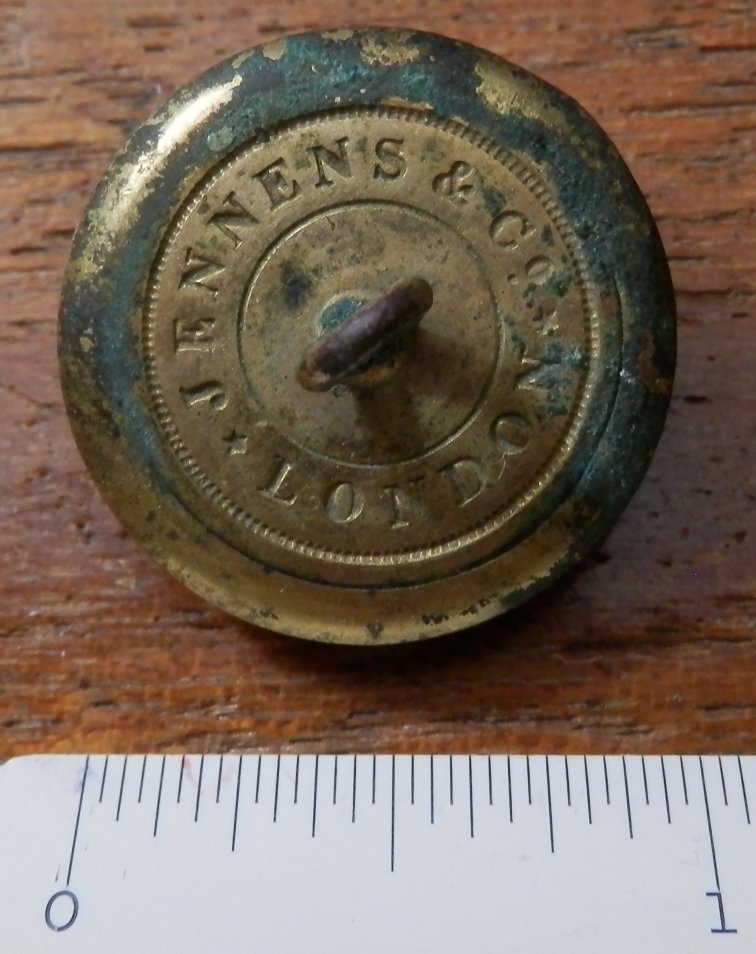
Jennens & Co. brass button c1832-1860
I found this brass button about 50 years ago. I had gone up to North Bend,
and taken the cable ferry across the Fraser River, intending to look for
soapstone on the banks of the Nahatlatch River. I found some nice pieces
to bring home, and also wandered along the west bank of the Fraser just
south of the confluence of the Nahatlatch. At that location, the river
bank was a black rock bench a little ways above the river, but within
high water mark. The solid rock bench was covered with another layer of
rock, broken up into small rocks but essentially still in place. In
between these rocks was just enough space to put my feet down to the
solid rock so that I could walk safely.
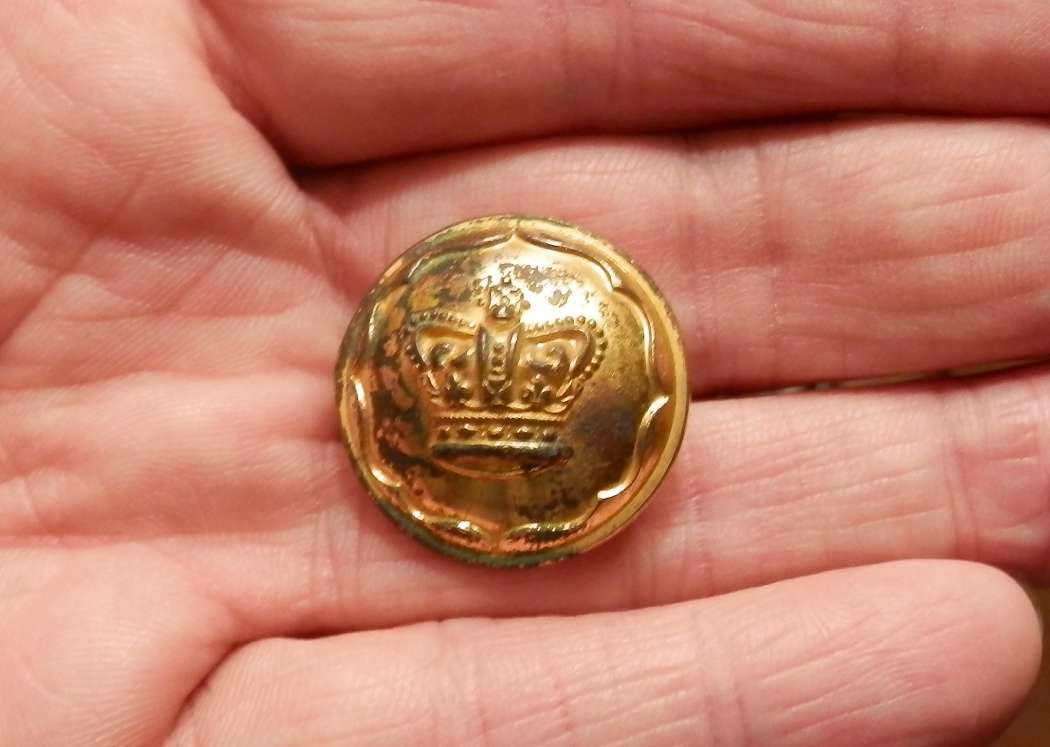
Jennens & Co. brass button c1832-1860 after a bit of soap and water
I caught a flash of gold in between the small rocks as I walked, and
picked up this button. It definitely seemed like an unusual find, and
appeared to be in good condition. I took it home, and it sat around in
one drawer or box or another over the years. Every so often I'd look
at it and think about identifying it. Of course there was no Internet
50 years ago!
Anyway, I came across it again recently, and decided to see what I could
find out. I discovered a web site in England that has an extensive list
of button-makers and their back-marks. Since my button has the text
"Jennens & Co. London" on the back, I quickly found it in the list.
Although this button maker began business as Messrs. Jennens & Co.
in 1800, and is still active today as J.R. Gaunt and Son, the text
on my button was only used on buttons made between 1832 and 1860.
The button is solid brass, and weights 7.7 grams. All of the 100 year old
dirt on the button could be removed, it's actually in excellent condition.
So, the button may have been sitting on the bank of the river for 110 years
when I found it, and in any case it is now between 160 and 190 years old!
My original theory was that it is a button from the British Royal Engineers, who
worked to build the Cariboo Road through the Fraser Canyon in the 1850s. Now that
the date of manufacture is confirmed to be contemporary with the Engineers in B.C., it's
just a matter of confirming what uniform this button would have been attached to.
Identification of the crown might narrow down the date range of manufacture.
Perhaps there is an Engineer's diary somewhere that notes "Drat, lost one of my
uniform buttons today alongside the Fraser River, but couldn't find it and had
to keep going."
UPDATE: I got in touch with the Royal B.C. Museum in Victoria, and I will be
sending this as a donation to them. It turns out they have a very limited collection of Engineer's
uniforms, in fact the only original one they have is Joseph Pemberton's own uniform.
2nd UPDATE: To my surprise the RBCM sent me a tax receipt for their appraised
value of the button: $100.00.
NOV. 21 2020: B.C. SOCIETY OF ARTS EXHIBITION CATALOGUES
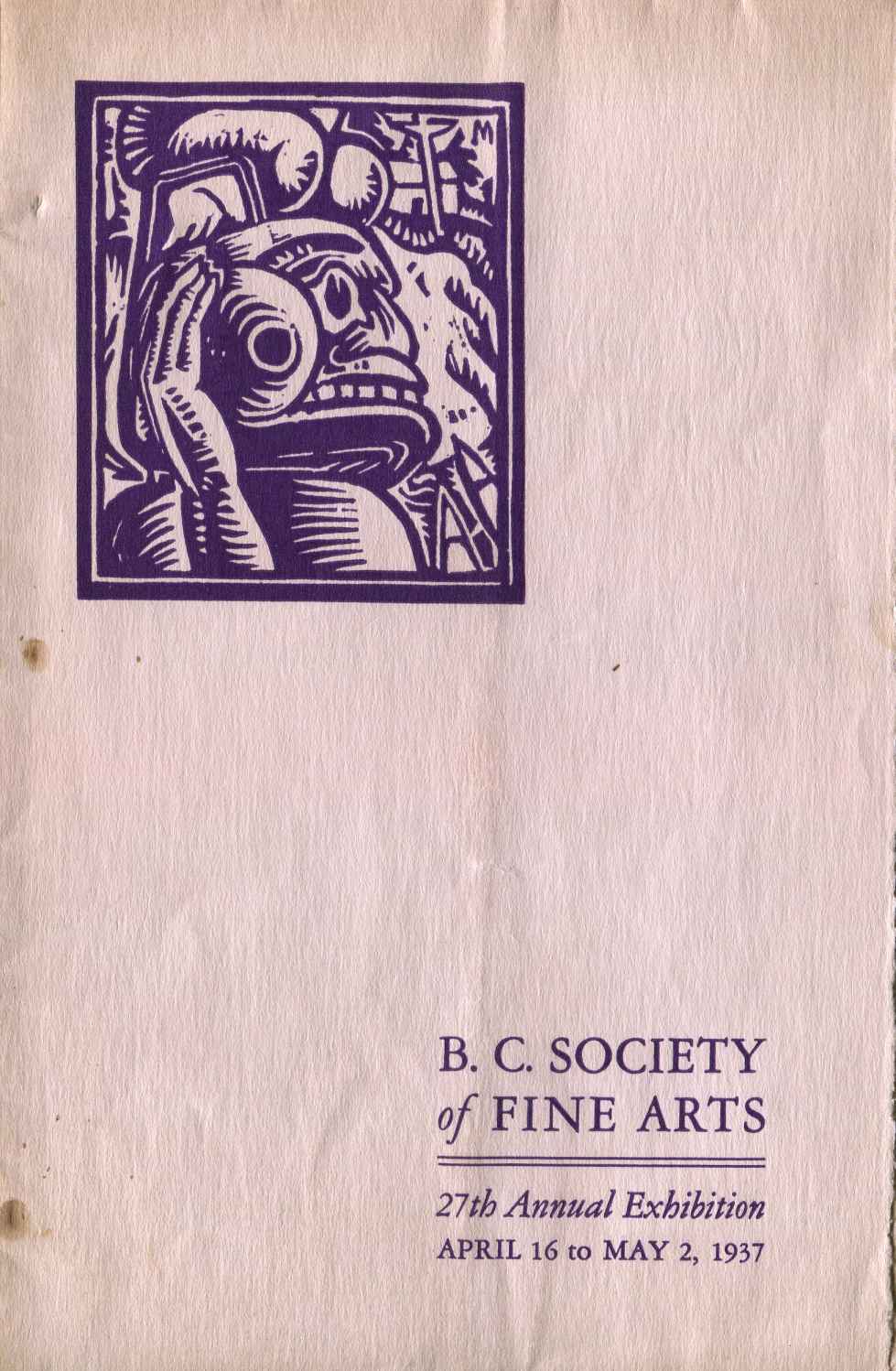
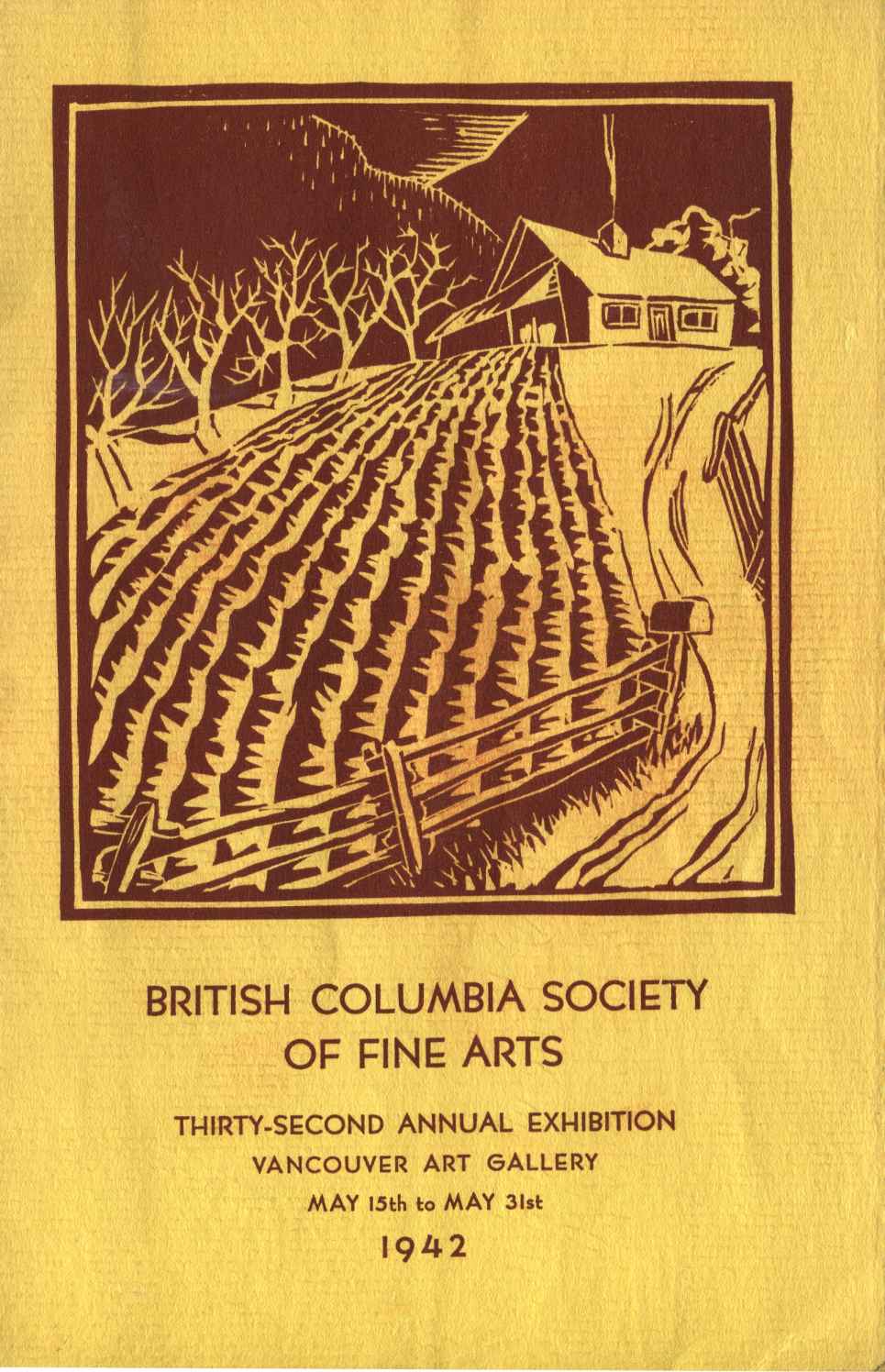
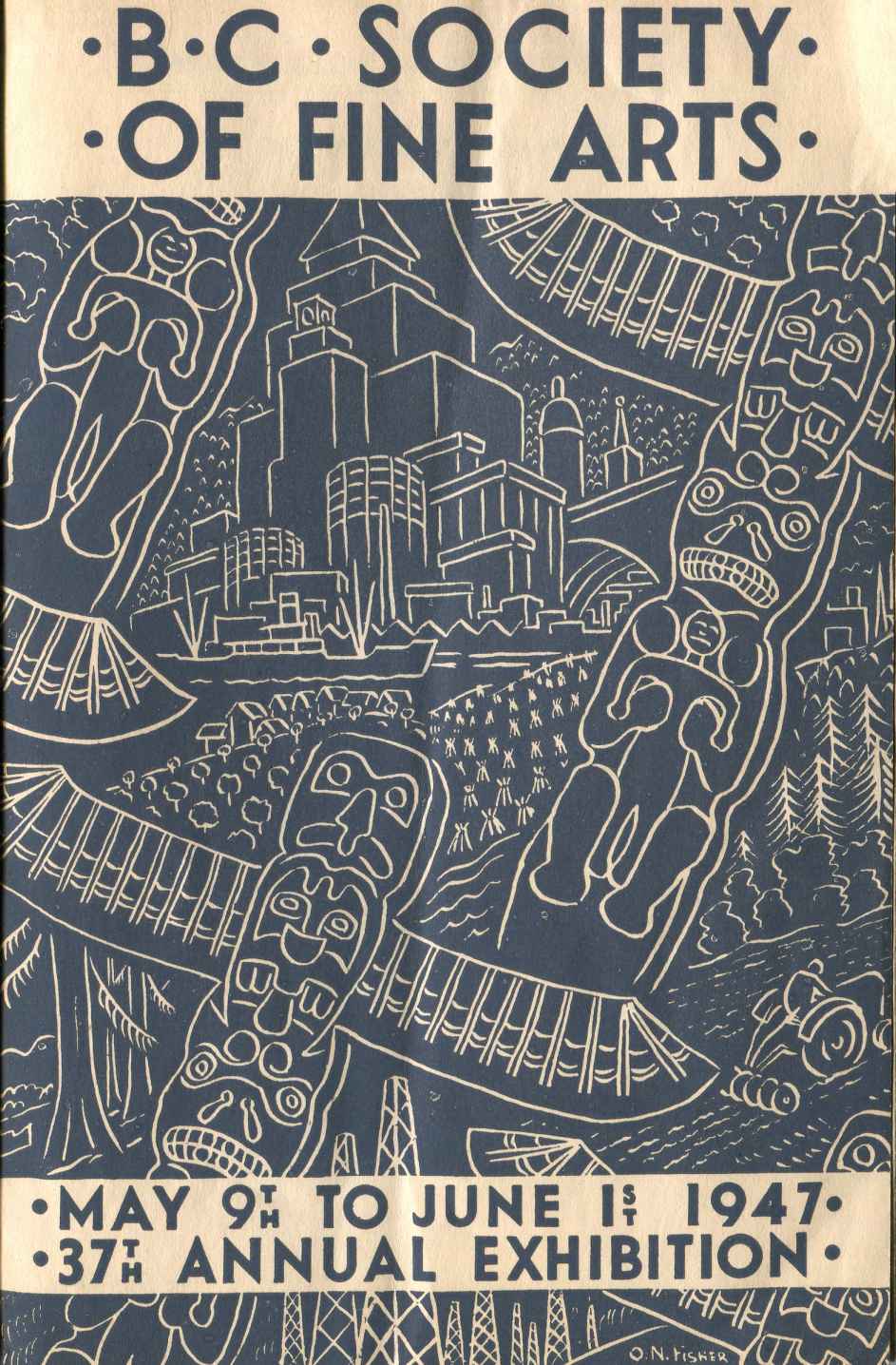
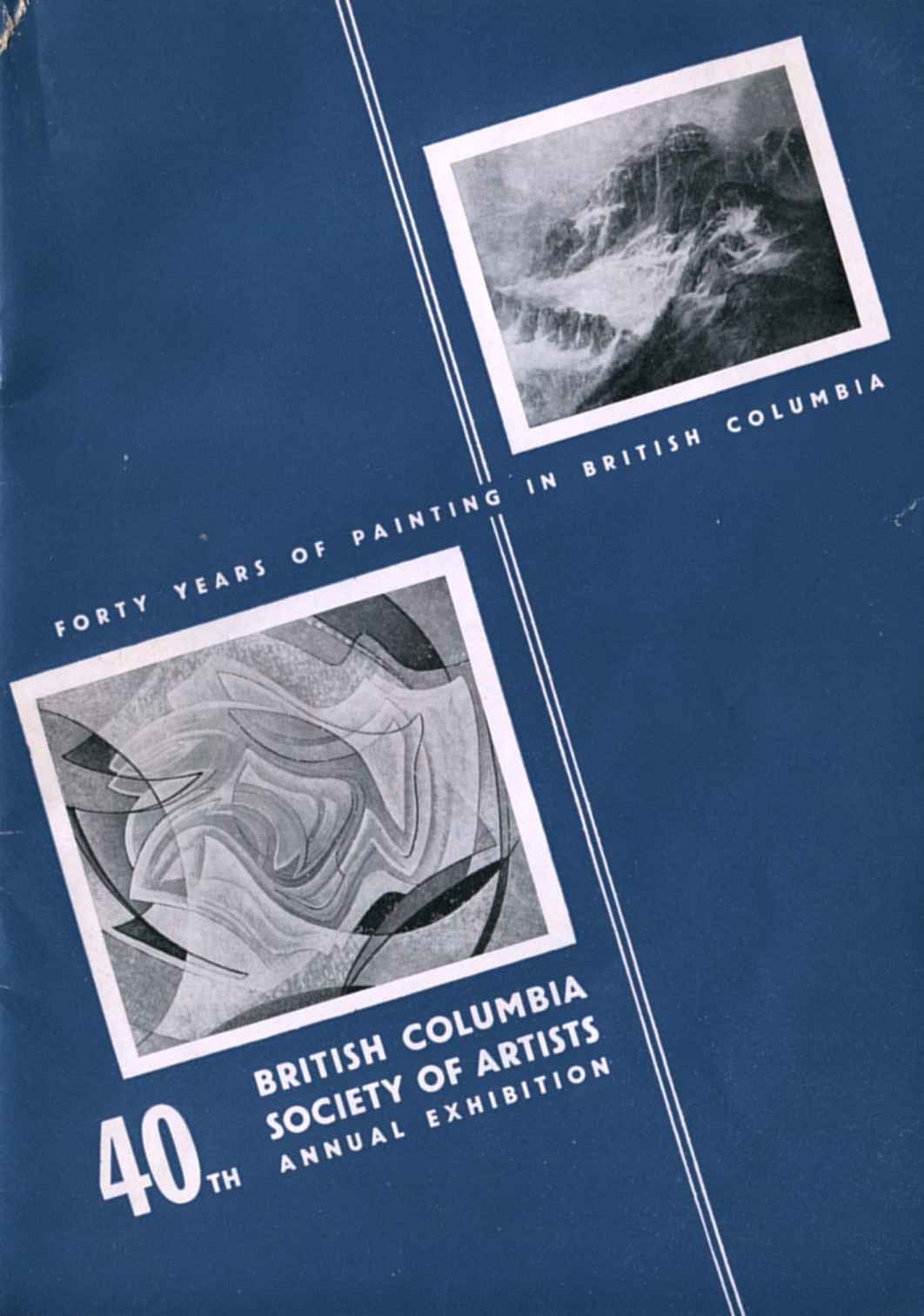

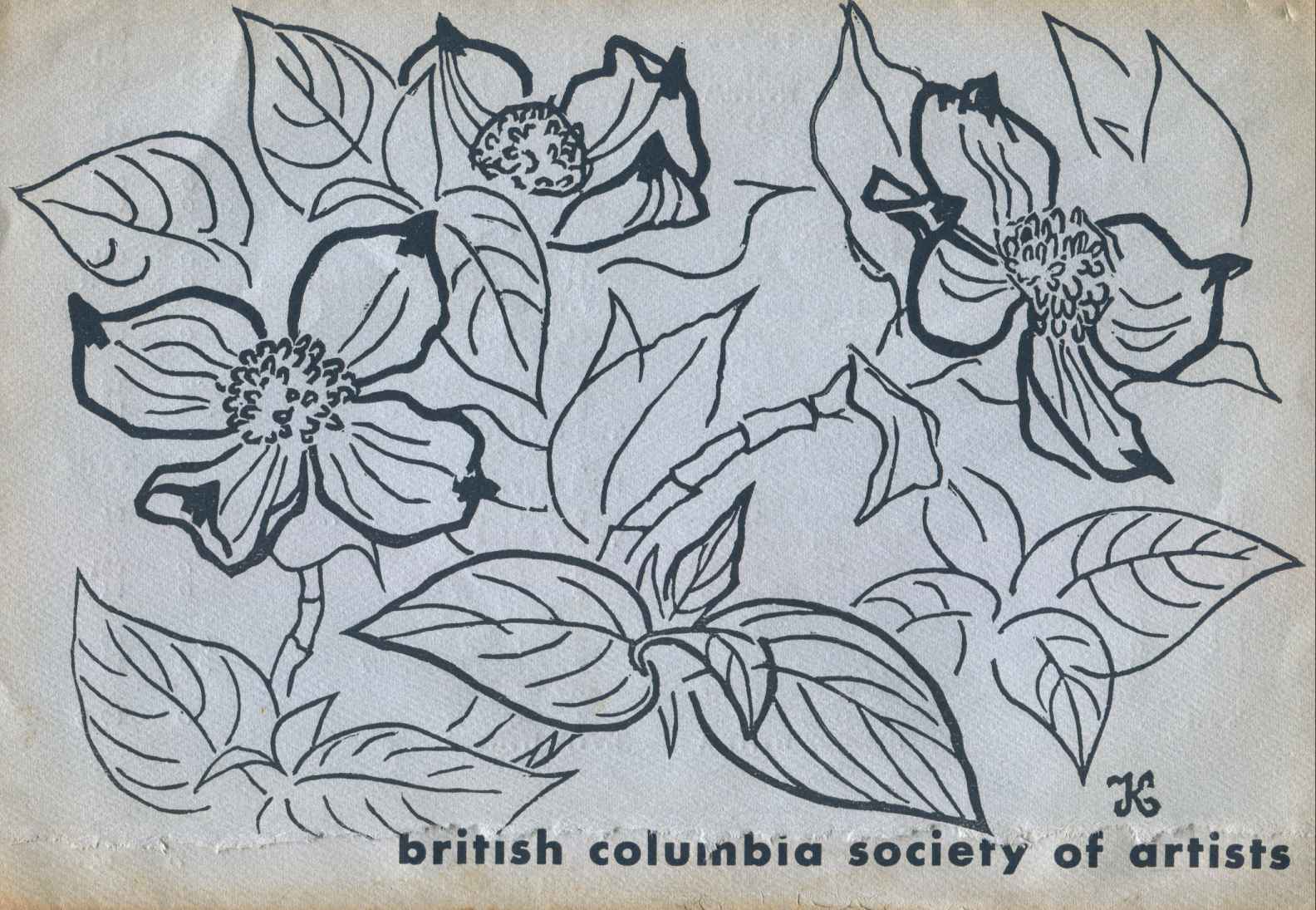
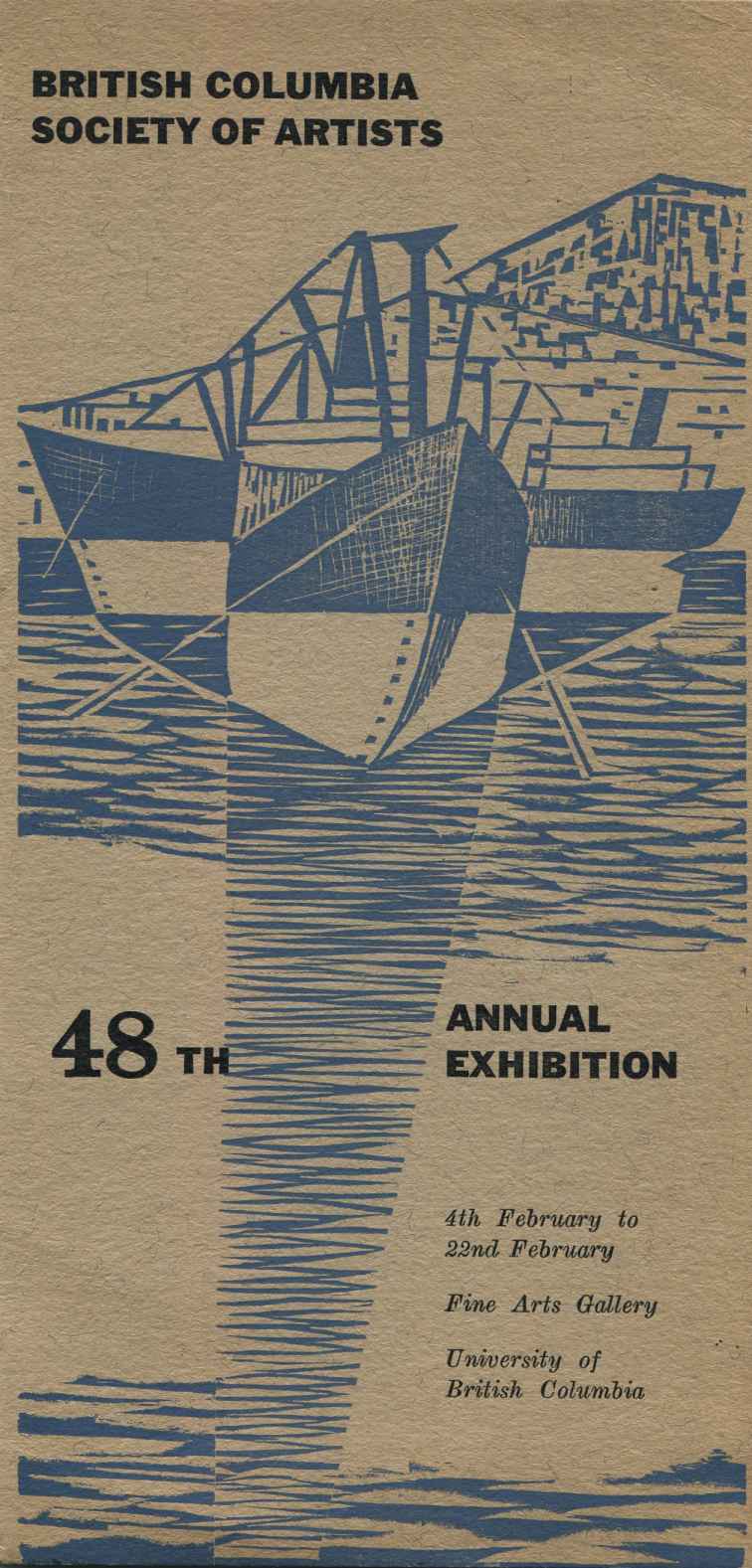
A sample of exhibition catalogue covers 1937-1958
I was recently given a number of early art exhibition catalogues, and
these are ones published by the B.C. Society of Fine Arts,
later the B.C. Society of Artists.
JUNE 29 2020: HARDING MEMORIAL, STANLEY PARK
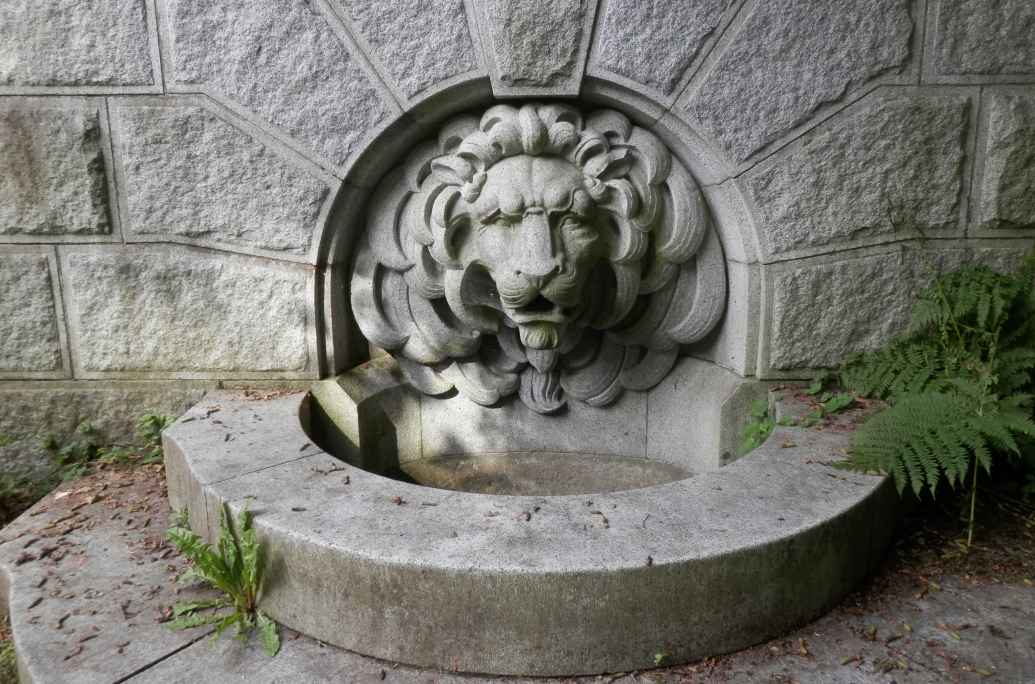
Back of Harding Memorial, Stanley Park
This lion on the back side of the memorial to USA President Harding used to spout
water from its mouth. The memorial was dedicated in 1925, following the 1923 state visit by
Harding. This lion, and the sculptures on the front side of the memorial, were all
created by Vancouver sculptor Charles Marega. This is
one of my favorite "hidden" sculptures in Vancouver, up until recently it was almost
entirely covered by overgrown bushes.
JUNE 29 2020: ABANDONED BEAR PITS, STANLEY PARK
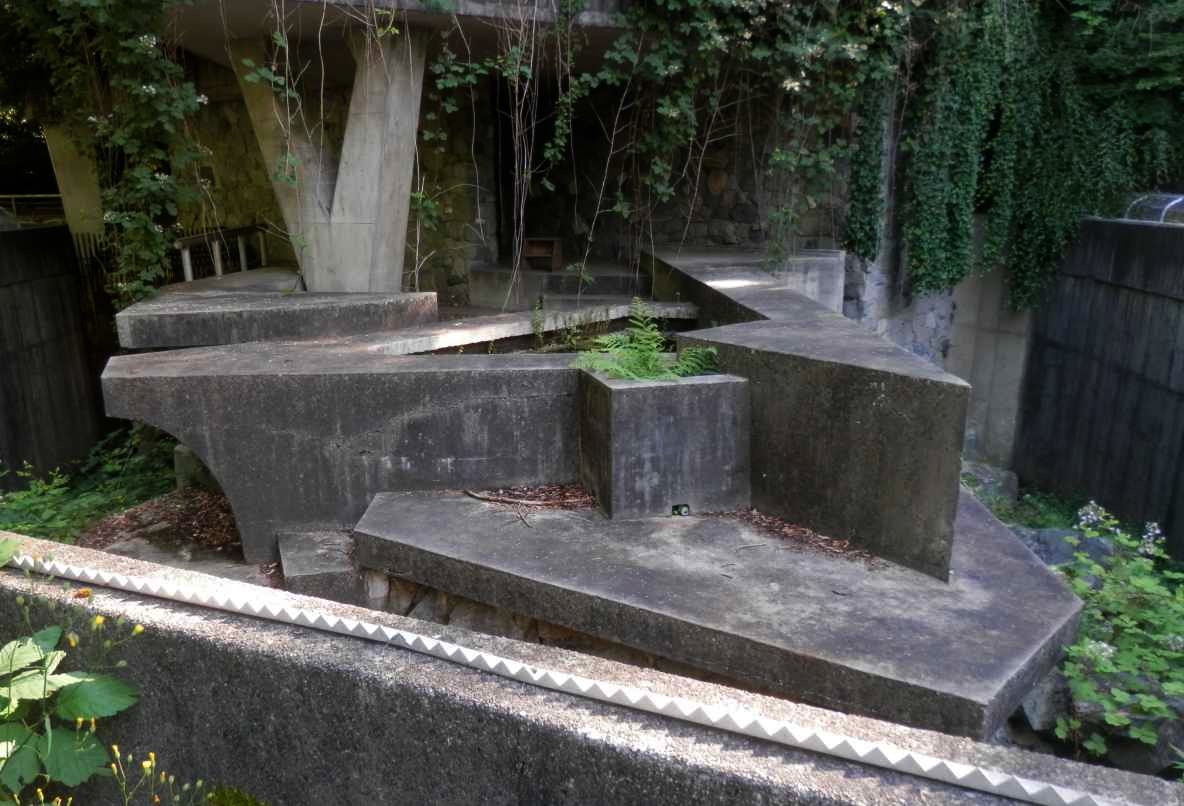
Abandoned Bear Pit 1, Stanley Park
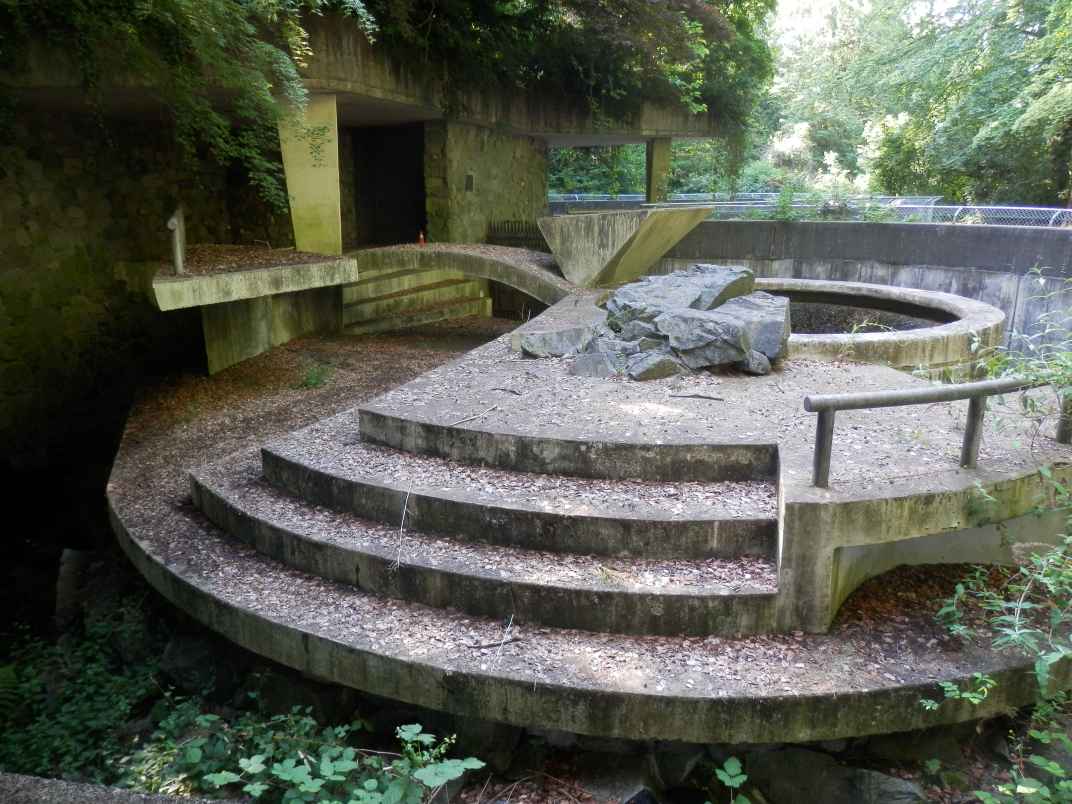
Abandoned Bear Pit 2, Stanley Park
The bear pits were apparently constructed around 1961 to house live bears. The last
polar bear died in 1996, after which the bear pits were abandoned. In 2020 they were still
there, looking a little like a post-apocalyptic military installation. These would make
an interesting location to present a play or a musical performance.
JUNE 1 2020: LANDMARK HOTEL ON ROBSON STREET
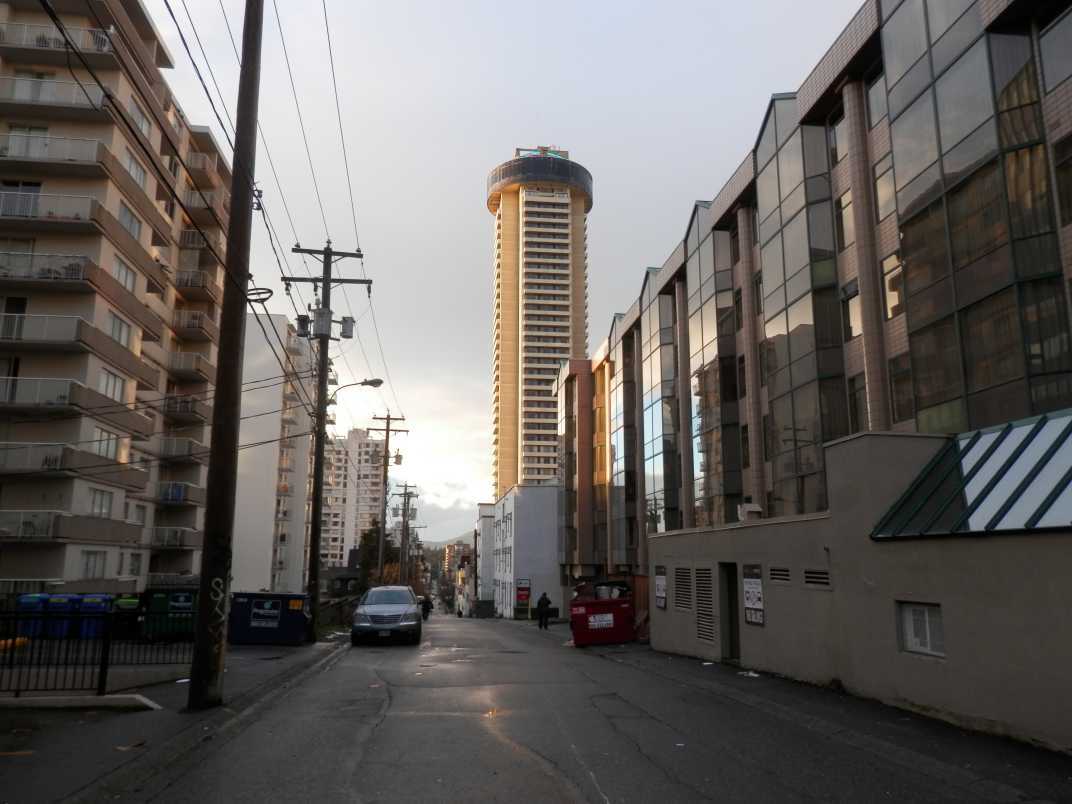
Landmark Before Demolition 2017
What was originally known as the Sheraton Landmark Hotel was built at 1440
Robson Street in 1972-73 for developer Ben Wosk. The 42-story building was
designed by local architects Lort and Lort, a father and son team of
Ross Lort and William (Billy) Lort. Ross Lort
was an early partner of Samuel Maclure.
The building was designed with a rotating restaurant on the top floor, known
as Cloud 9. Eating there was an interesting experience, I think it took about
an hour to rotate a full circle, and I could watch my neighbourhood far below
spin in and out of sight between dinner and dessert.
Another design feature of the original Robson Street facade was a wall at
the main entry composed of rock samples from around the Province, set like a huge
mosaic. Years later the facade was extensively clad in glazing panels and the rocks
disappeared from sight. Somebody put up handbills asking for information about it,
but in any case once the hotel was demolished it became a somewhat moot point.
The hotel eventually sold to Asian interests, and was renamed the Empire
Landmark. A huge collection of hideous neon lighting was installed on the roof, to the
horror of almost the entire West End. Many complaints were made, it turned out
it was done without a permit, and eventually they were forced to reduce the amount of
new neon lighting. Well, it's all gone now.
For demolition, I was hoping for an implosion, but they decided to chew it down. A
type of mobile hydraulic concrete breaking machine was taken up into the building.
For months that thing vibrated the entire neighbourhood, it was really loud. The
chunks of concrete were dumped down the elevator shafts. Eventually the tower was
chewed down into the ground and out of sight. The underground parkade walls were
left for slope retention as they kept digging for the new footings. They went
down ninety feet at the high end of the block, then it was time start building again.
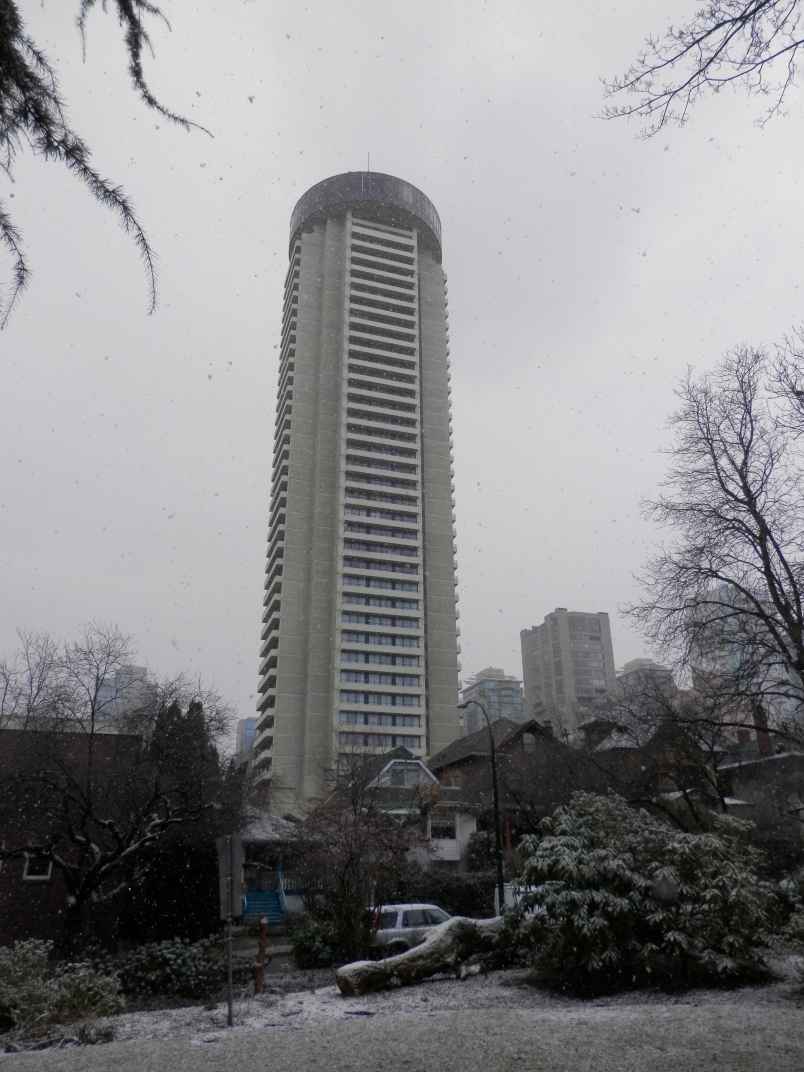
Empire Landmark seen from Barclay Park on Haro St., Feb. 28 2017
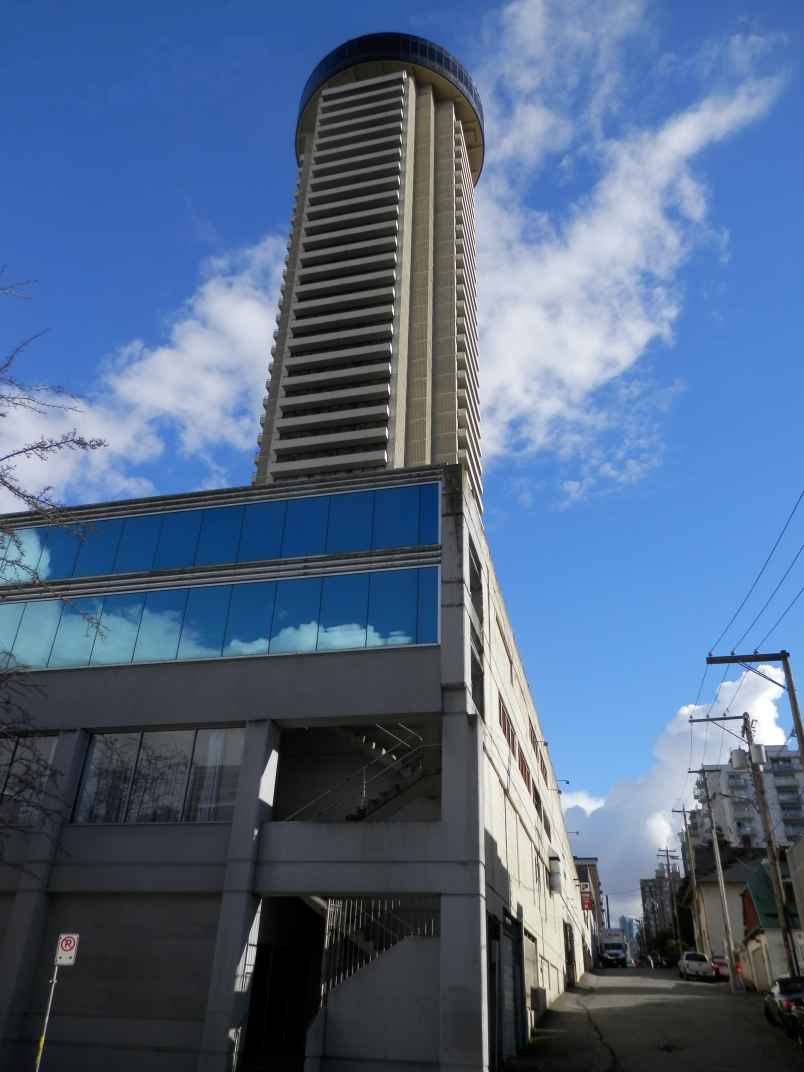
Empire Landmark seen from Nicola St., Feb. 22 2017
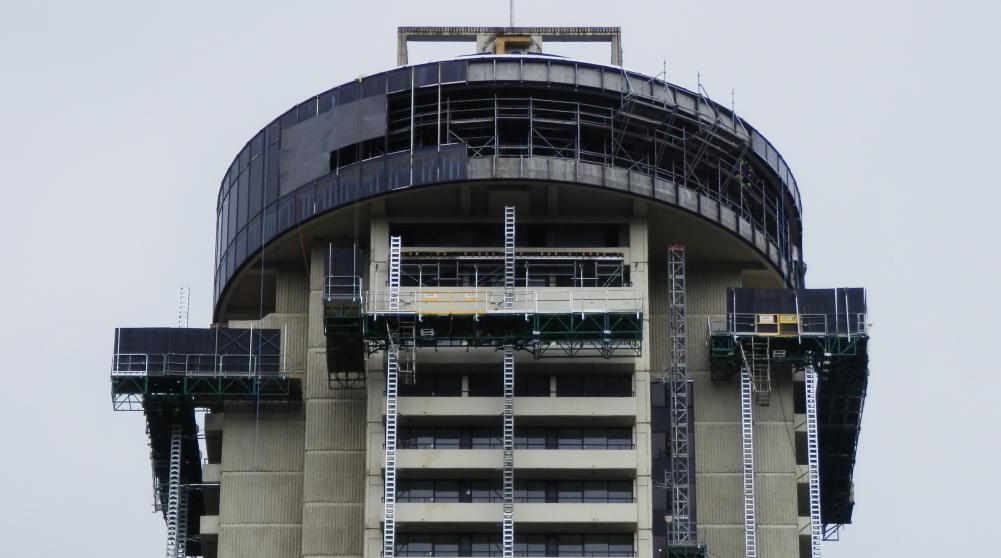
Stripping the building prior to crushing
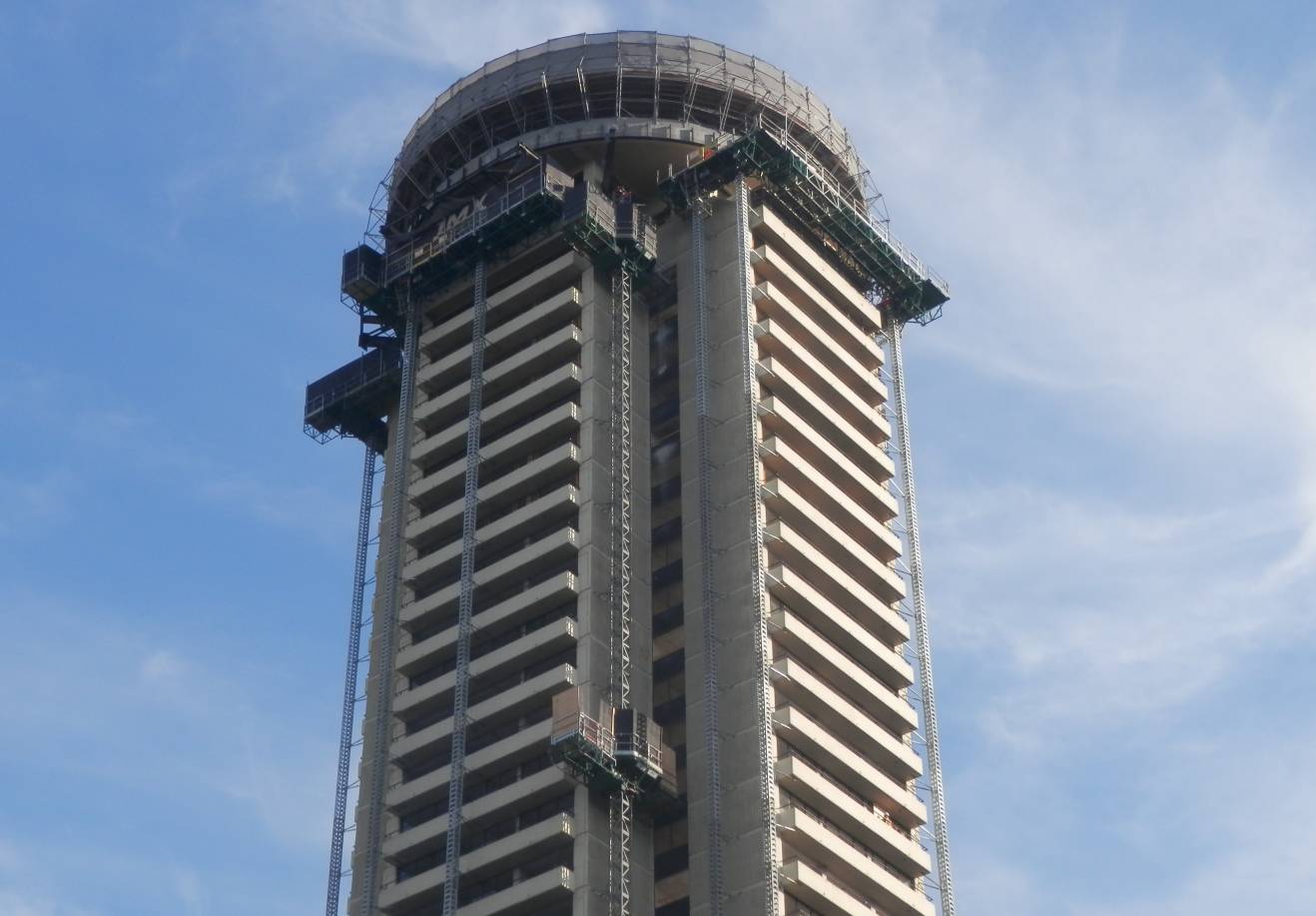
Deconstruction in progress
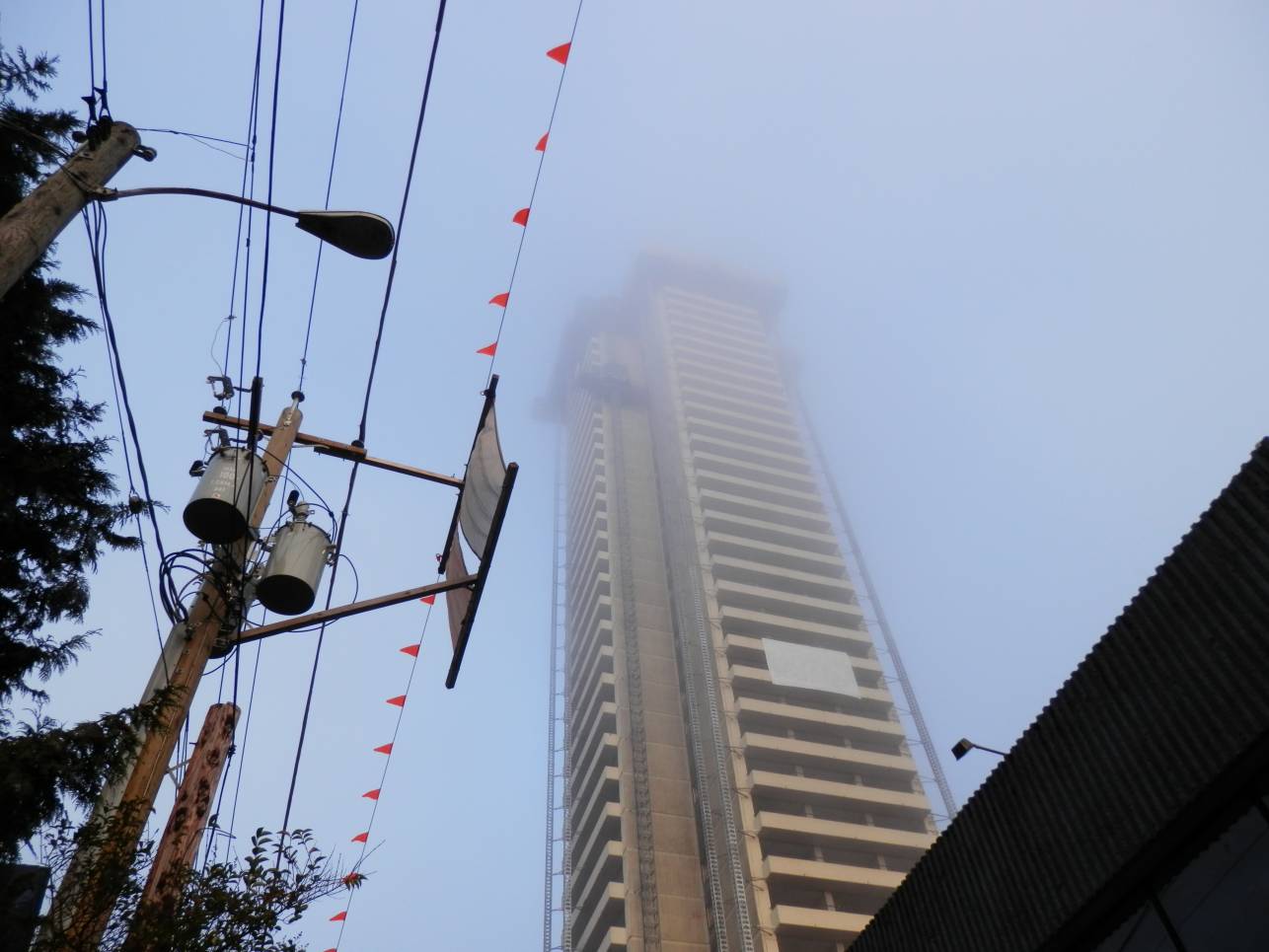
An interesting view in the fog
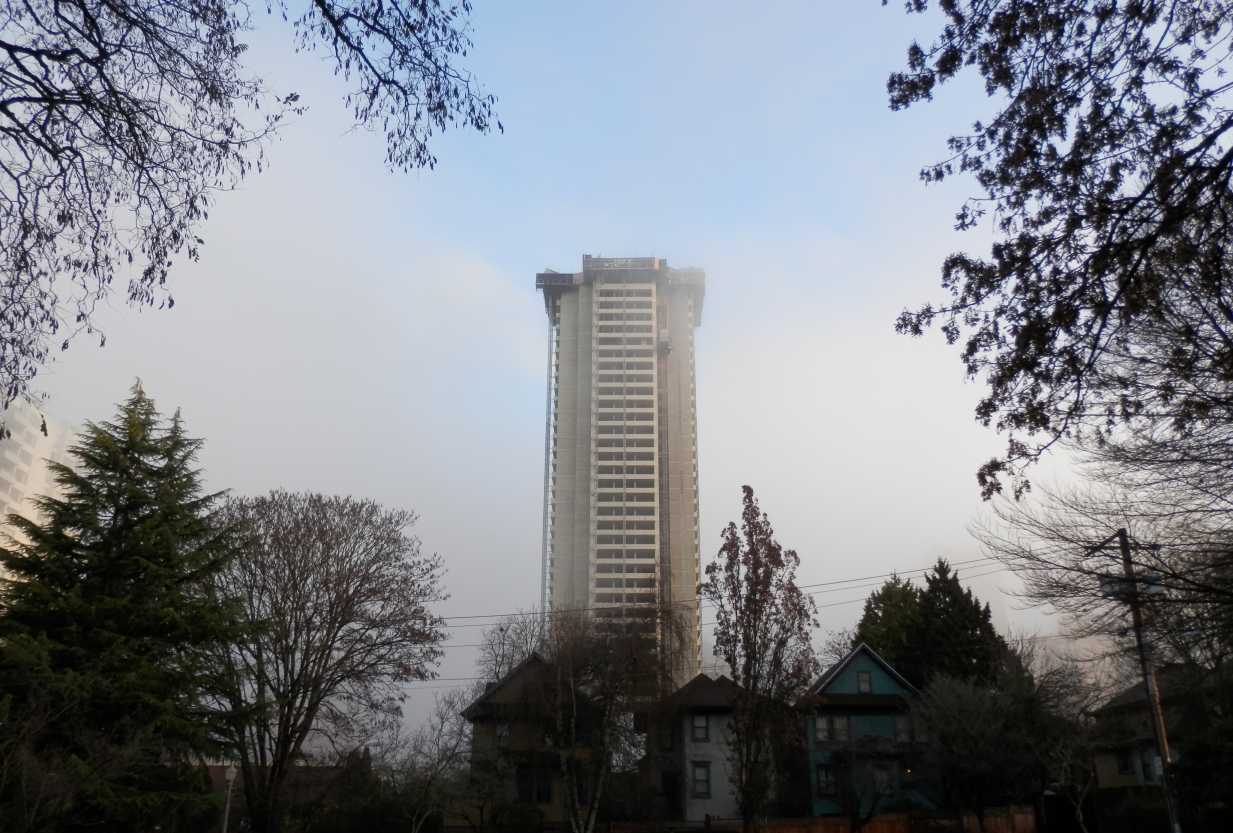
Another view in morning fog, Cloud 9 is gone
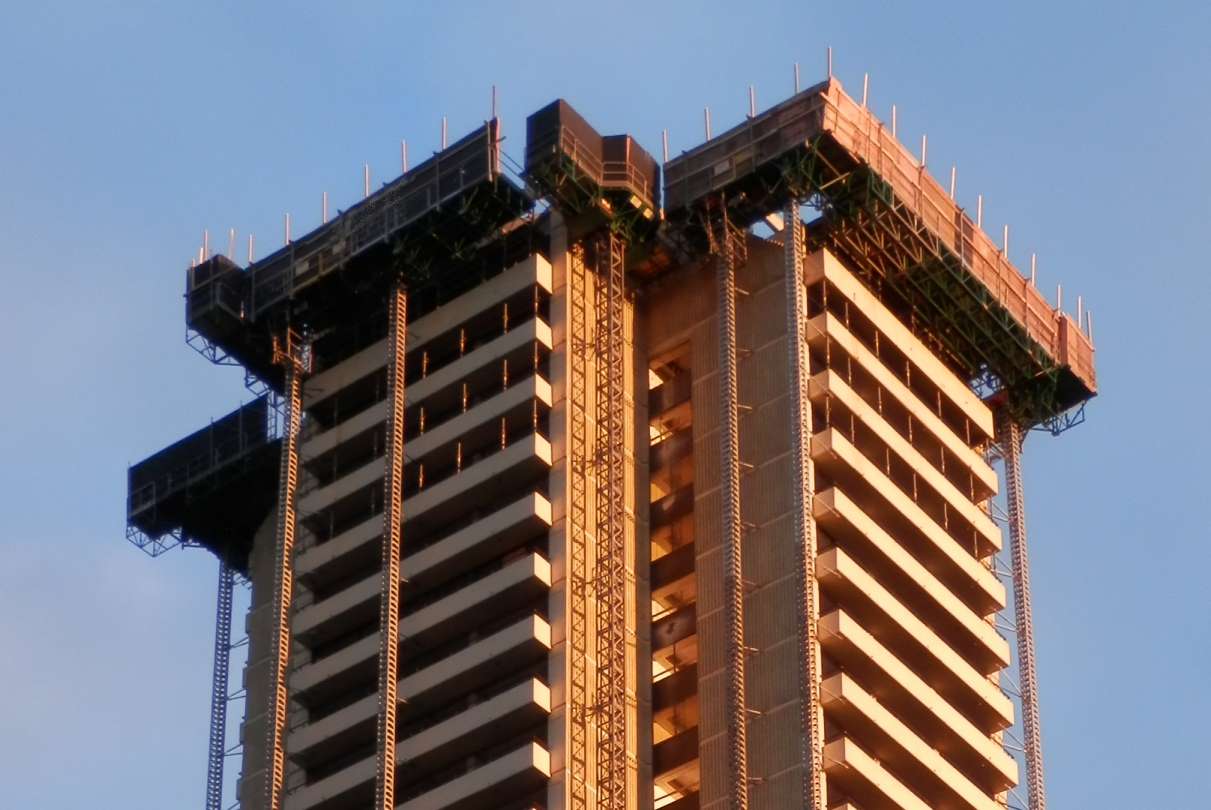
Detail view, the tower is about half gone
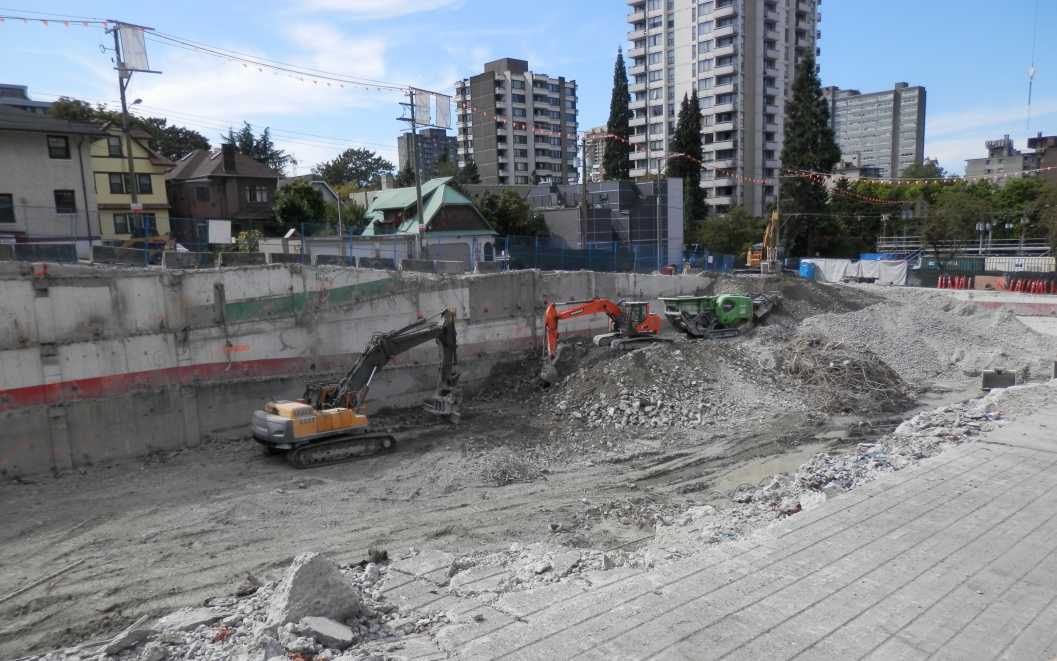
A view of the last piles of rubble being crushed and trucked away
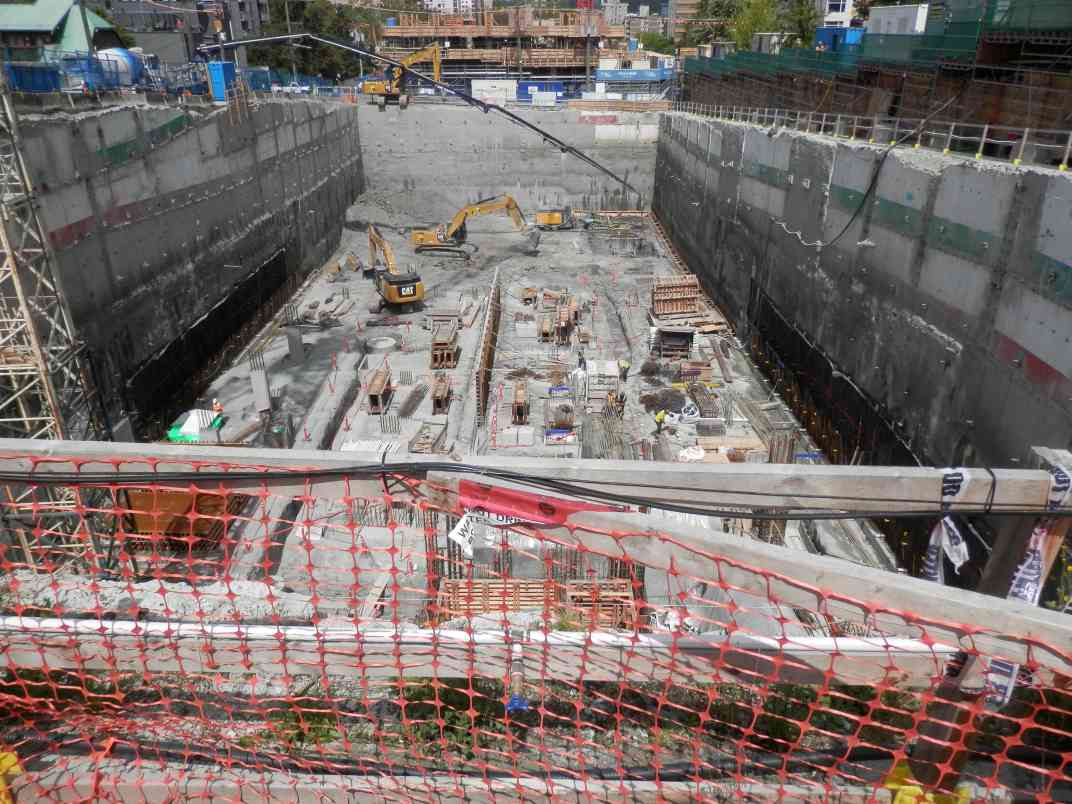
After demolition and excavation 2020
APRIL 12 2020: WHEN COVID CAME TO ROBSON STREET
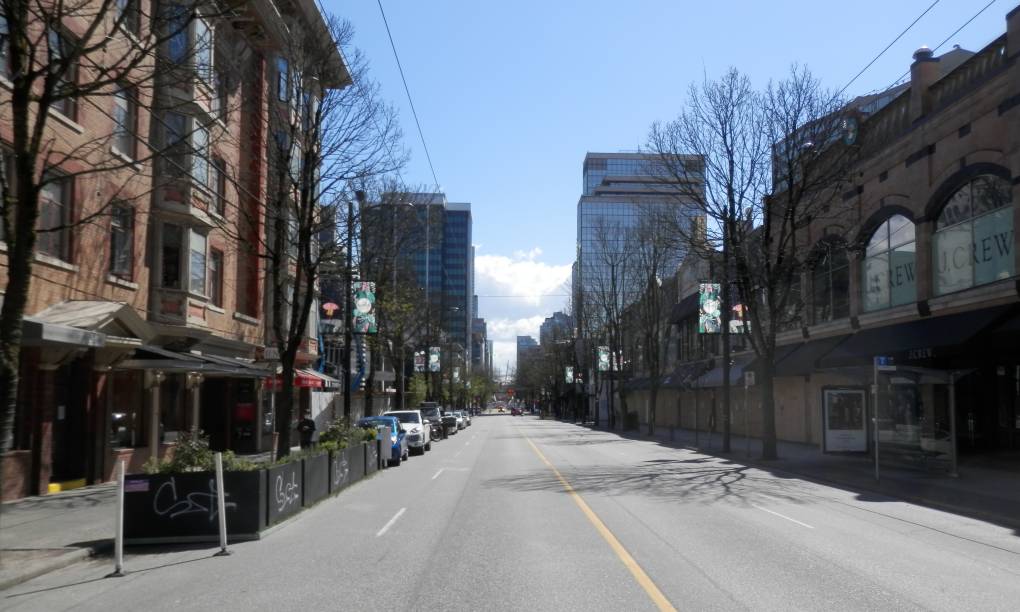
When the Virus Came to Robson Street
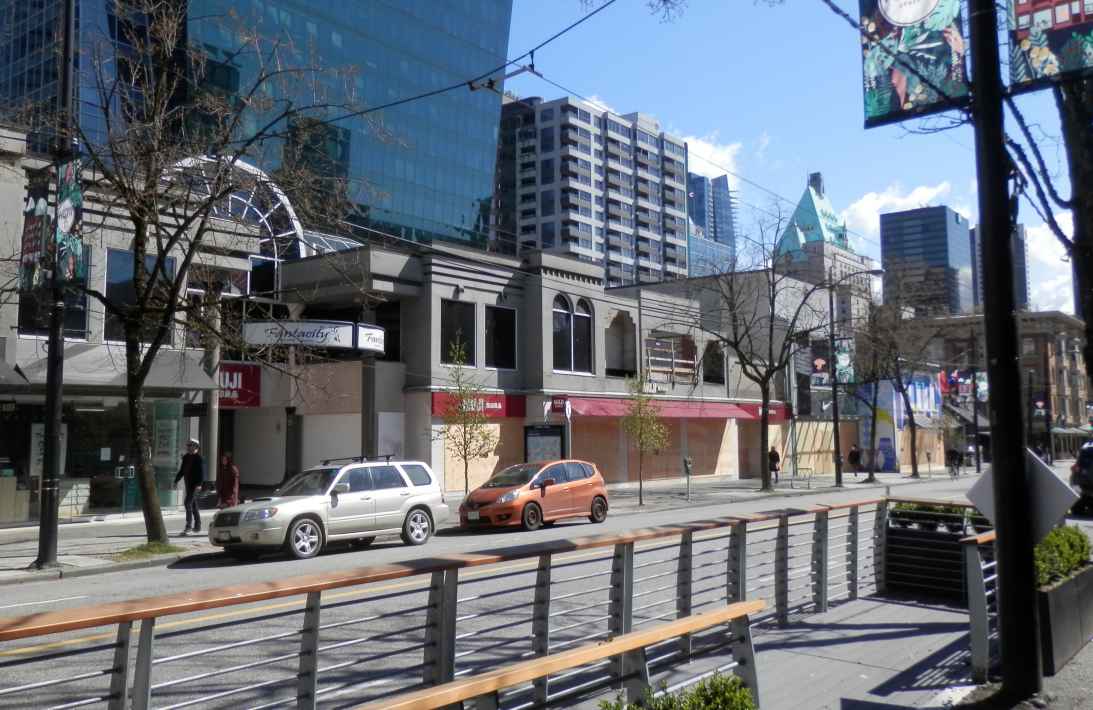
Closed
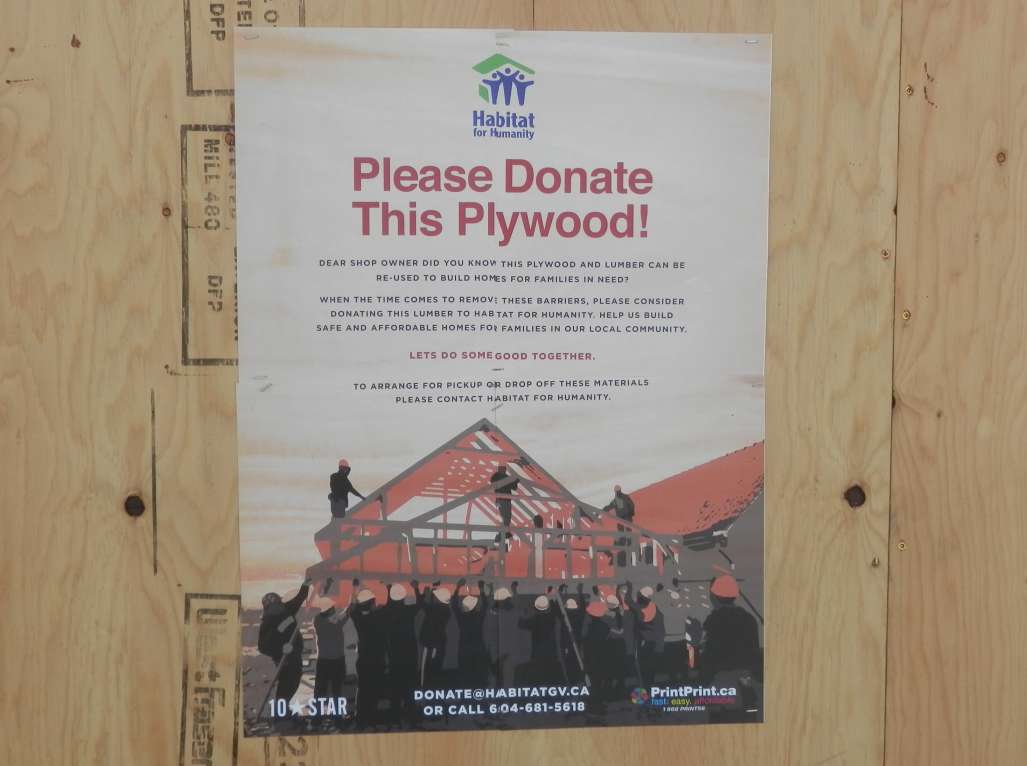
Please Donate
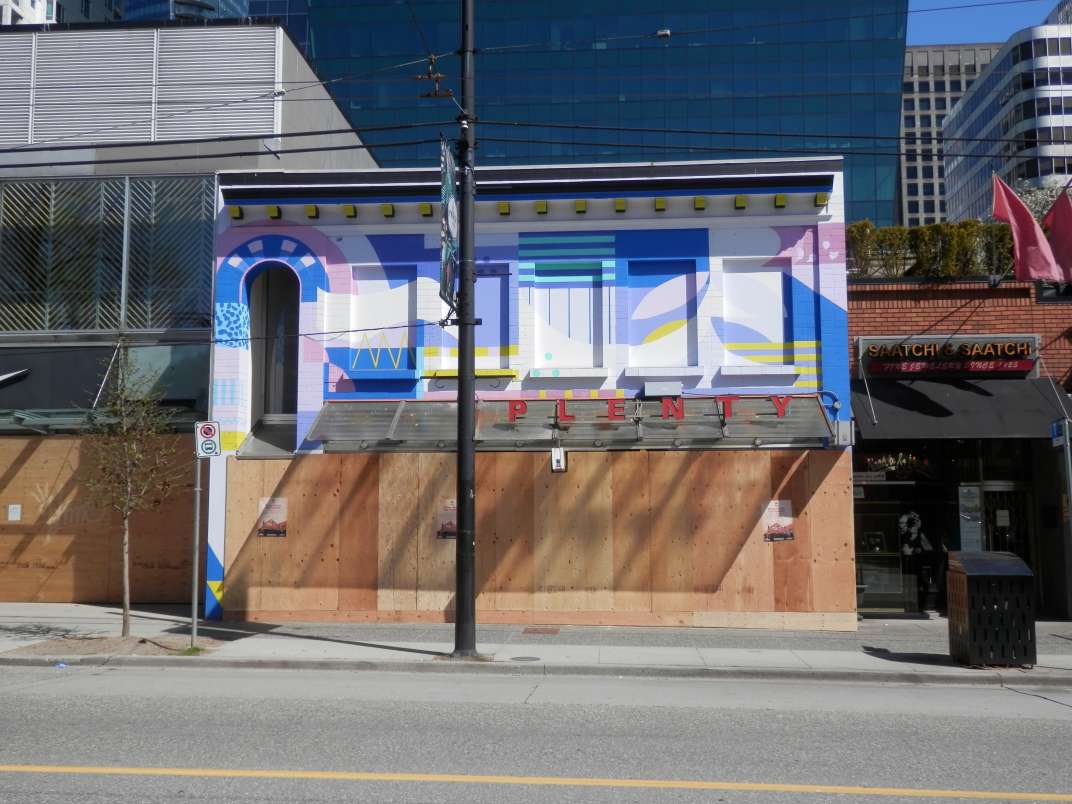
Land of Plenty
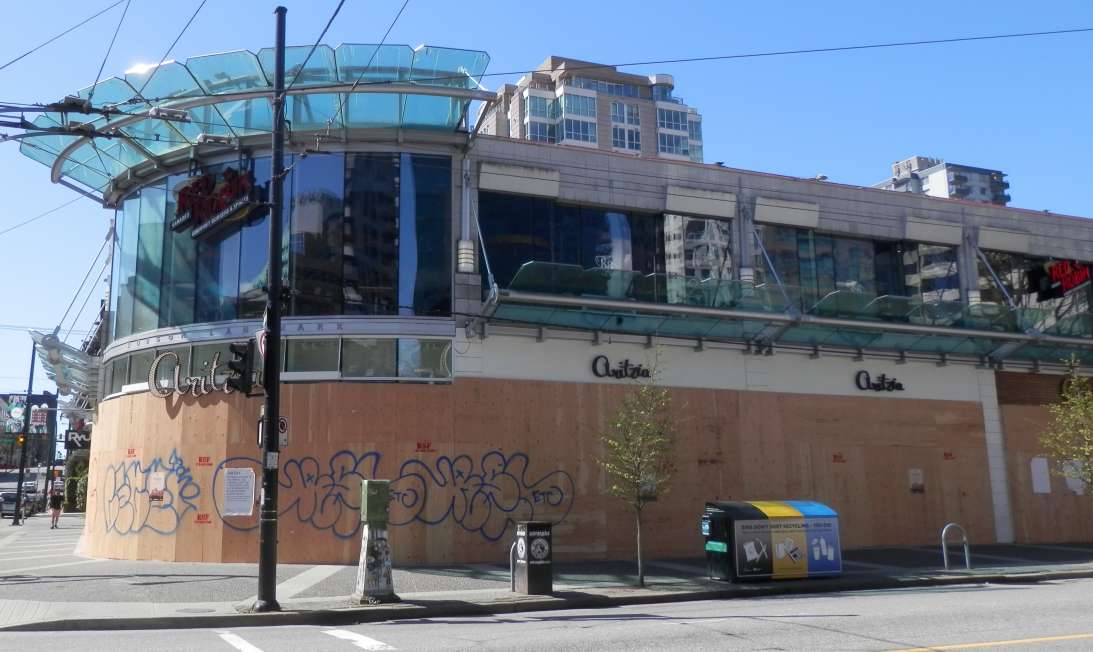
After the COVID Riot
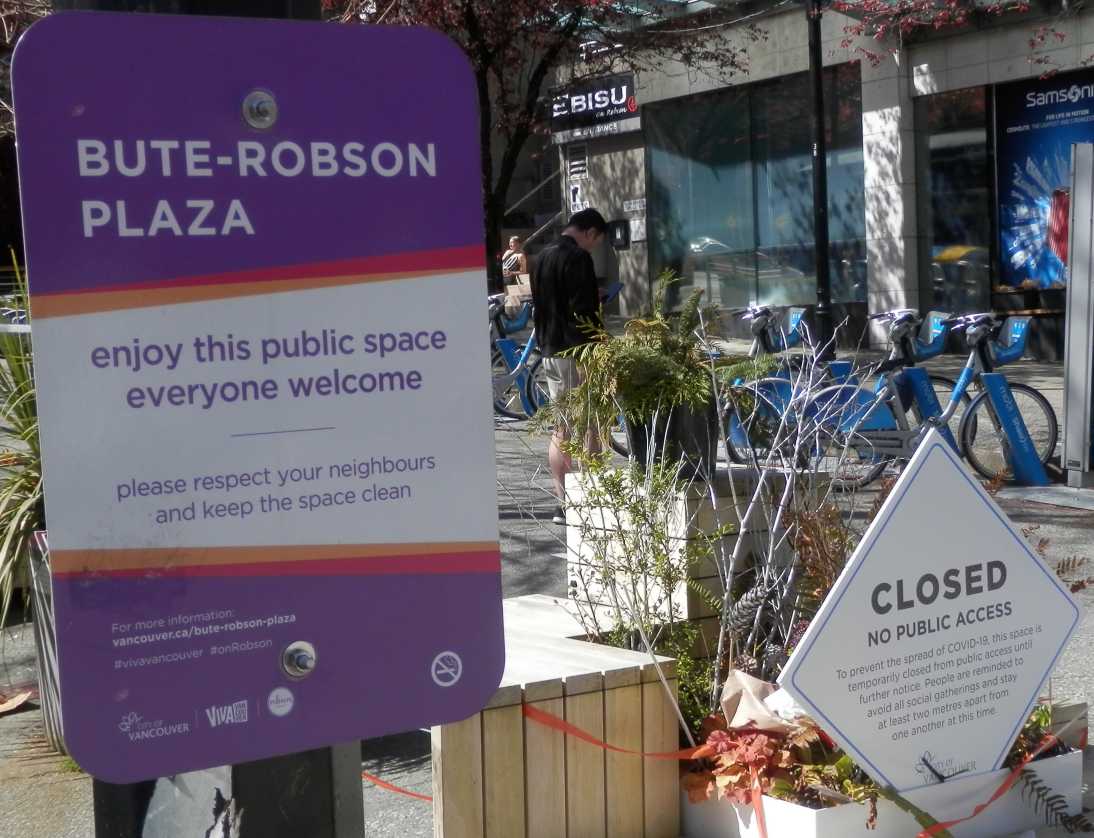
Conflicting Signage
APRIL 2: MY PRINTING PRESS FINALLY IDENTIFIED!
One of my earliest news items on this website was the 2004 purchase of a press,
that I wanted to use for making linocut relief prints. The only identifying mark on the
press was a cast diamond shape, with an indistinct logo or letter in the middle, which
could have been a C, D, G, S, or something else entirely like a hexagon. I looked online for a
mark like that, and also for presses, nipping presses, book presses, whatever I
could think of. No luck, so I gave up.
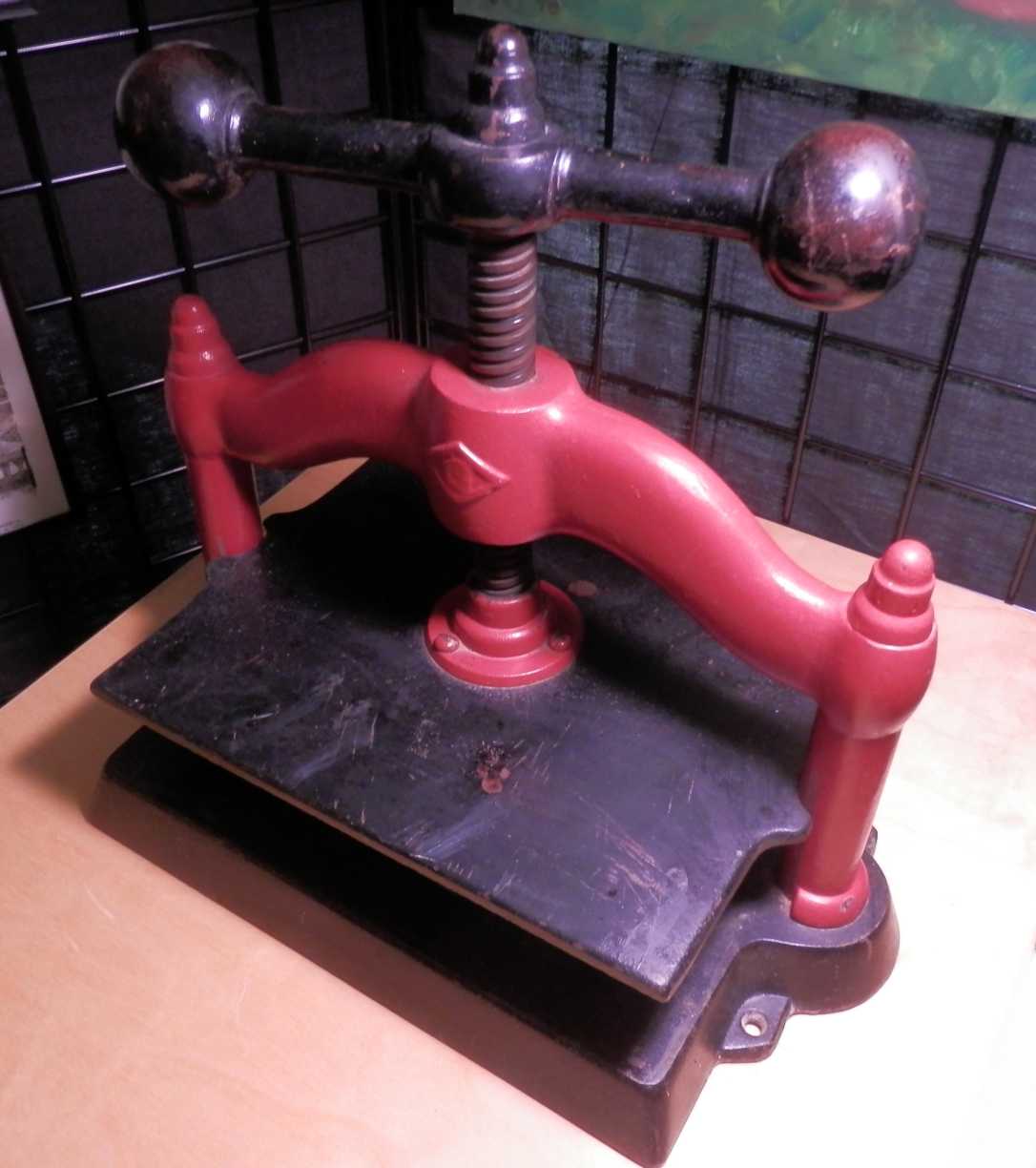
GILL Copying Press with "Diamond G" logo
This week, stuck at home self-isolating and trying to to keep myself safe from the virus,
I was washing my old family frying pan, and wondered about the manufacturer. The bottom
had the name SMART embossed on it, and BROCKVILLE ONT as well. In the middle of the
bottom is an embossed circle, with a diamond shape inside that, and an obscure letter
inside that, which I hadn't noticed before. So, I looked up the name online.
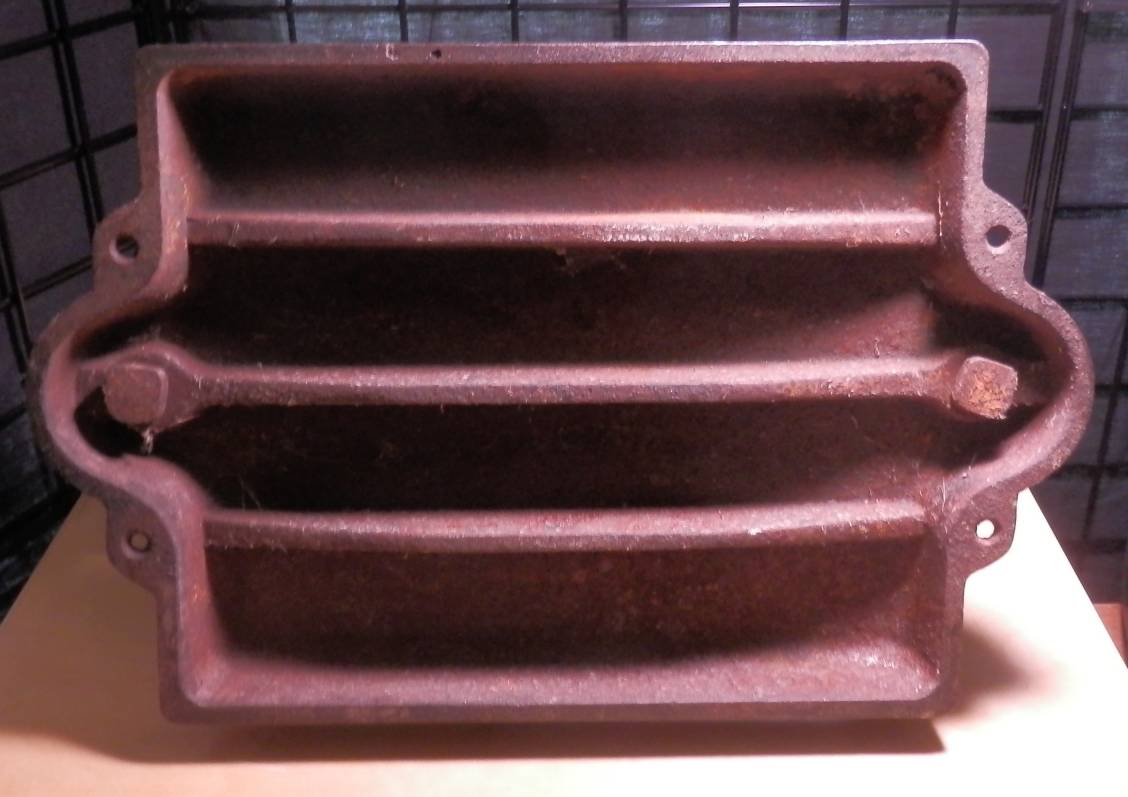
Underside of GILL Copying Press
An old Smart catalogue had been scanned and posted online, and showed a number of
presses similar to mine. It also turned out that the J. Smart company had acquired
the Gill Manufacturing Company
in 1888. The Gill logo was a diamond with a "G" in the middle, matching the logos
on the press and the frying pan. So, that solved the
mystery of WHO made the press, but didn't provide a date. Gill was in business for many
years before being bought out, so the press could have been made any time up until
1912 when J. Smart discontinued the Diamond-G logo. Made in Canada, and still in
perfect working order. Smart made a lot of different series
of frying pans, but not that many of them seem to have wood handles. The number 9
refers to the diameter of the flat bottom of the frying pan.
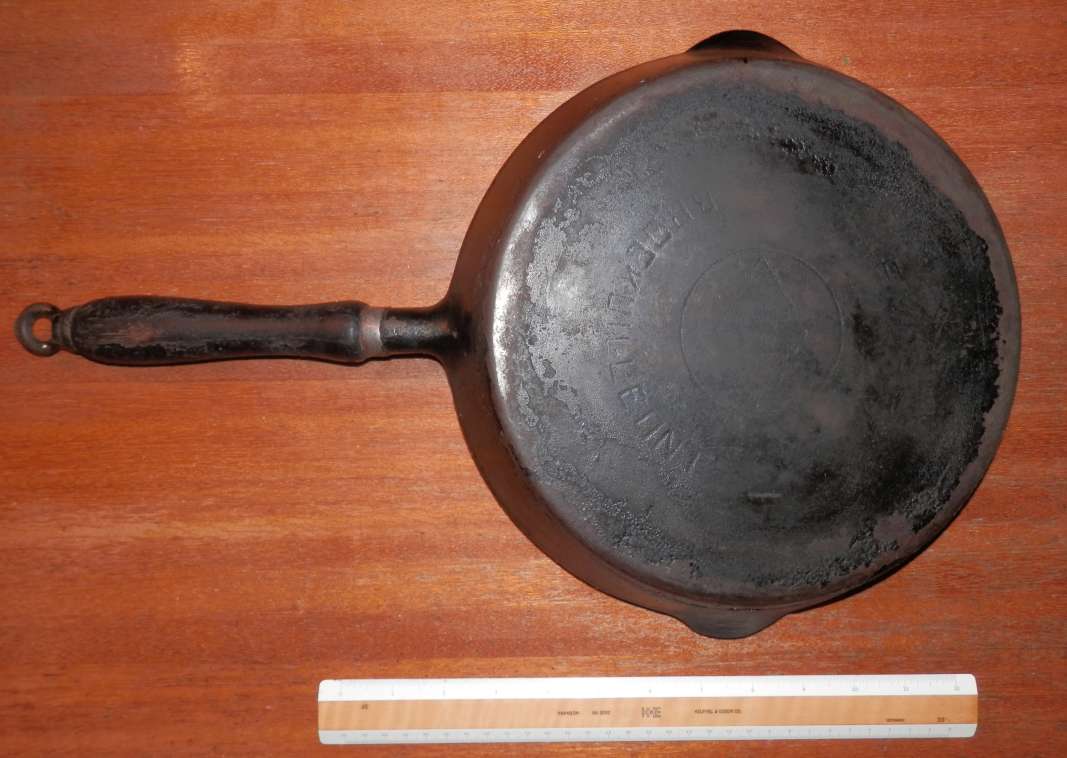
Underside of J. Smart #9 frying pan with 12" rule
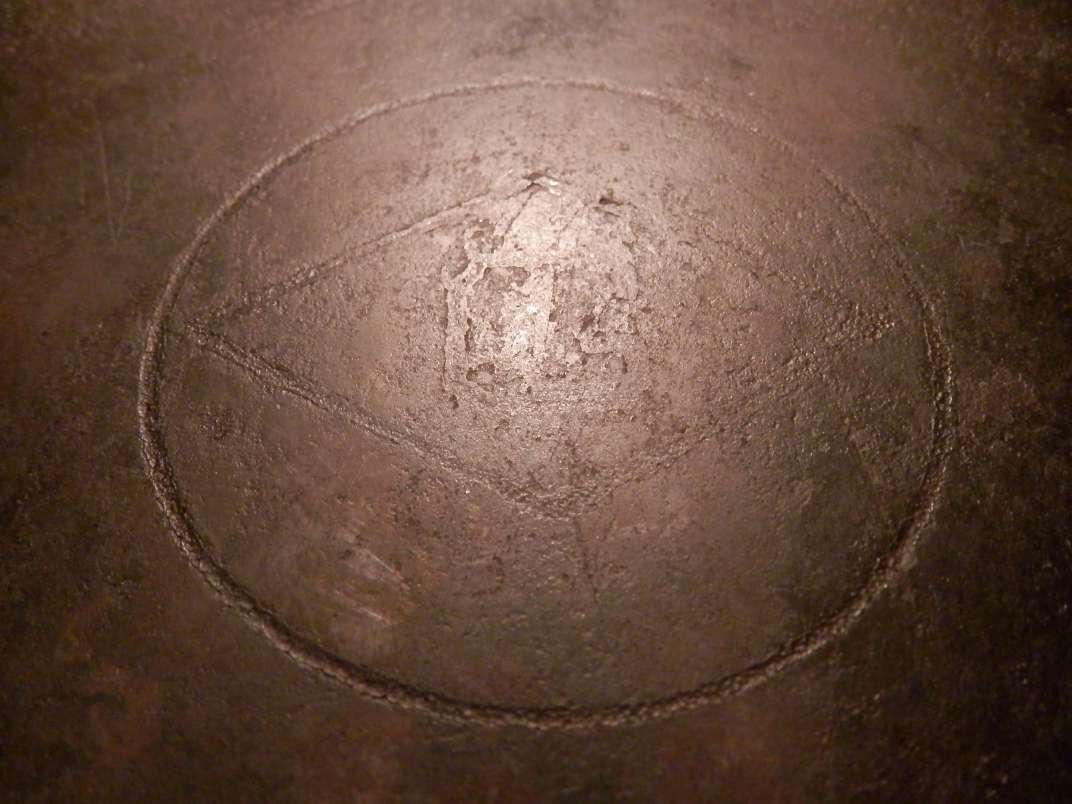
Detail - underside of J. Smart #9 frying pan with Diamond G logo
It's funny in a way, I've had the frying pan for about 50 years, but it was in
my family long before that. I've cooked many meals with it, including the chili
I whomped up last week. Since I acquired the copying press I have made well over
1,000 impressions with it, it performs perfectly and reliably, just like the
frying pan.
FEB. 28 2019: CLOSURE OF THE CHOCOLATE MOUSSE
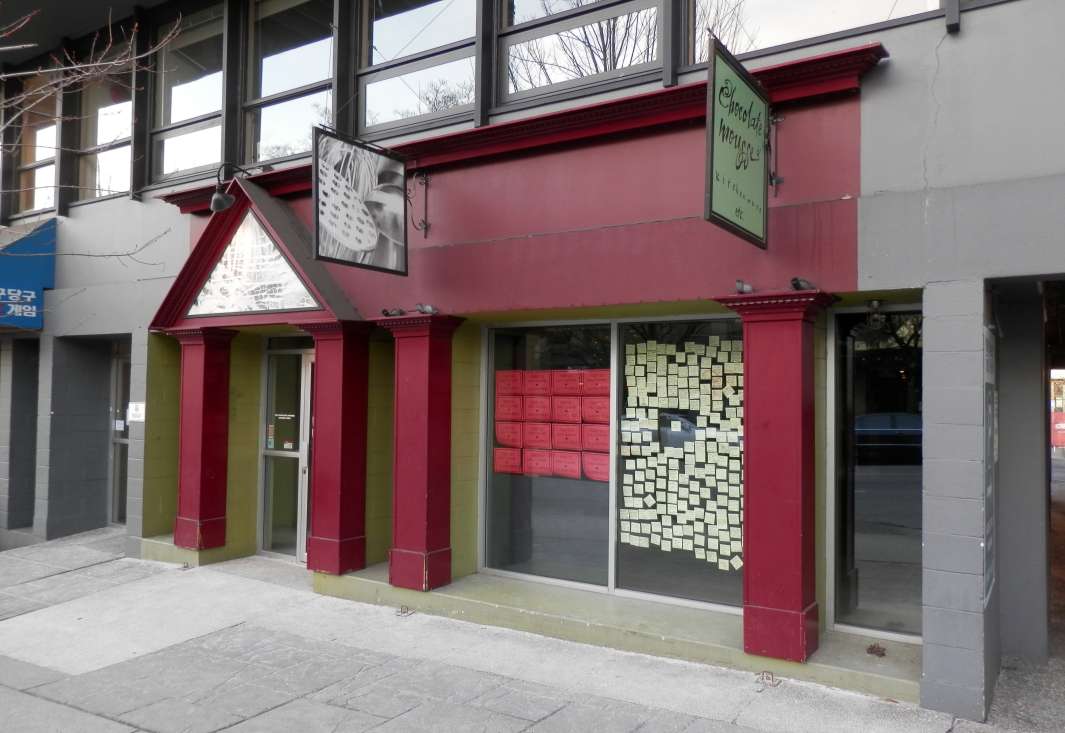
Farewell to the Chocolate Mousse 2019
UPDATE: Three and a half years later, November 2022, this building continues to
sit empty and unoccupied. Nice work, whoever kicked out the tenants. I hope you lose all
of your money!
SECOND UPDATE: FIVE YEARS LATER the building is still intact, and a sign on the
exterior is advertising spaces for lease up to 3,000 s.f. Owners like that should be
tarred and feathered and run out of town. In their utter greed all they have managed to
do is blight an otherwise interesting and useful half-block of Robson Street, and
destroyed a wonderful business.
APRIL 1 2016: PART OF SHERMAN LIBRARY SURFACES

Although trying not to spend money on books and art I was enticed to
purchase a small collection of old books that came from the Sherman
family library. A "picker" brought them in to Macleod's Books, and the
owner called to offer them to me. The source of the books was apparently
an estate sale somewhere in Vancouver. I went over and bought all but
one of them, an expensive first edition of Kim by Kipling. The
others are all signed or with bookplates from
Maud Sherman and her
father Ruyter Sherman, and include a Canadian
first edition of Puck of Pook's Hill printed in 1906.
All of the book titles are noted in the Diary of Maud Rees Sherman,
where Maud made a list of over 120 books in their family library, and another
long list of her favorite books and stories. A few months after transcribing
the lists from the donated diary, some of the actual books appeared on
my bookshelf.
JUNE 15 2015: GEORGINA POINT, MAYNE ISLAND
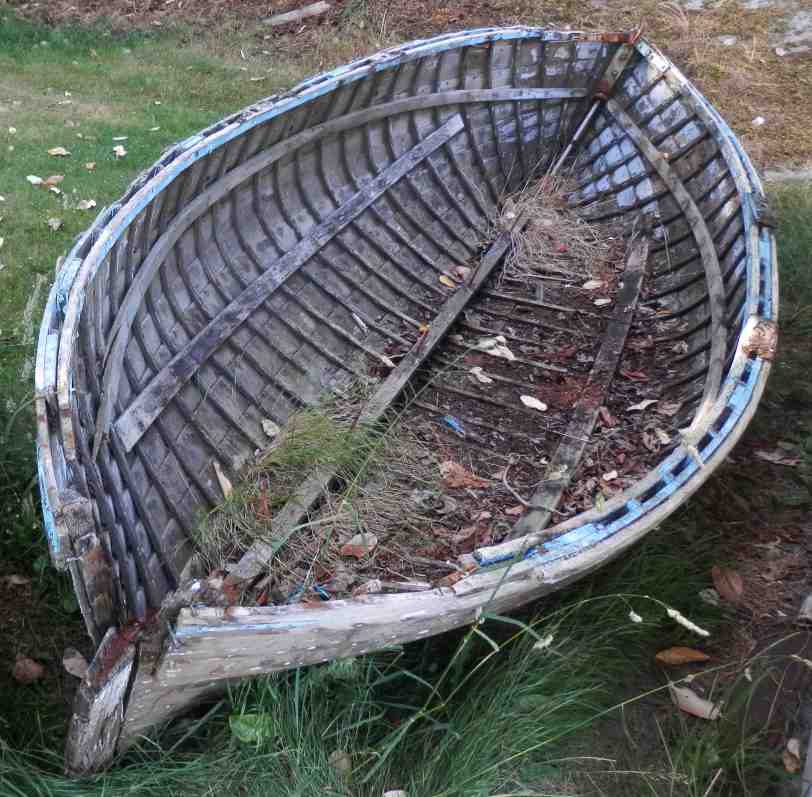
Old Lifeboat, Georgina Point
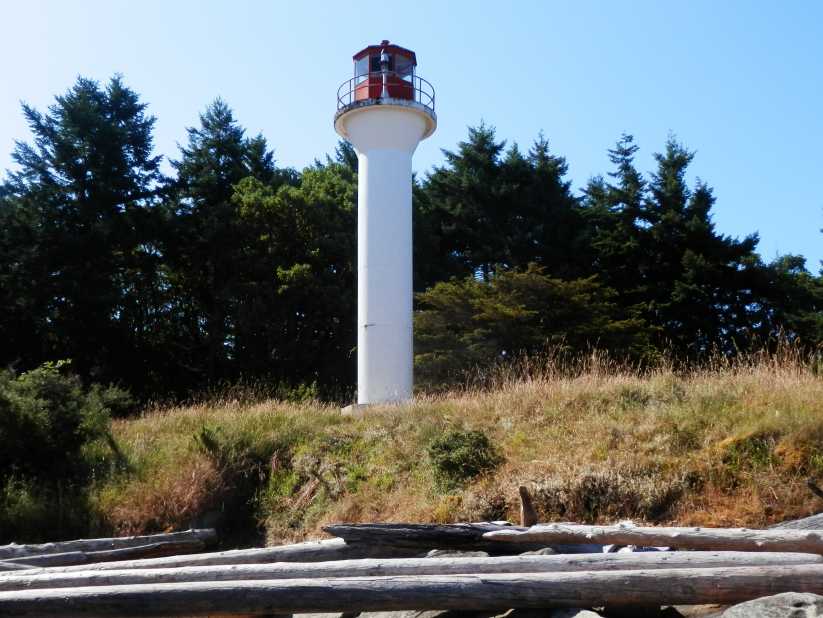
Lighthouse, Georgina Point
I had a vacation on Mayne Island in 2015, and one day walked to Georgina Point, at
the east entrance to Active Pass. The lighthouse was built in 1885, and was
accompanied by a lifeboat station. See also Mayne Island
for more pictures from this trip.
JUNE 9 2013: JOHN KOERNER CELEBRATION AT BURNABY ART GALLERY
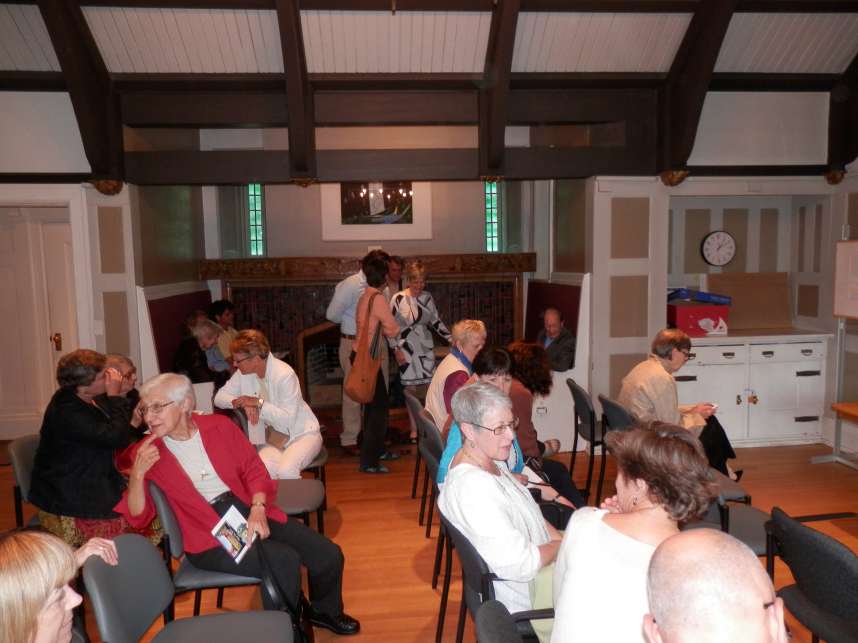
In the Fireside Room, Burnaby Art Gallery
A celebration of the art and life of artist John Koerner
was held at the Burnaby Art Gallery on June 9th, in conjunction with the launch of
a new book and a panel discussion. Afterwards a catered reception was held on the
gallery's large porch.
Continued at JOHN KOERNER CELEBRATION.
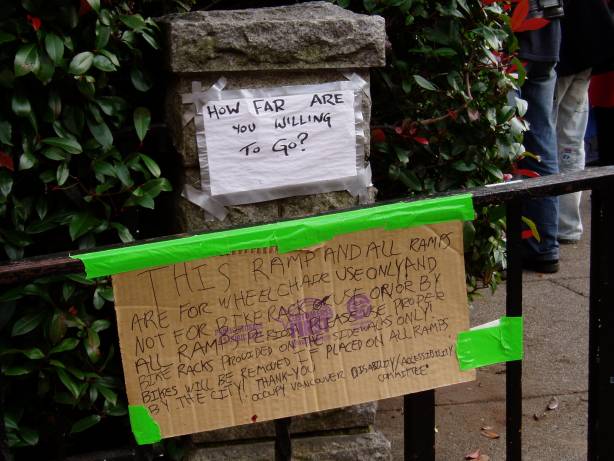
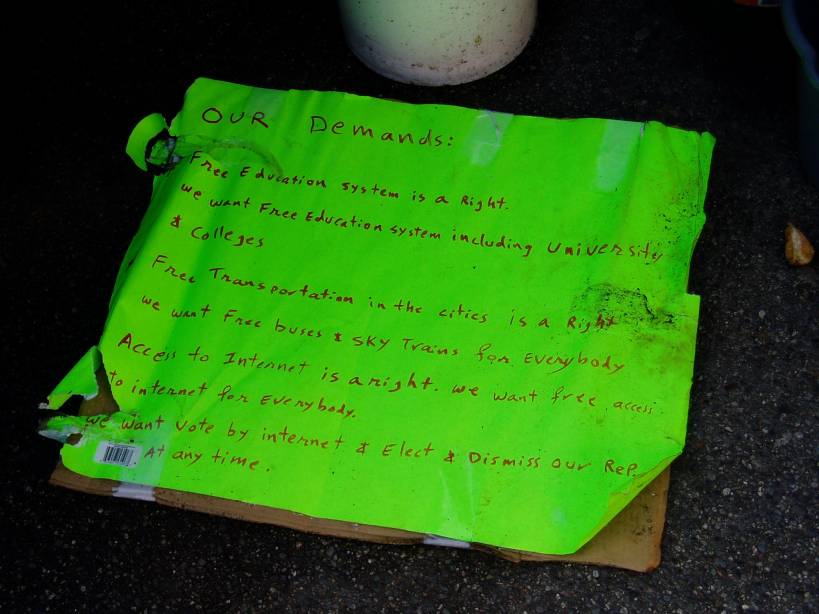
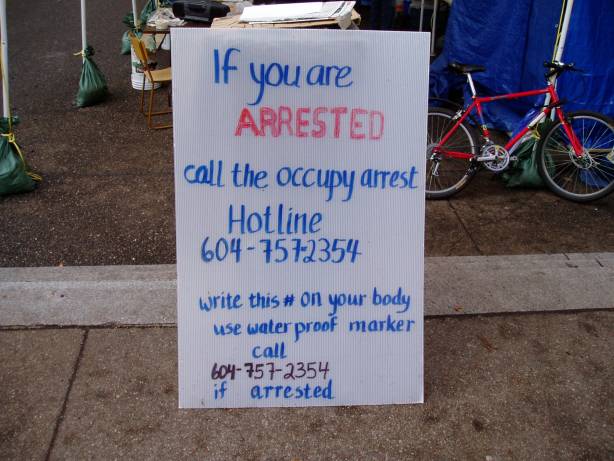
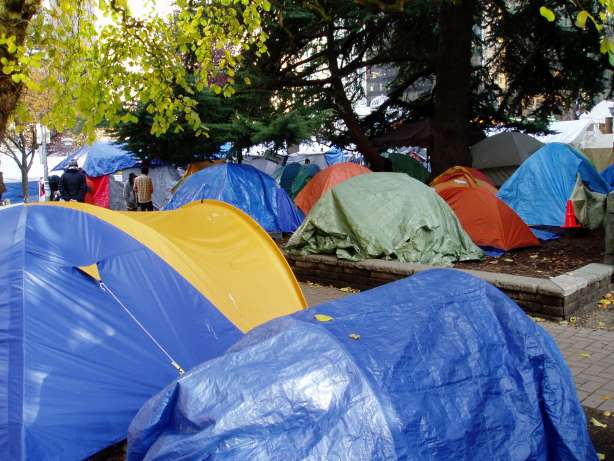
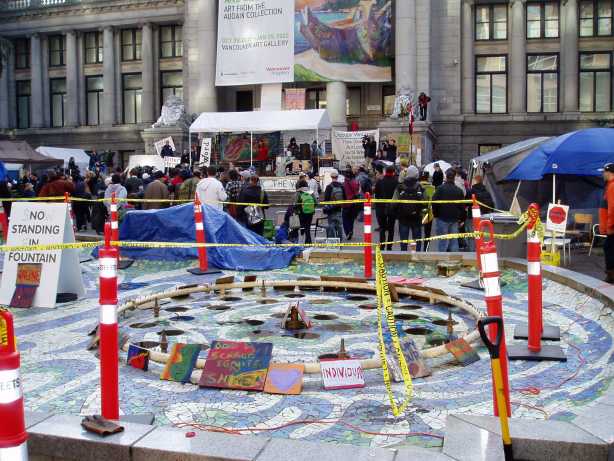
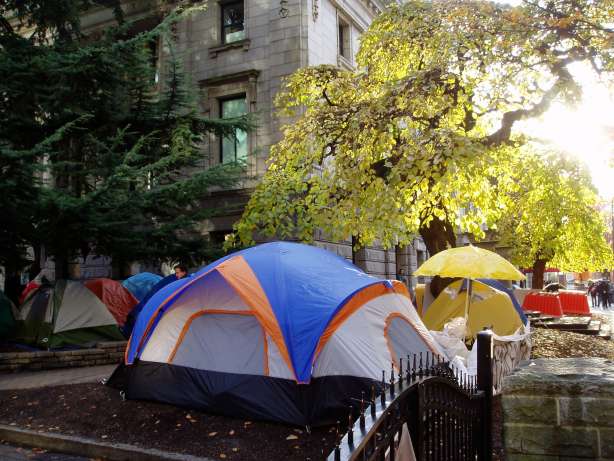
Browsing through some digital photos from 2011, I came across
a few that I'd taken one day at the Art Gallery on Georgia Street,
wandering through the OCCUPY VANCOUVER encampment. The camp was
quite neat and tidy, but my visit was after the first "crackdown" by
city officials to make the campers provide clear access to all tents
"in case of emergency" ...
Signage was much in evidence throughout the encampment. The sign
taped to the handrail was a bit ironic, it admonished people not to
lock their bikes to the handrail, it was for the use of handicap people
only. The sign was taped to the top rail in a way that would actually
impair "graspability" and would have better been attached lower down.
Regardless of that kind of nit-picking, I did have to admire the
spirit and conviction of those who were protesting. The encampment
had the air of a 1960s be-in, with the same common belief
that people joining together to help each other out is a good thing.
I did have to chuckle a bit at one of the demands on a sign being
"access to the Internet is a right" as the Internet is a
relatively new-fangled thing that we didn't have back in the 1960s.
Some strange events have rolled through this part of town in the
past while ... the 2010 Olympics ... the 2011 hockey riot ...
OCCUPY VANCOUVER ... what's next?
Home
Copyright 2022









































































































